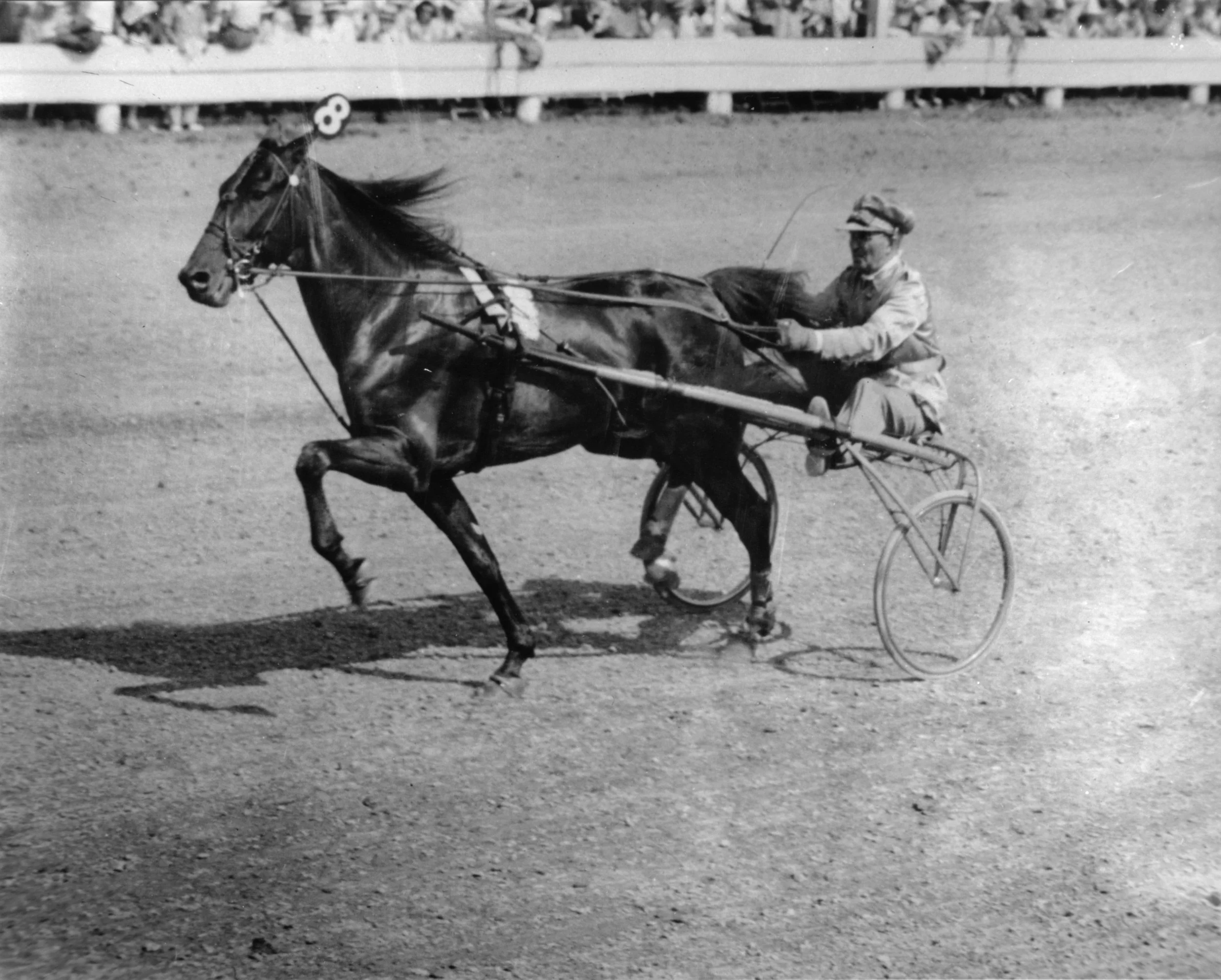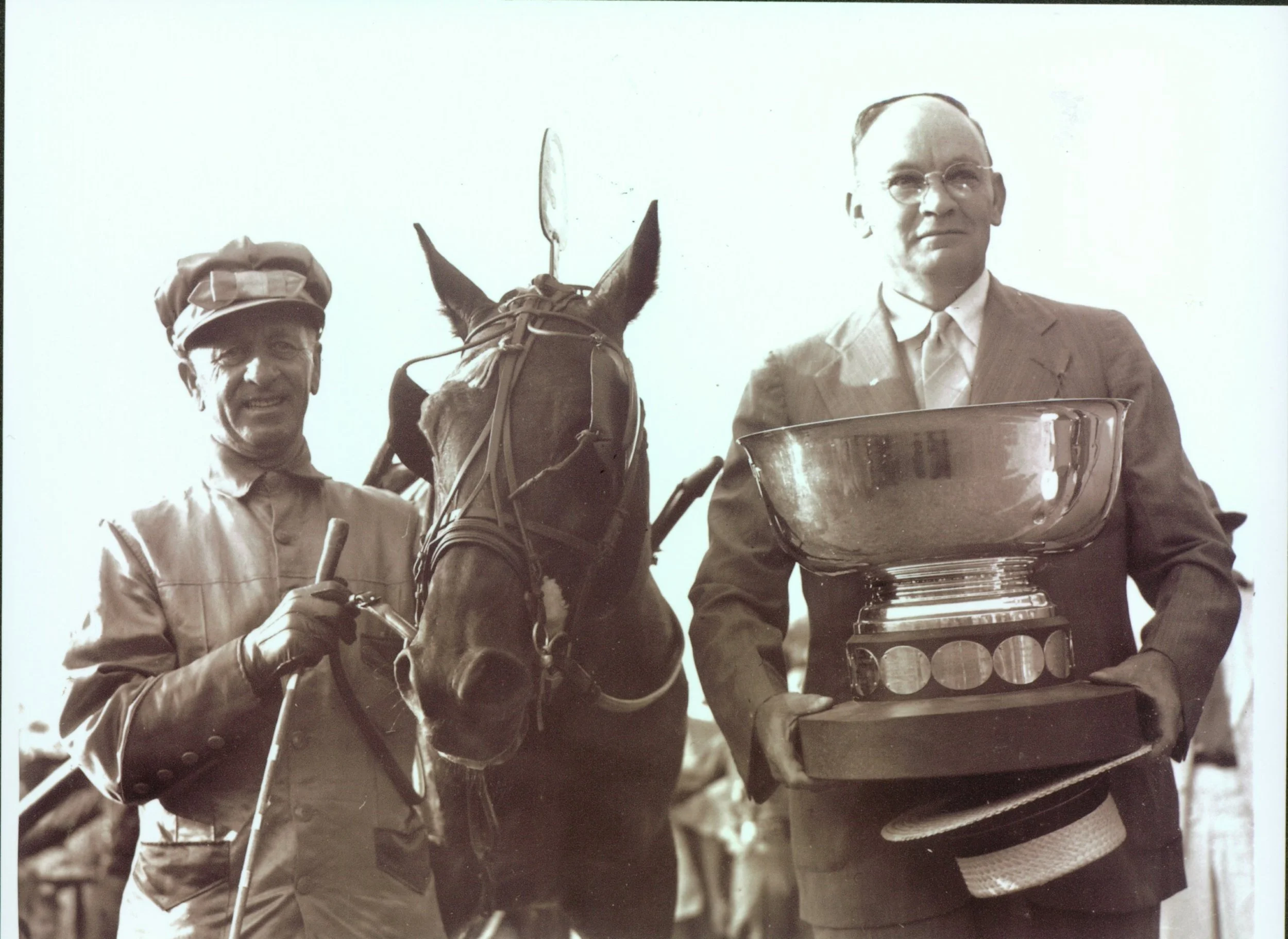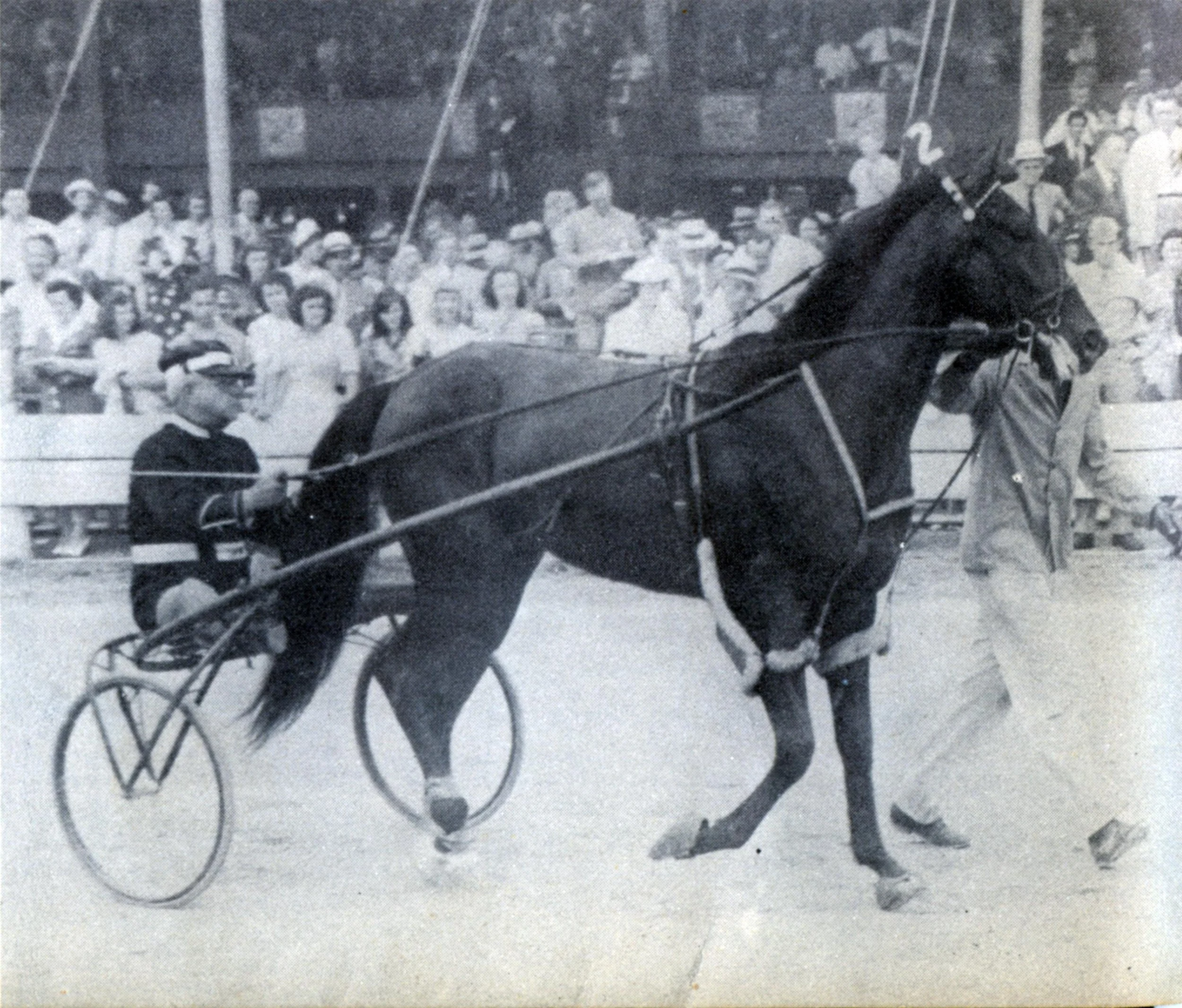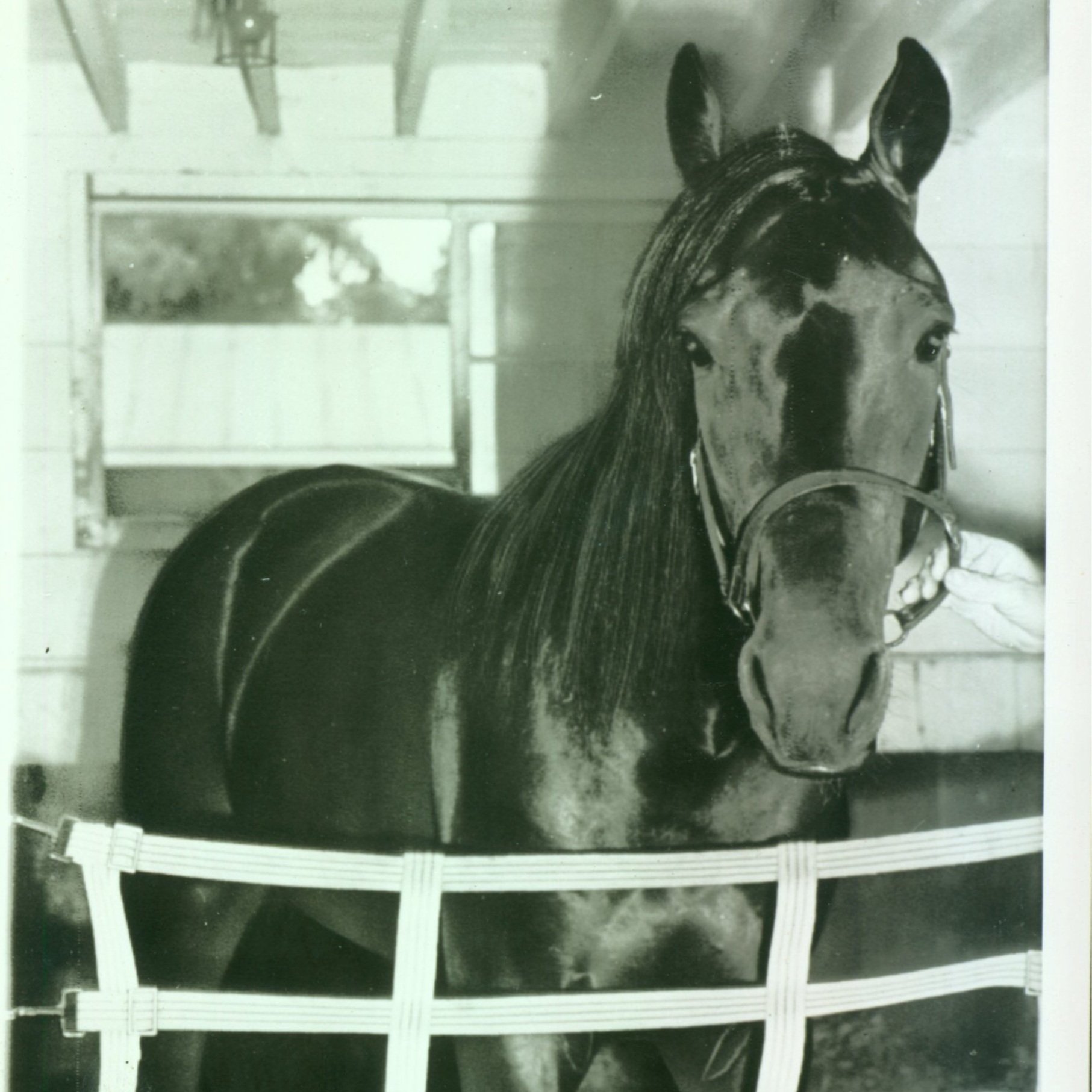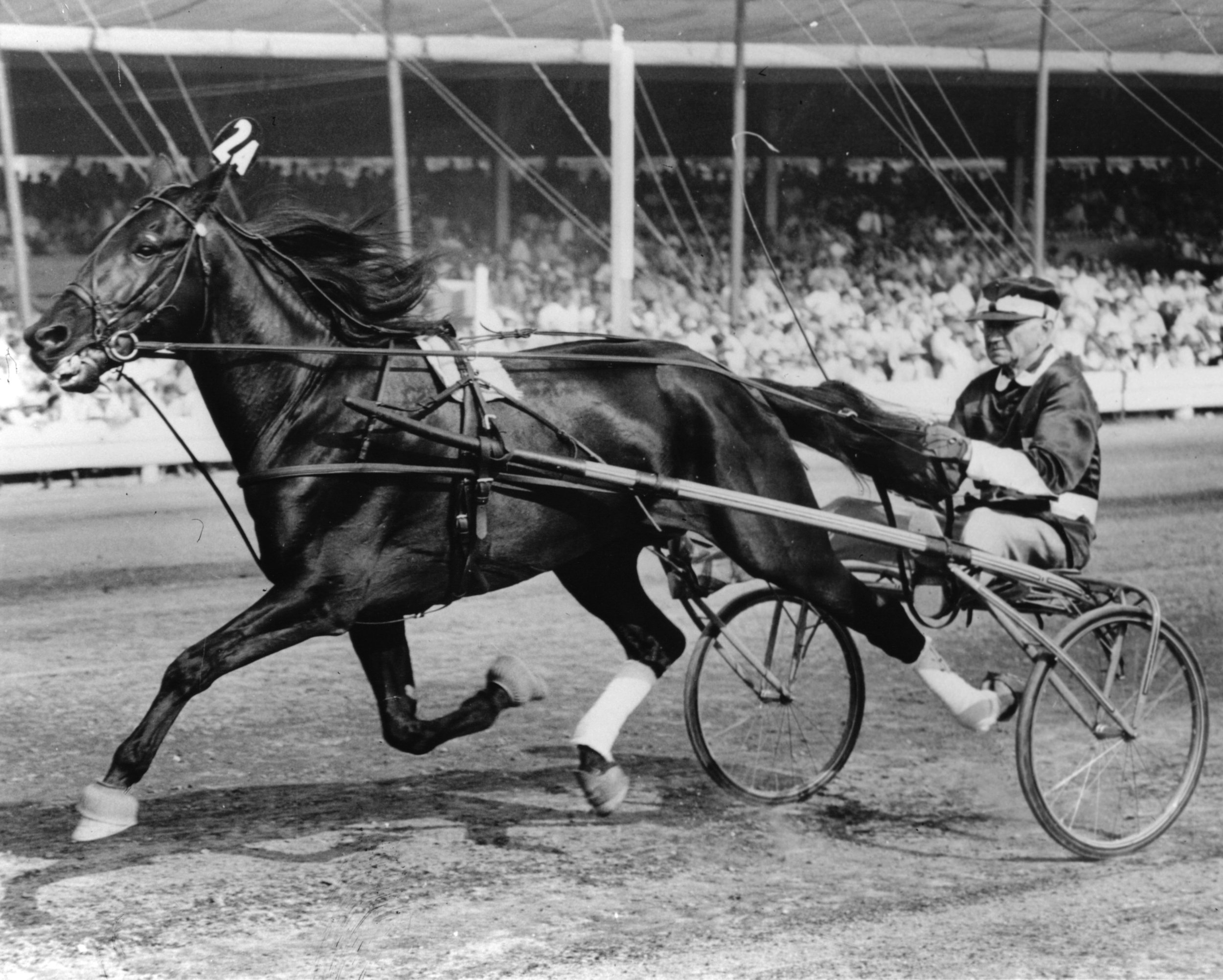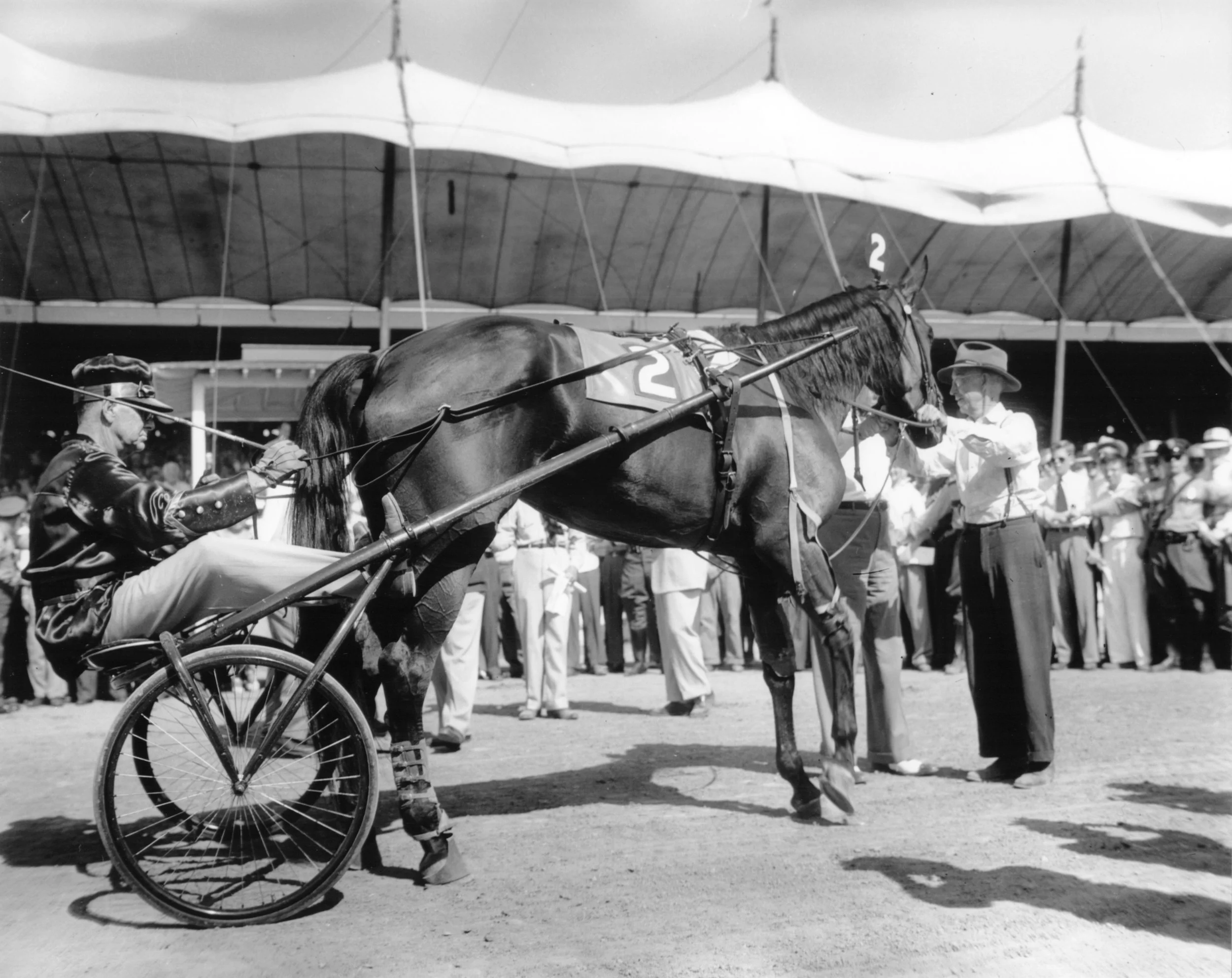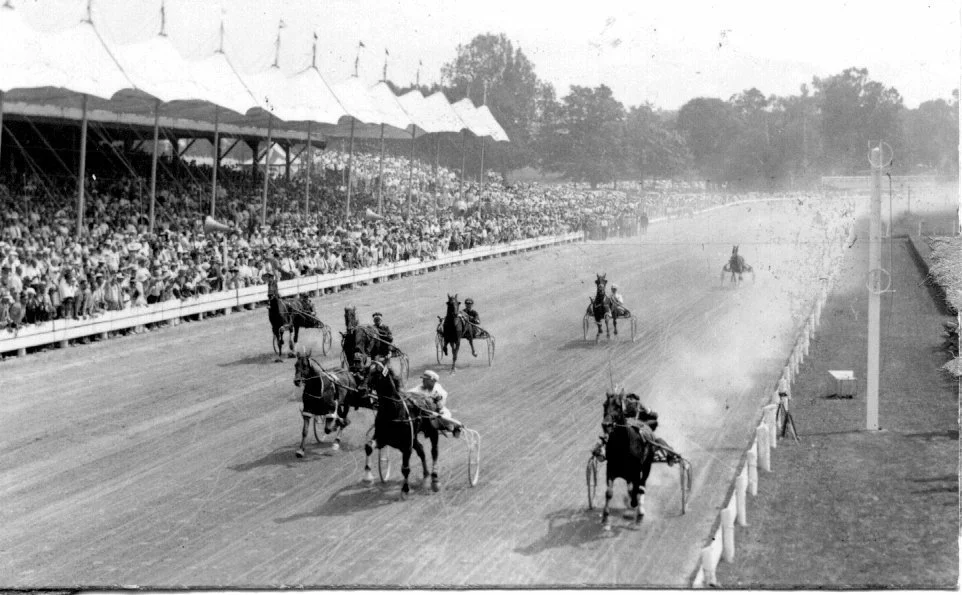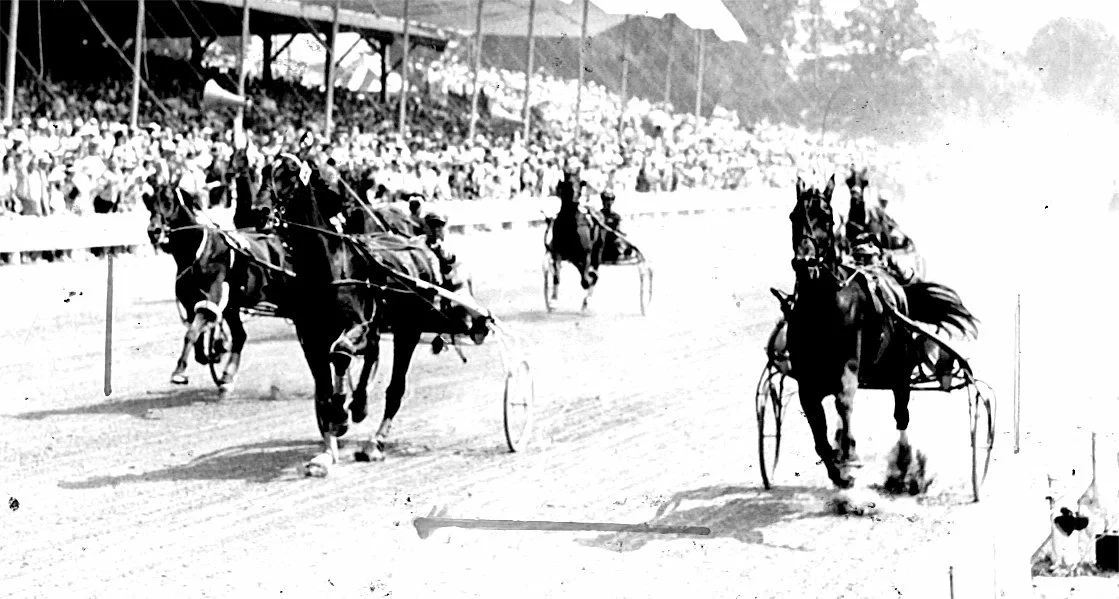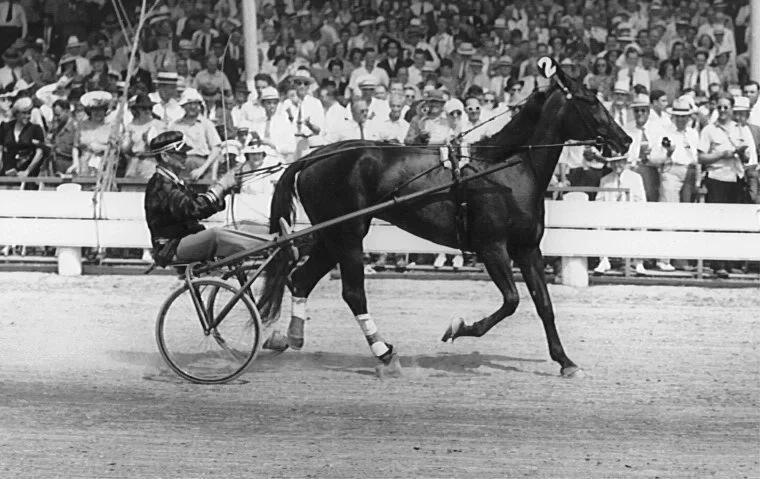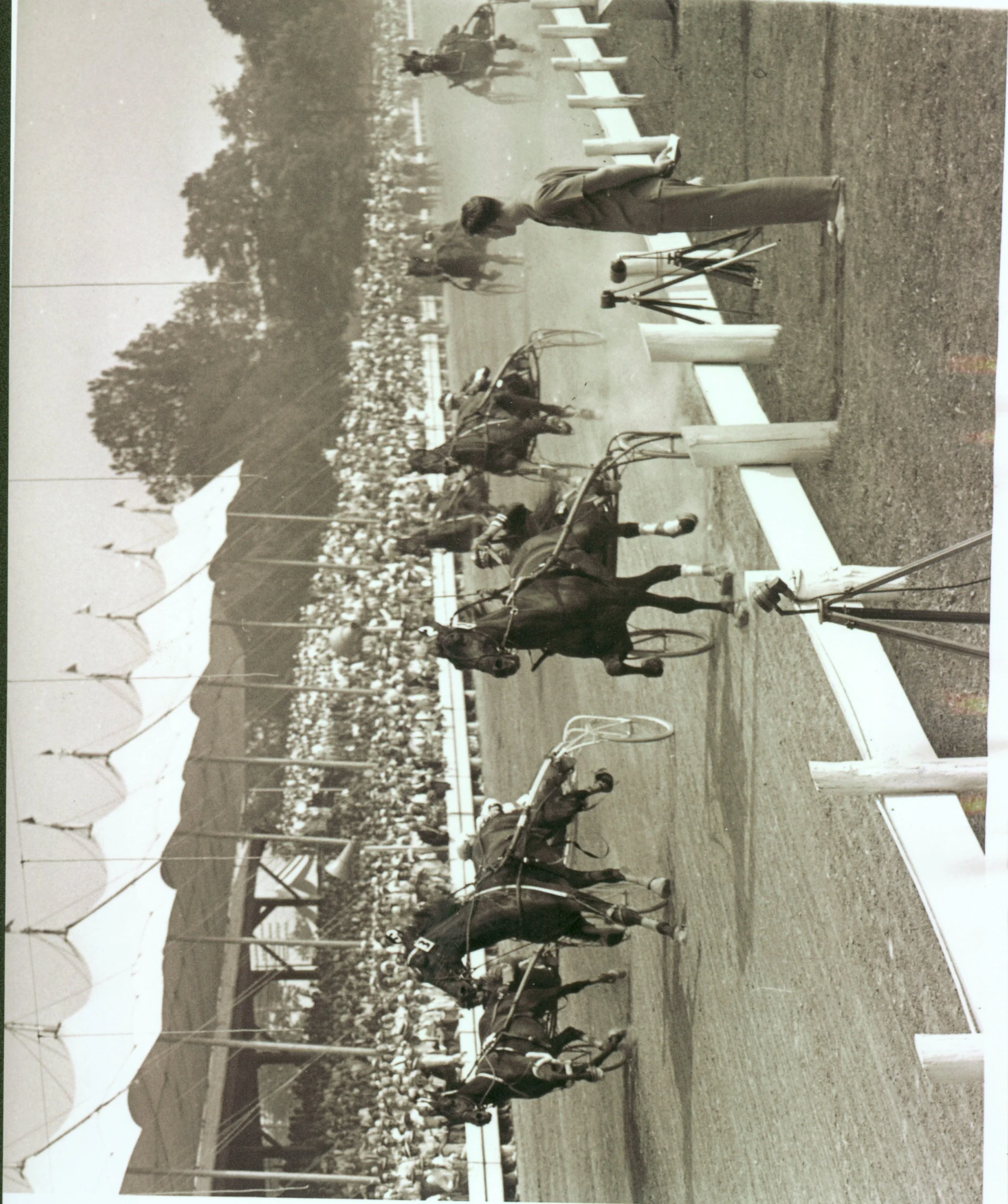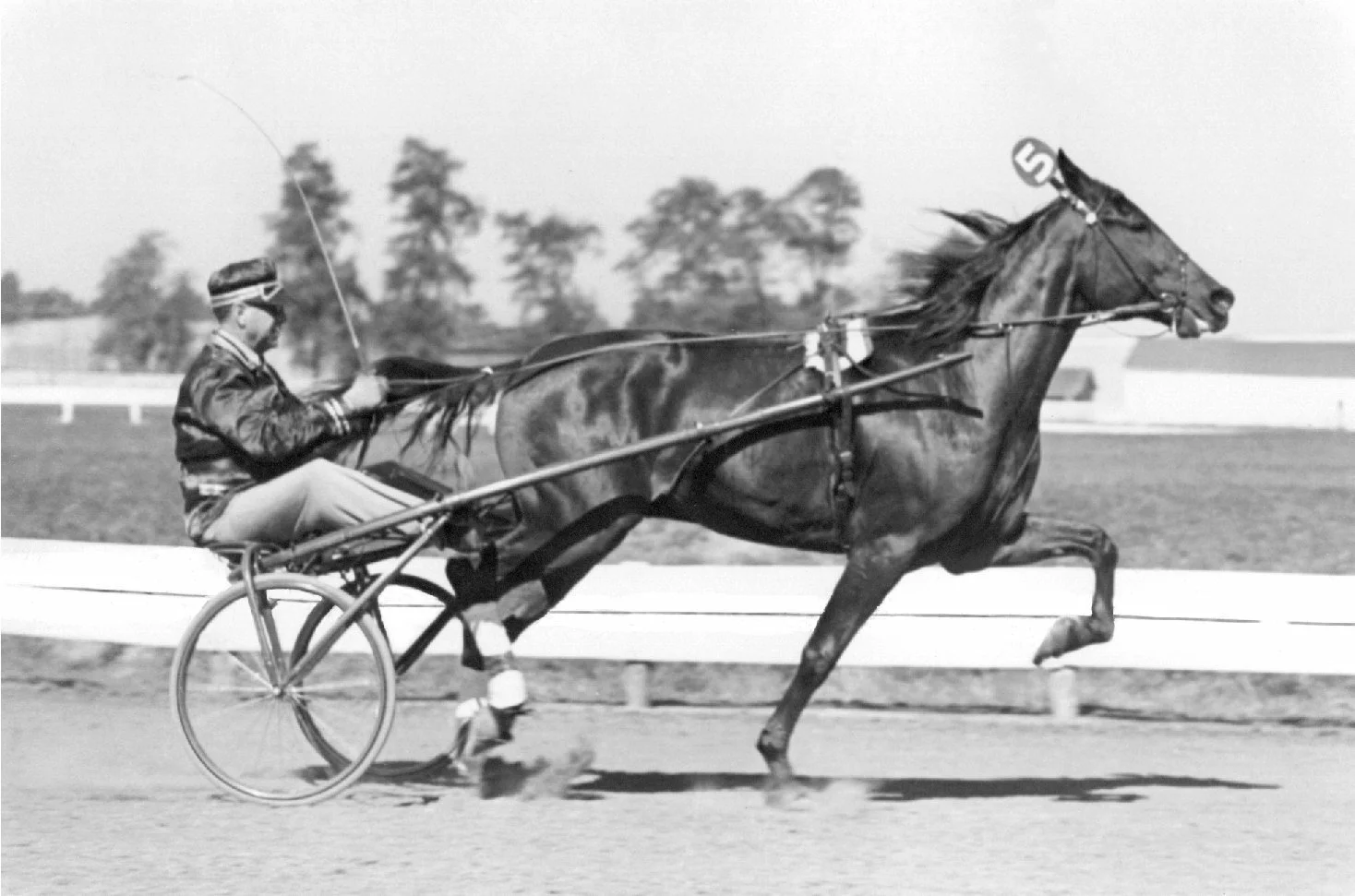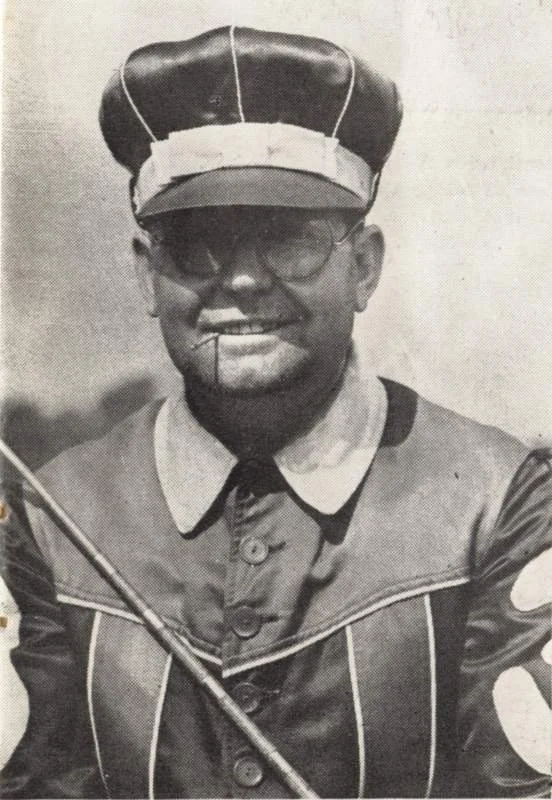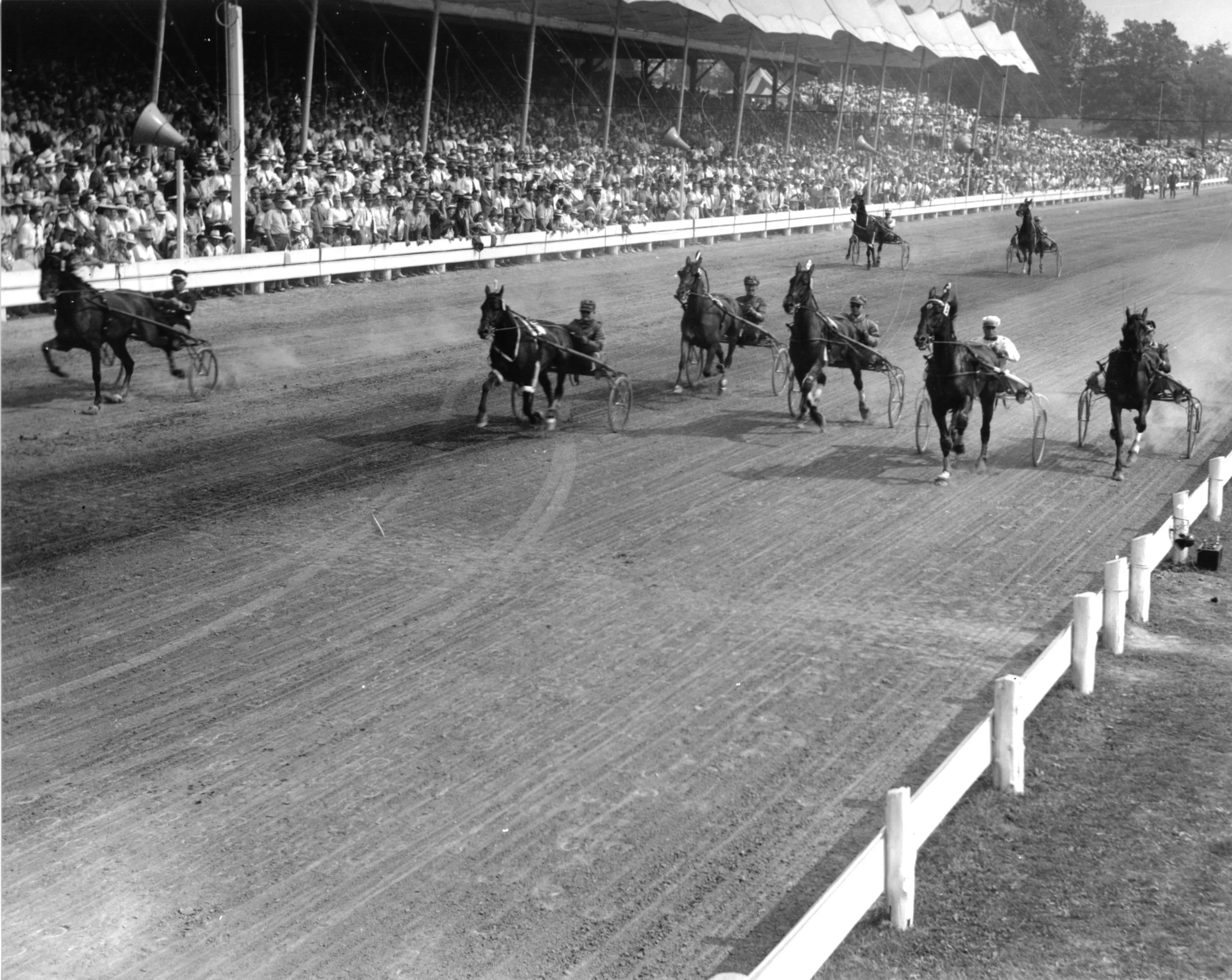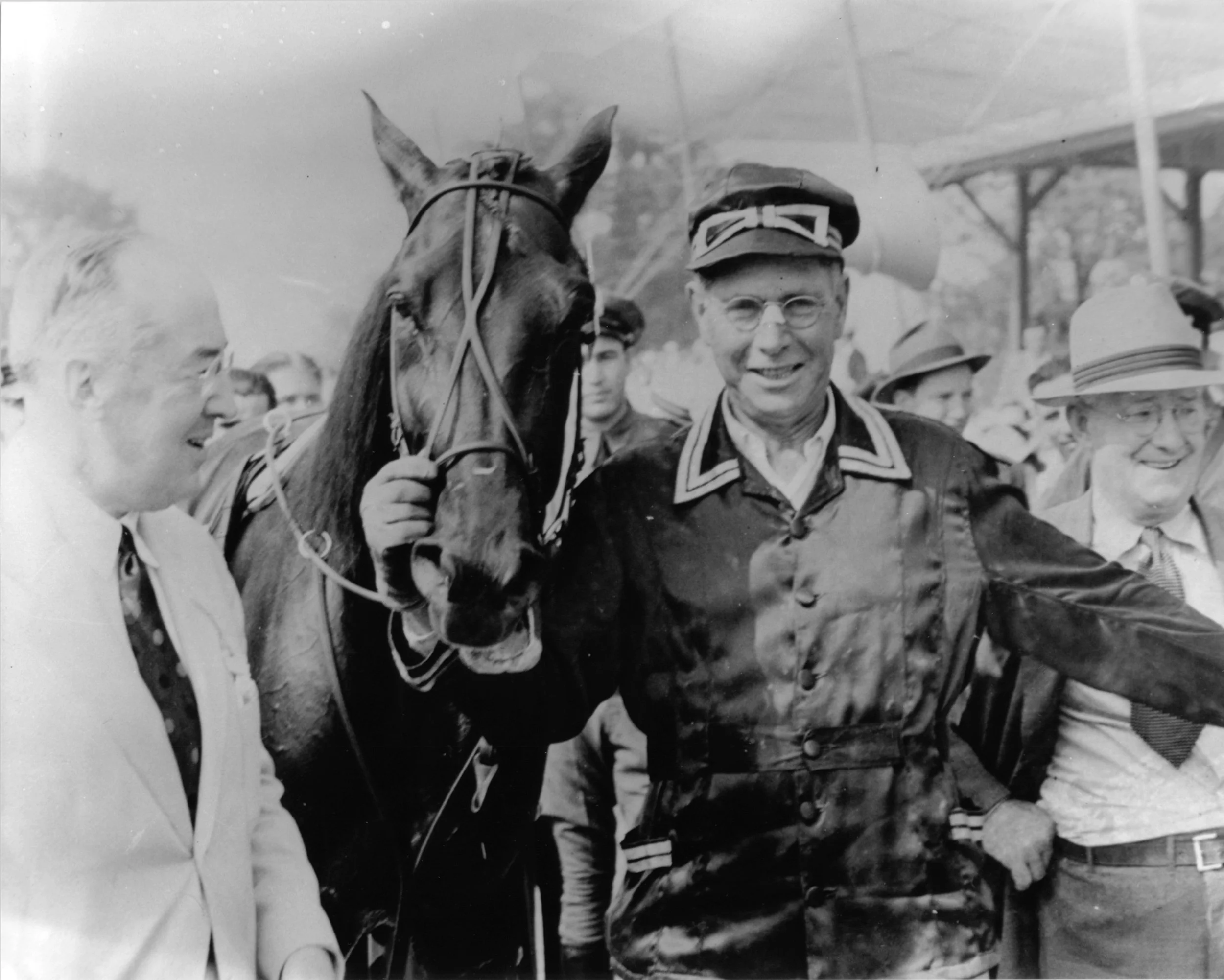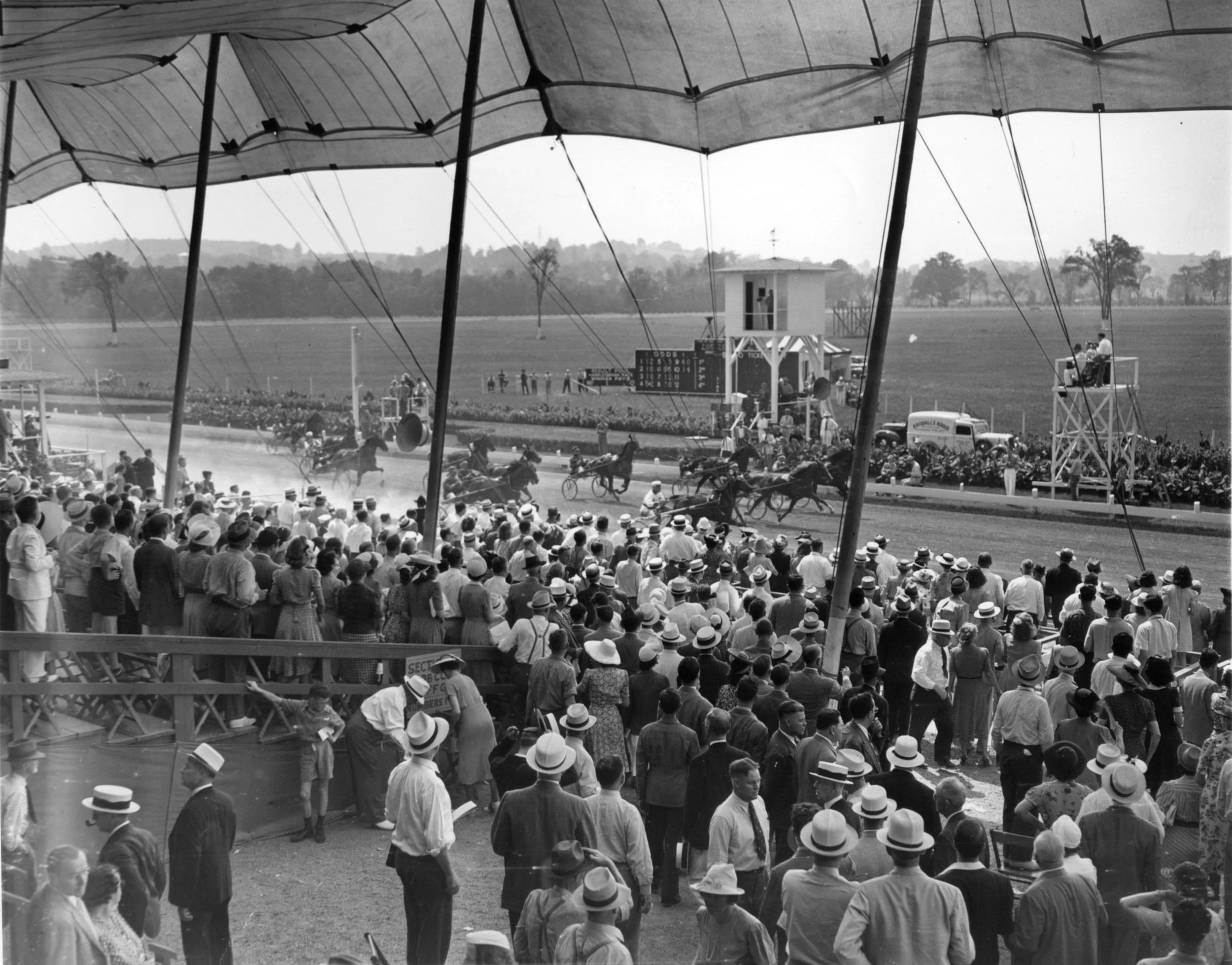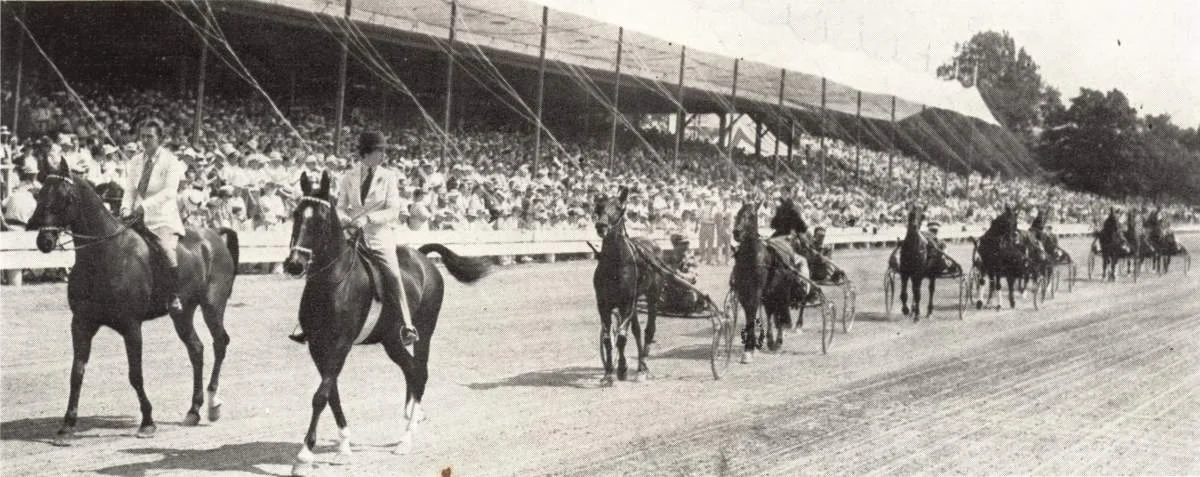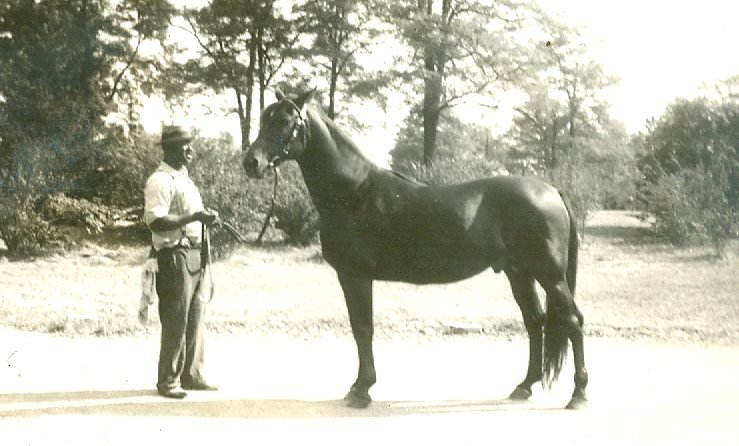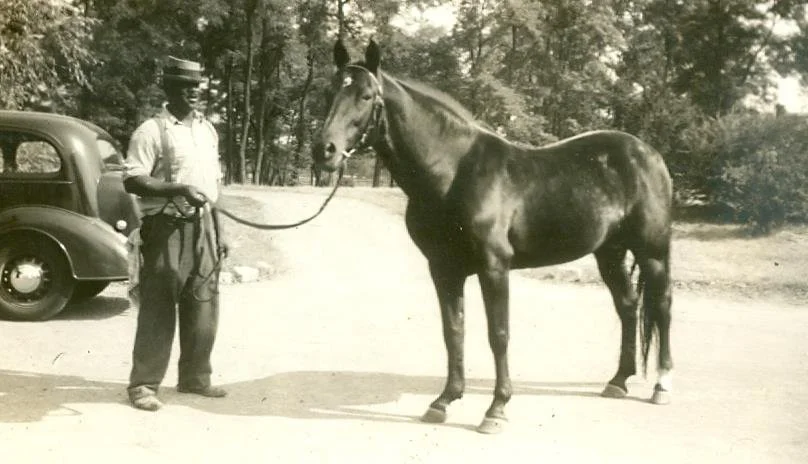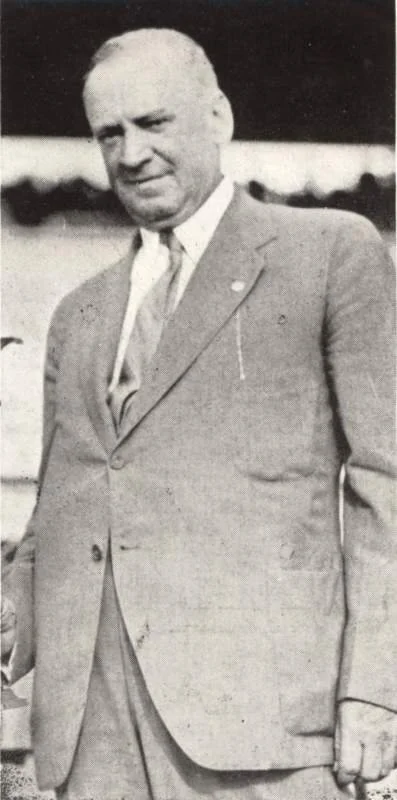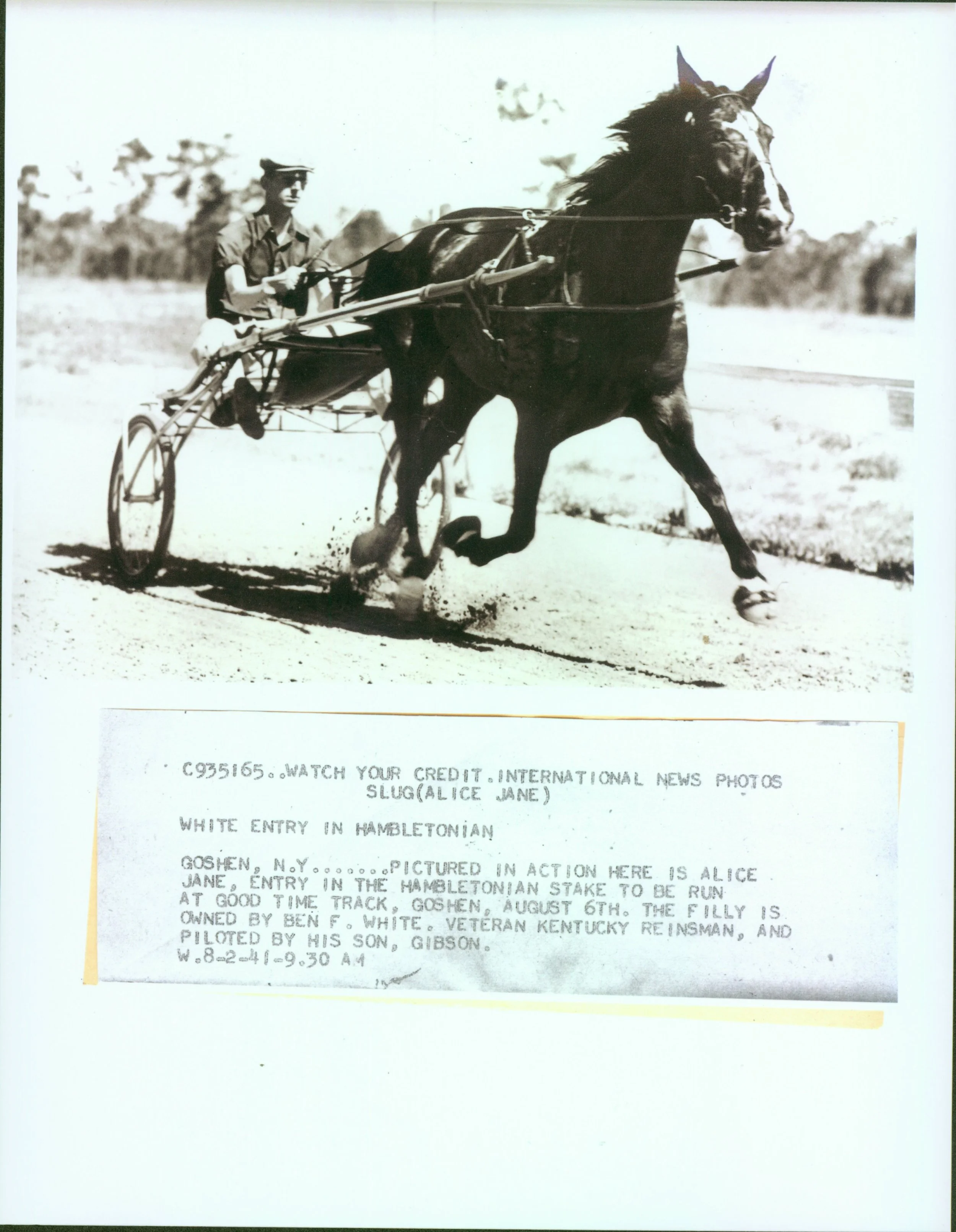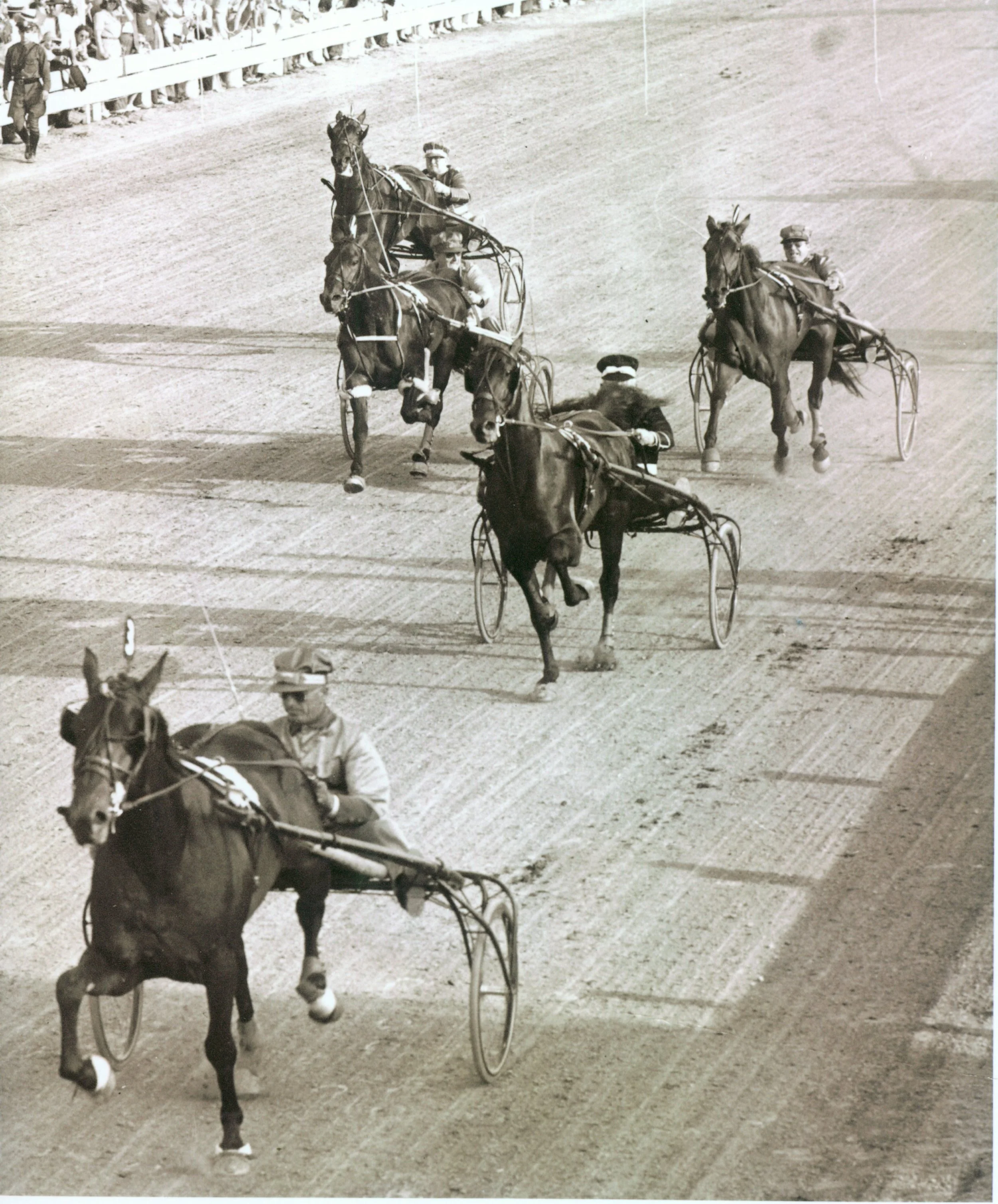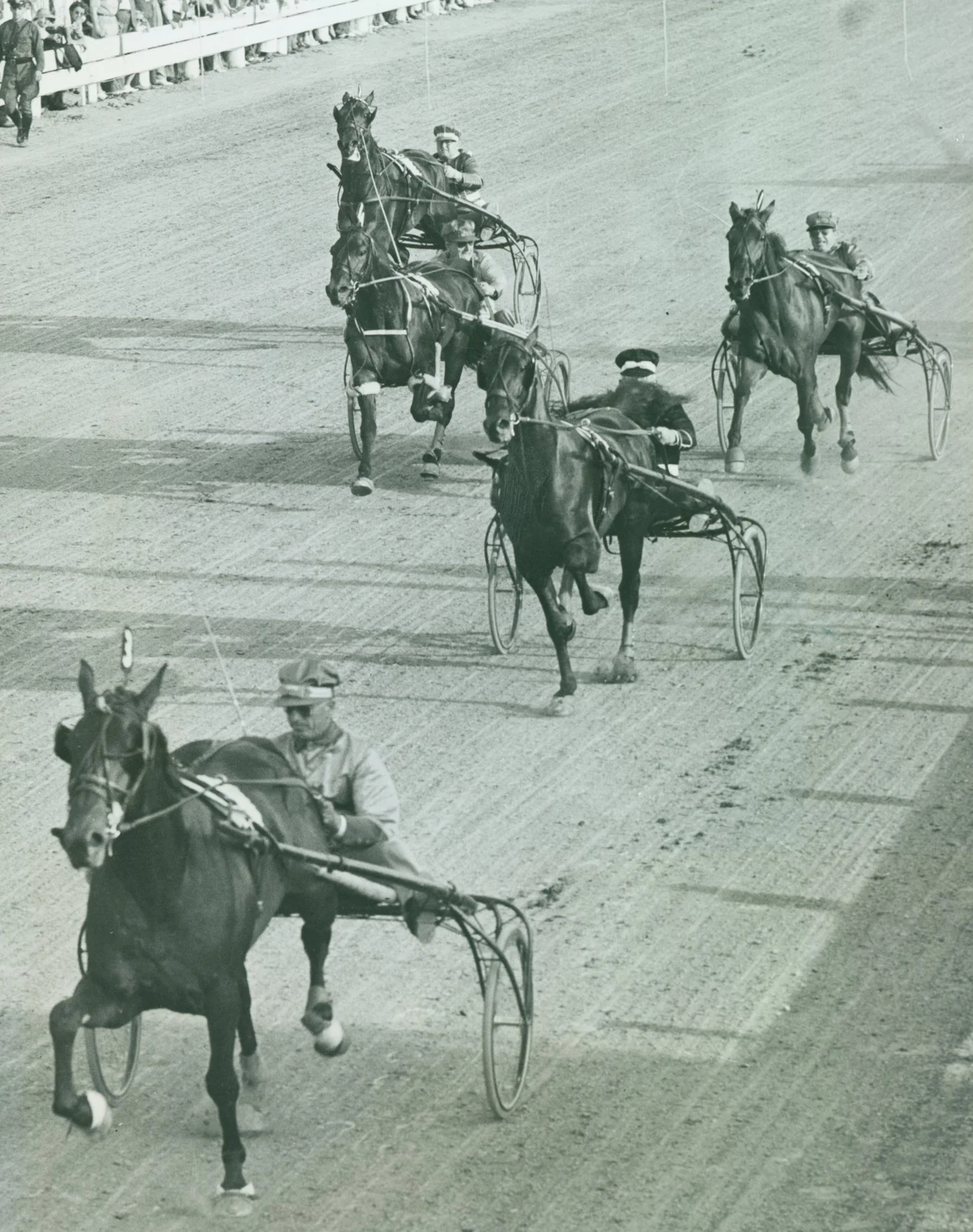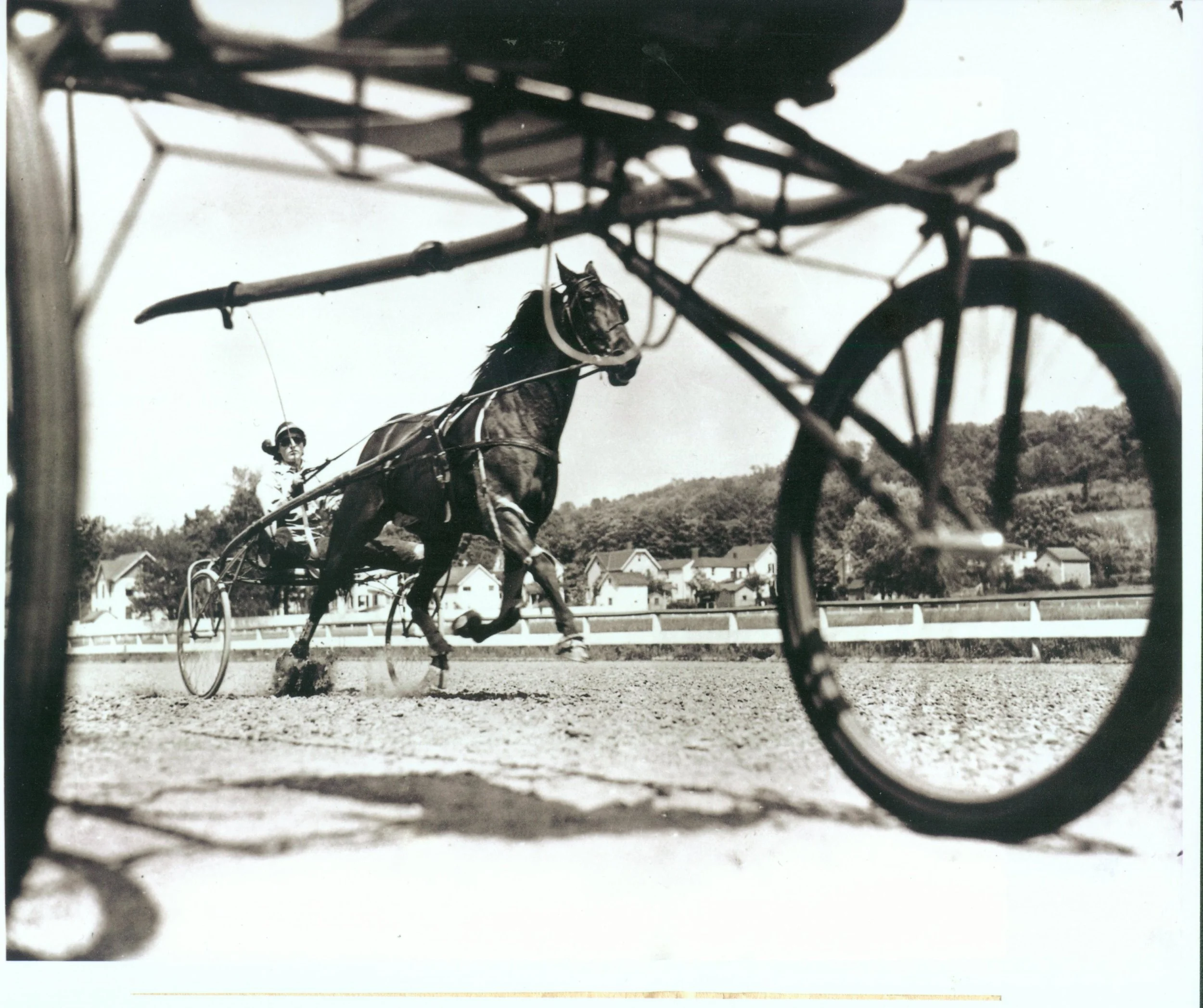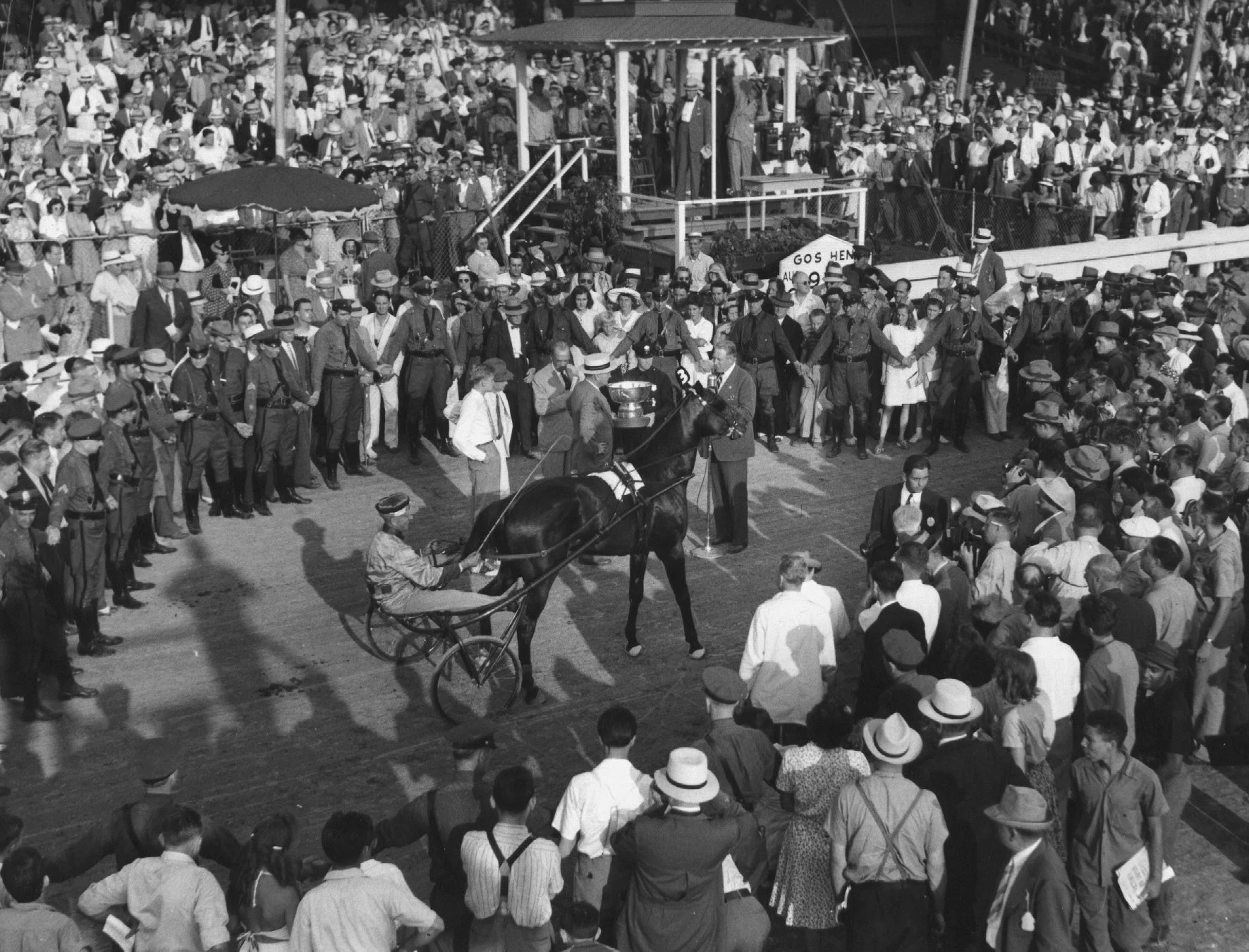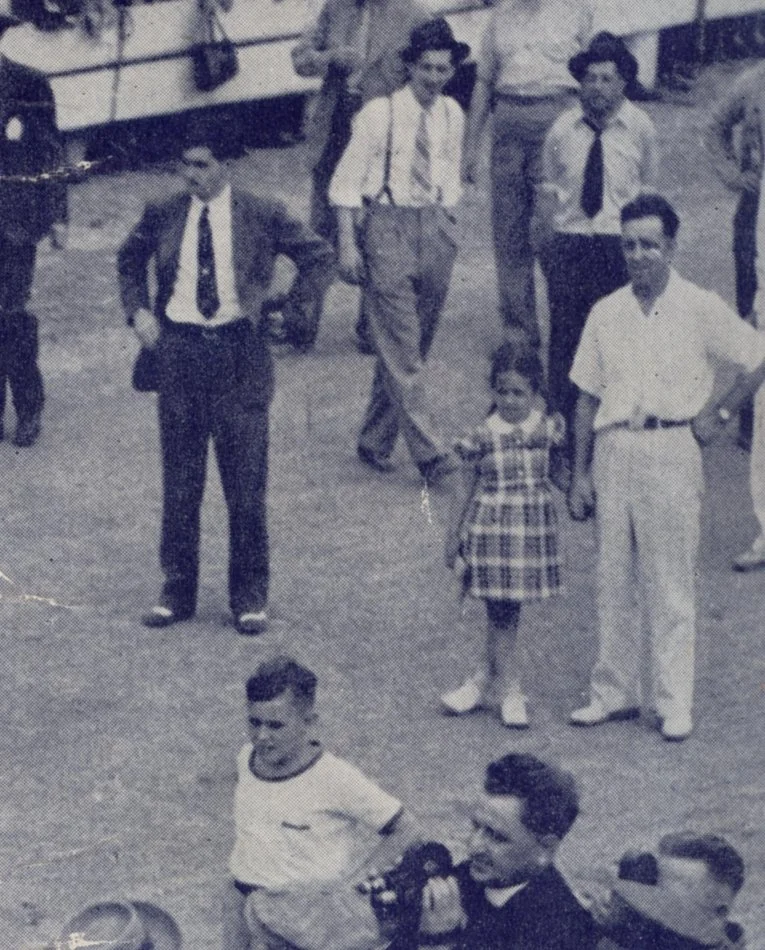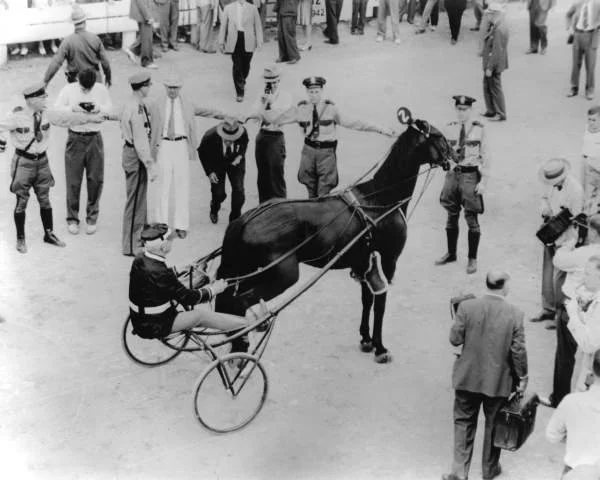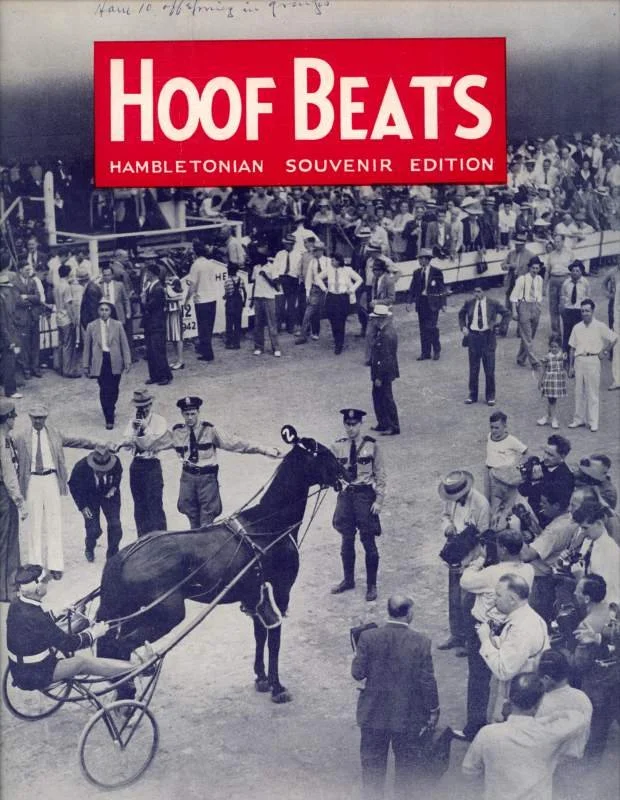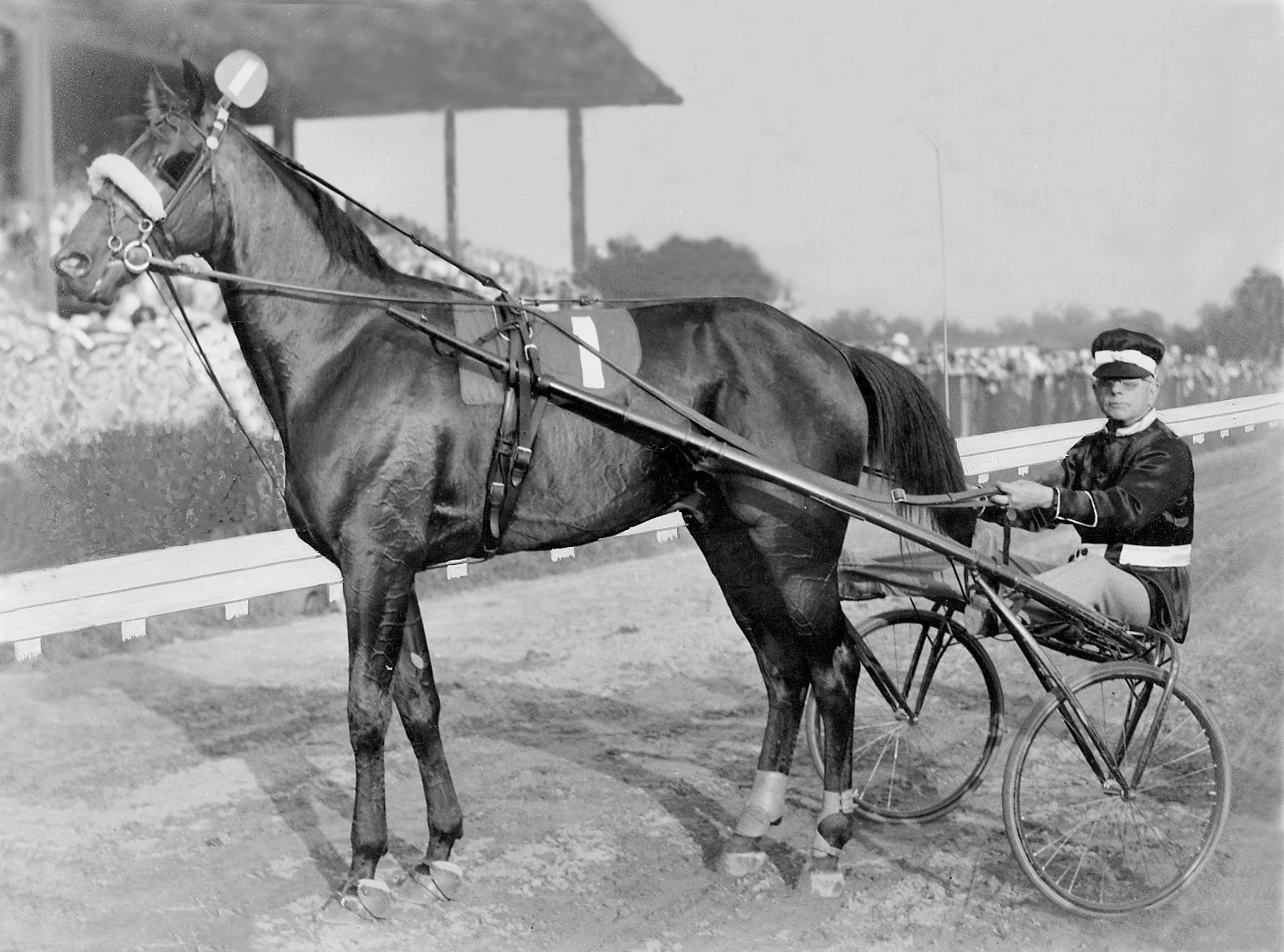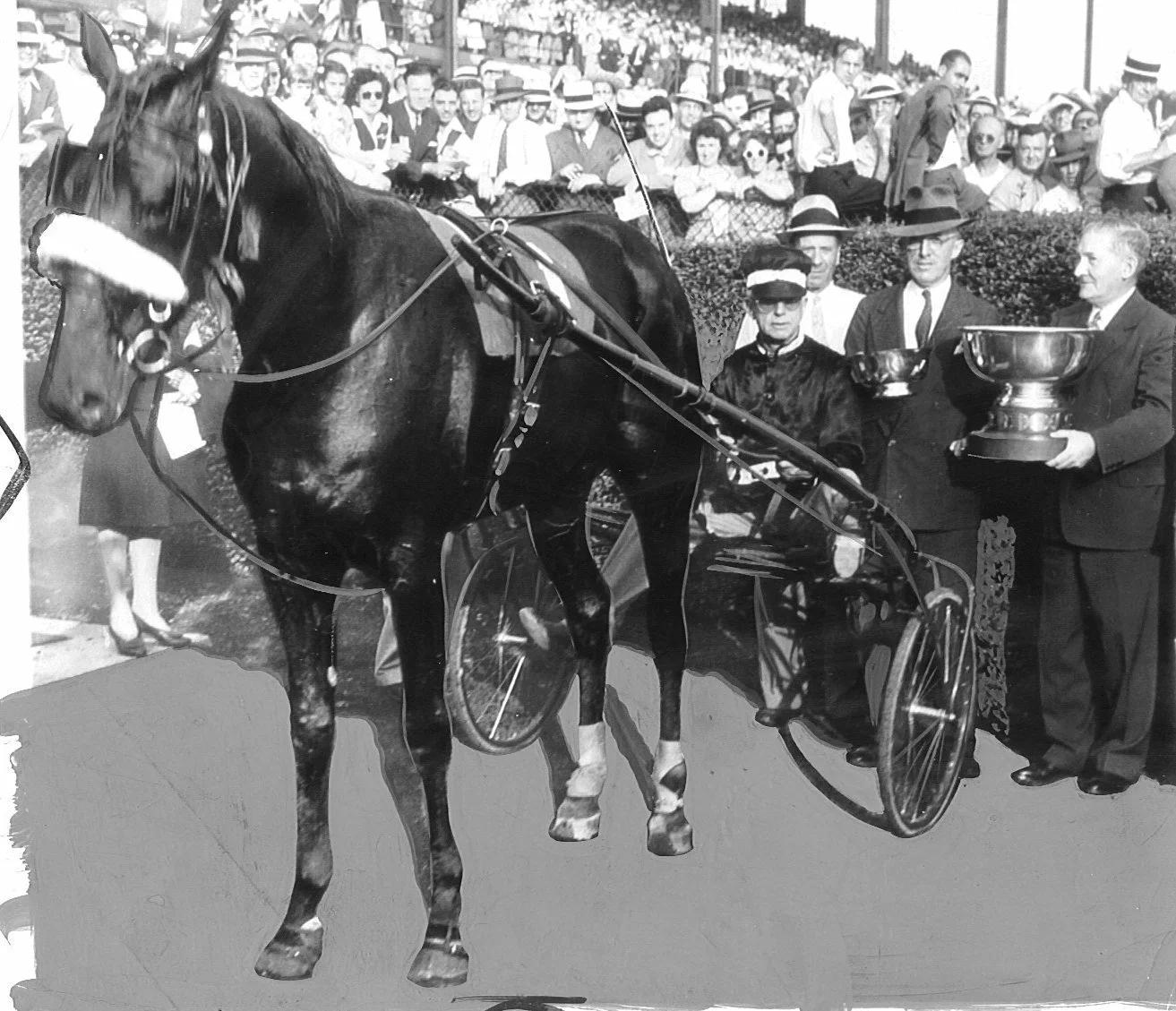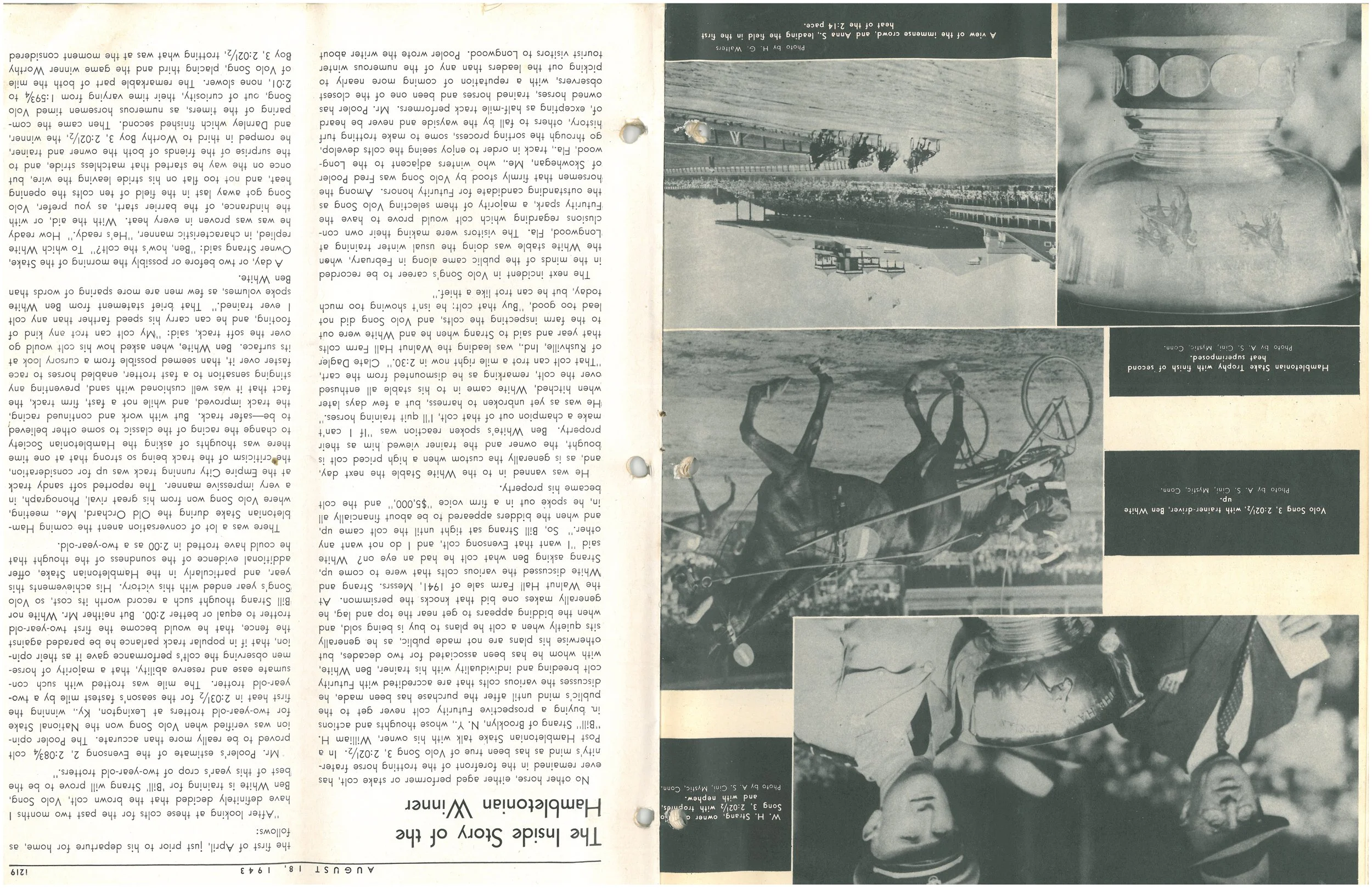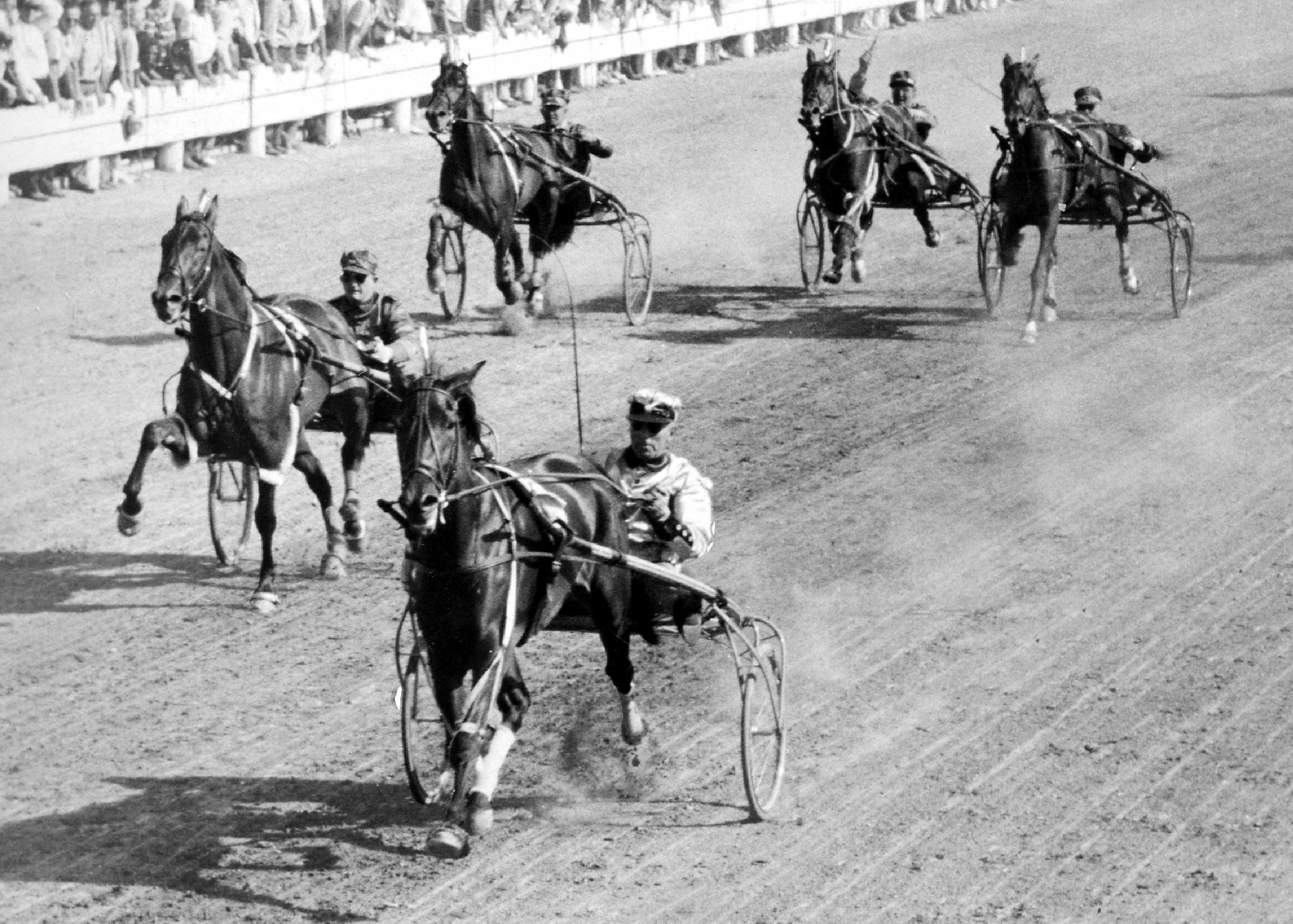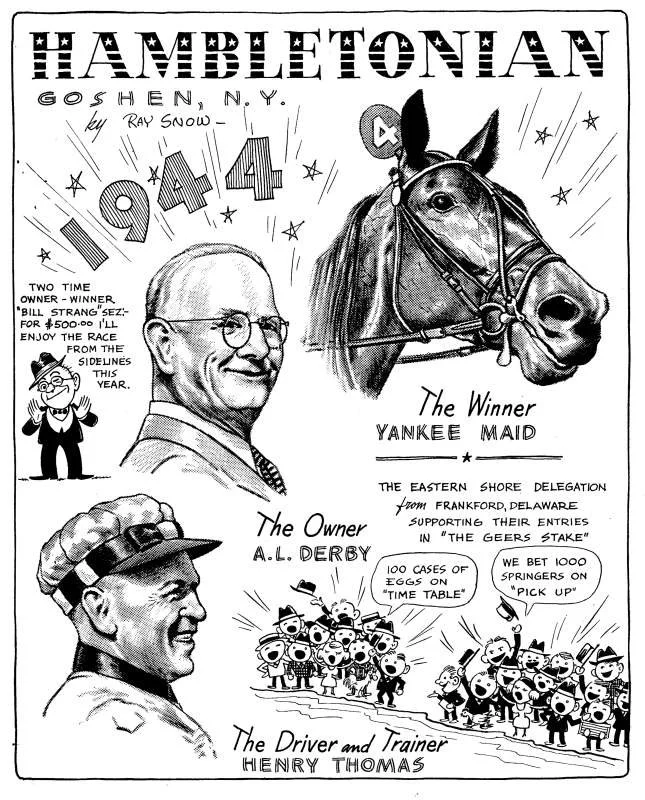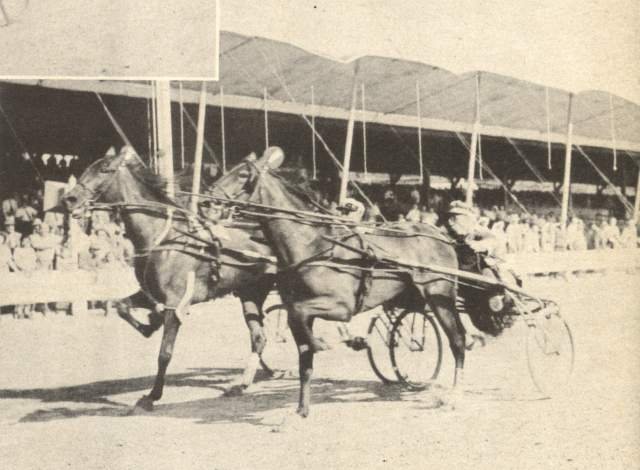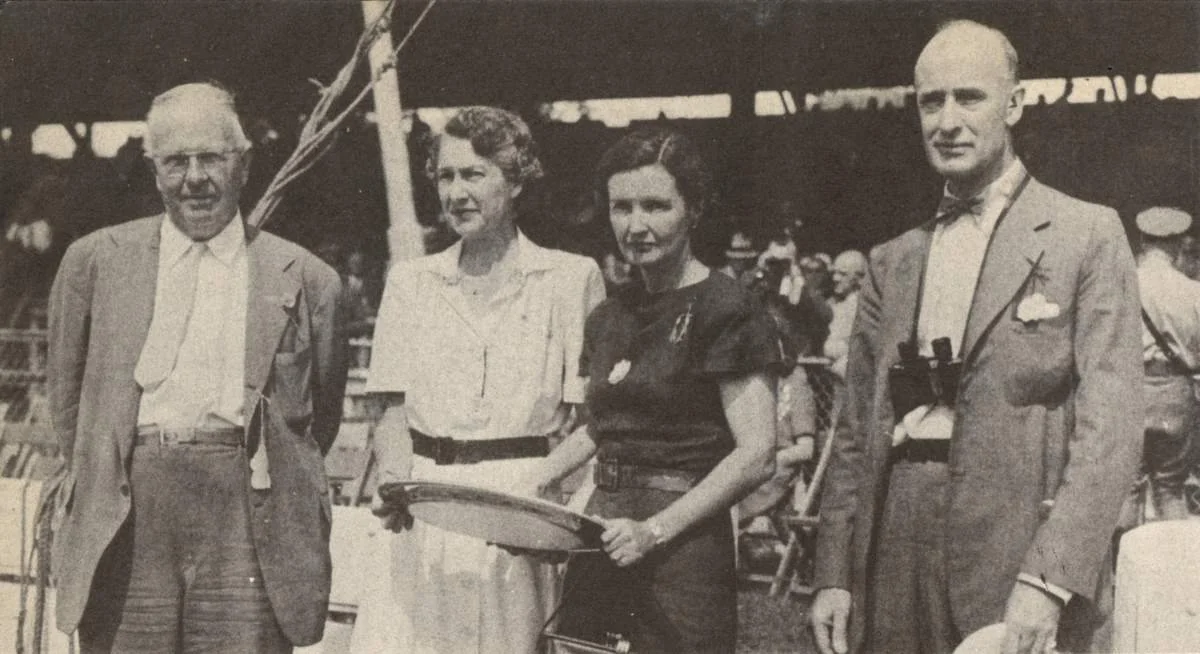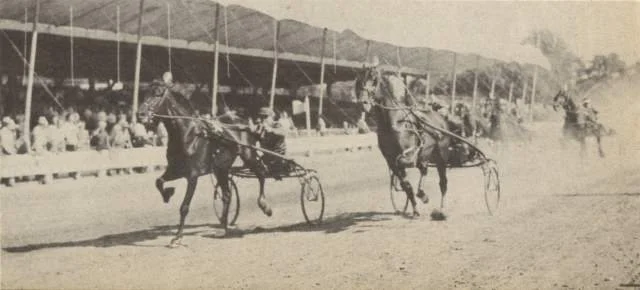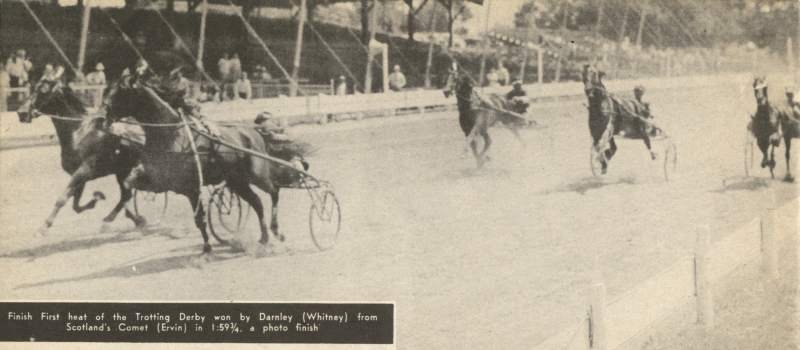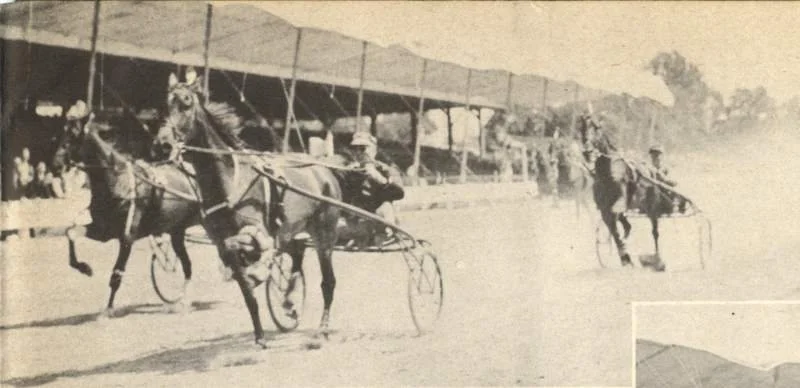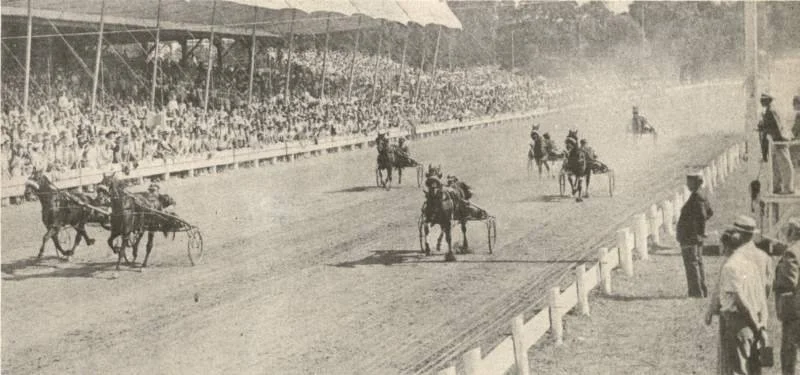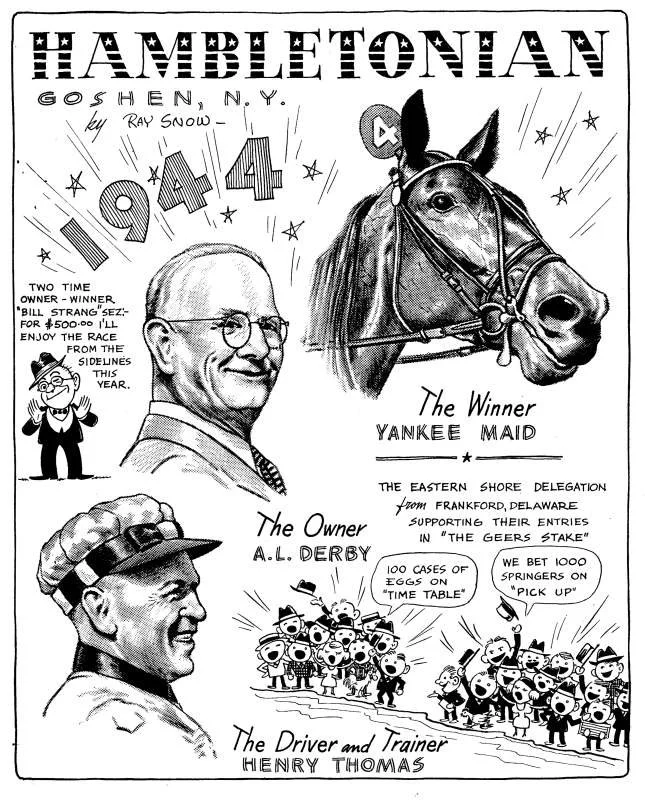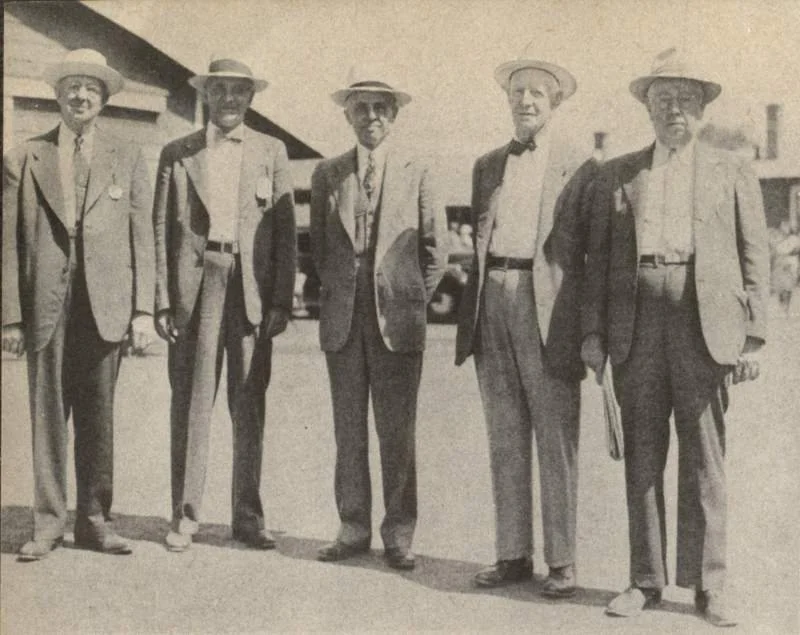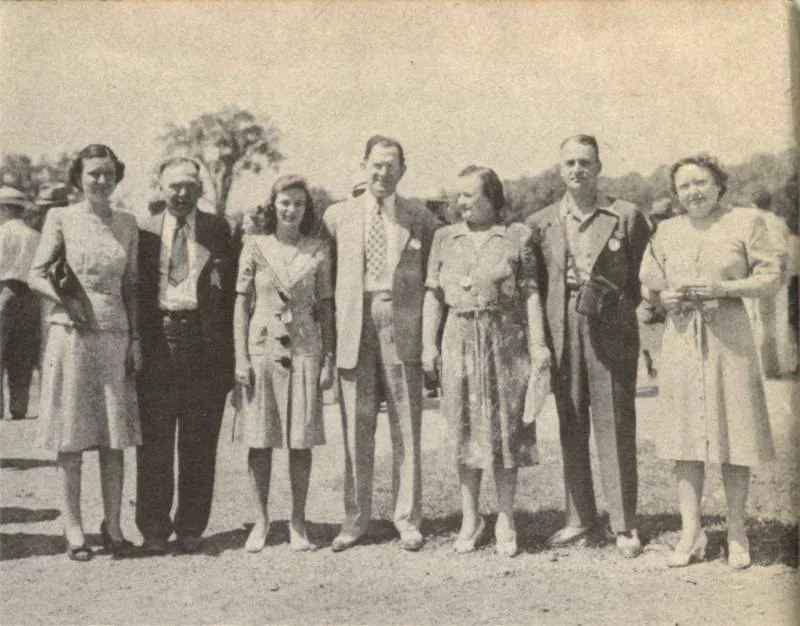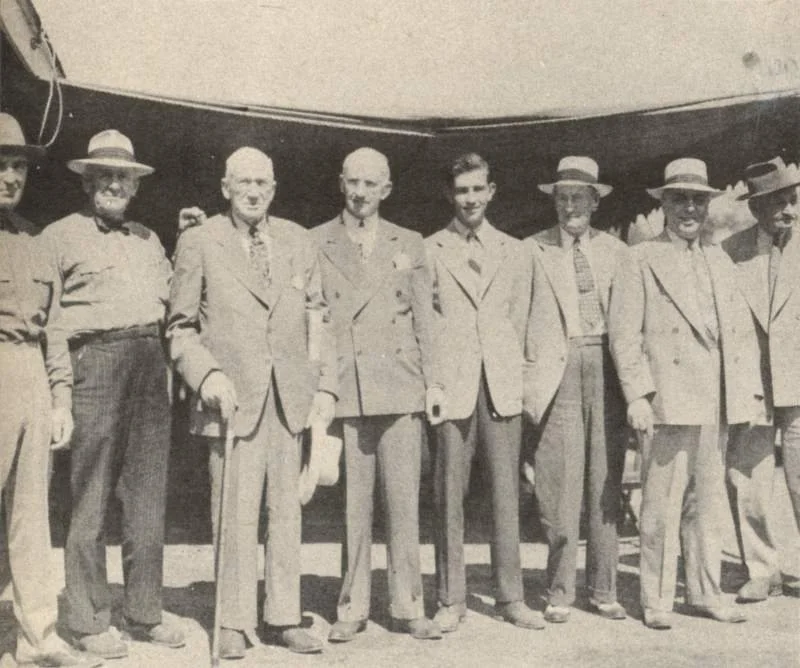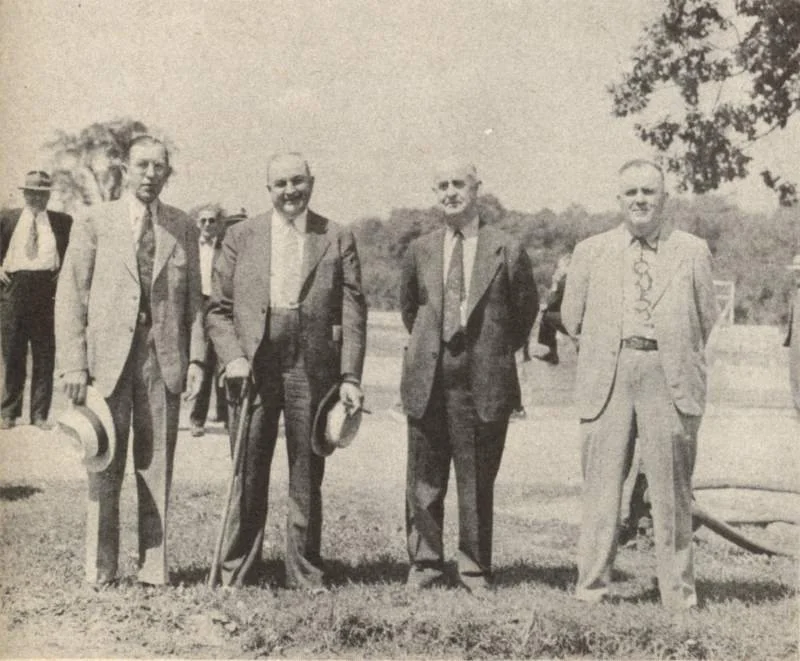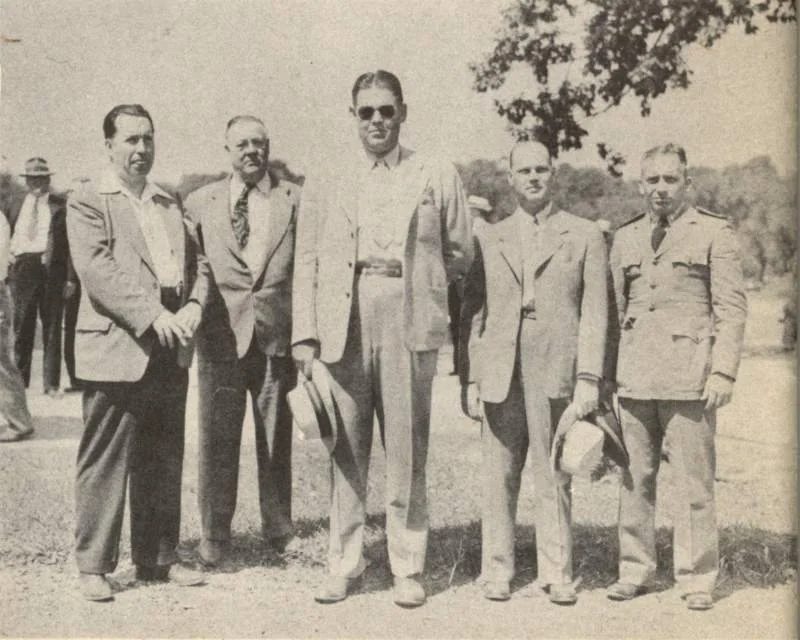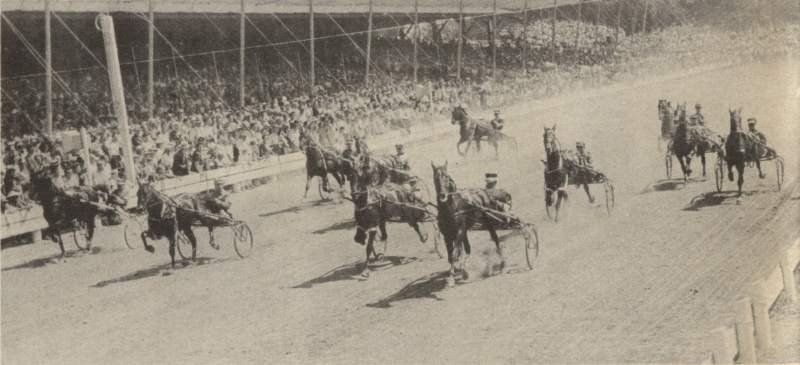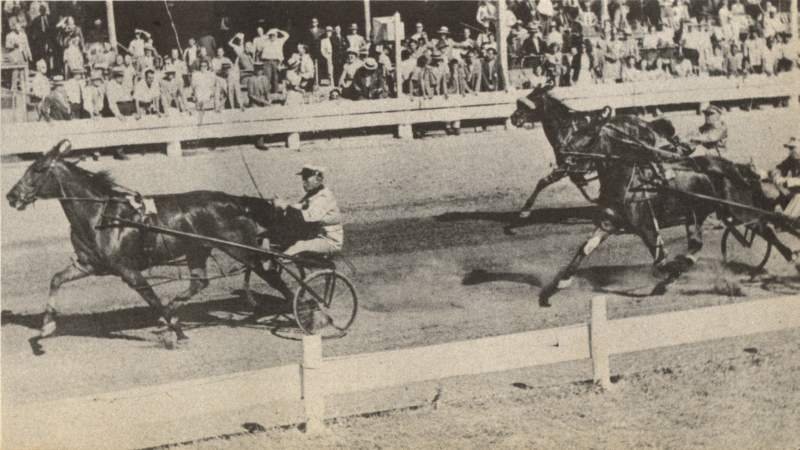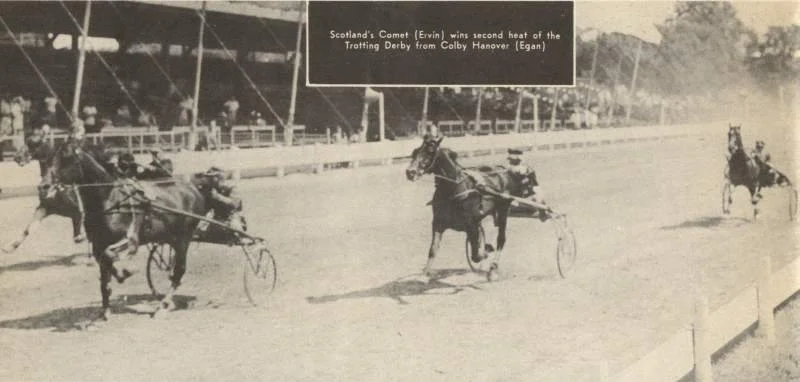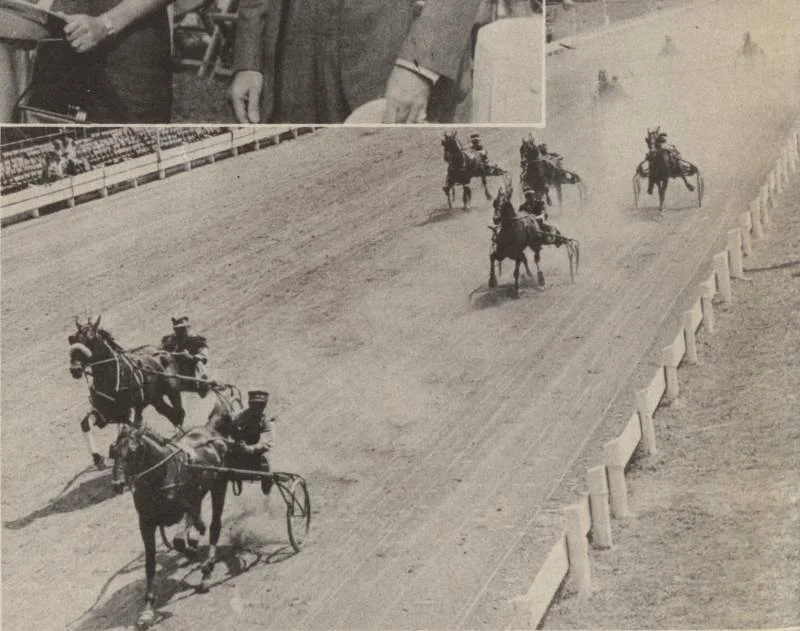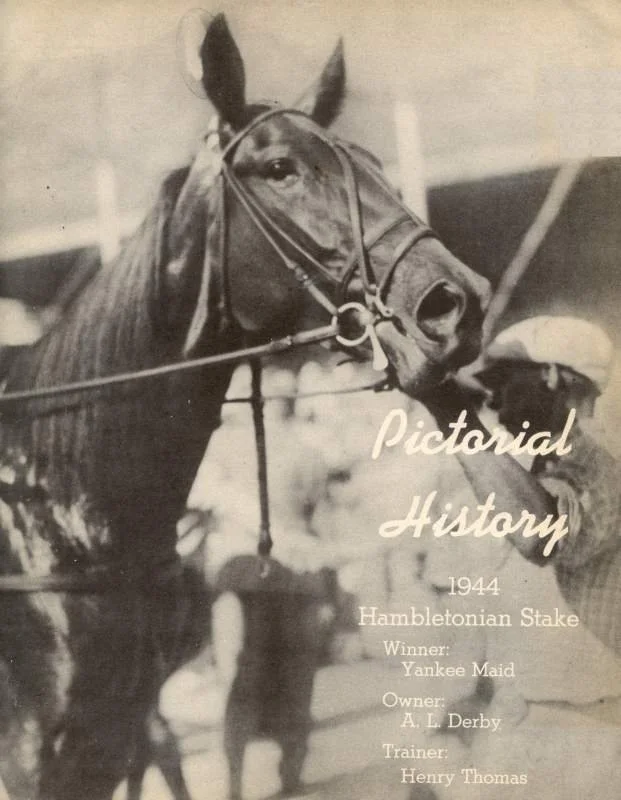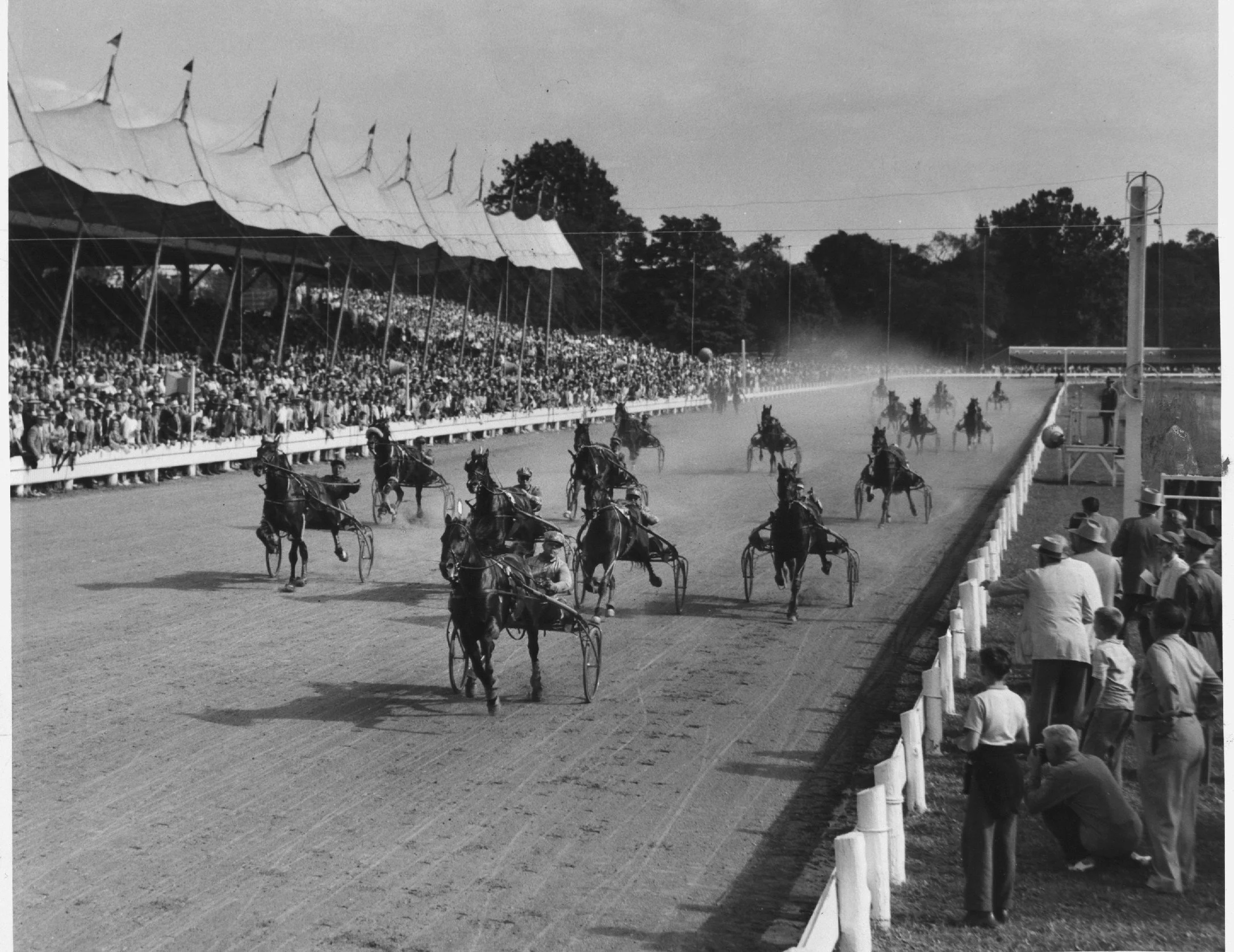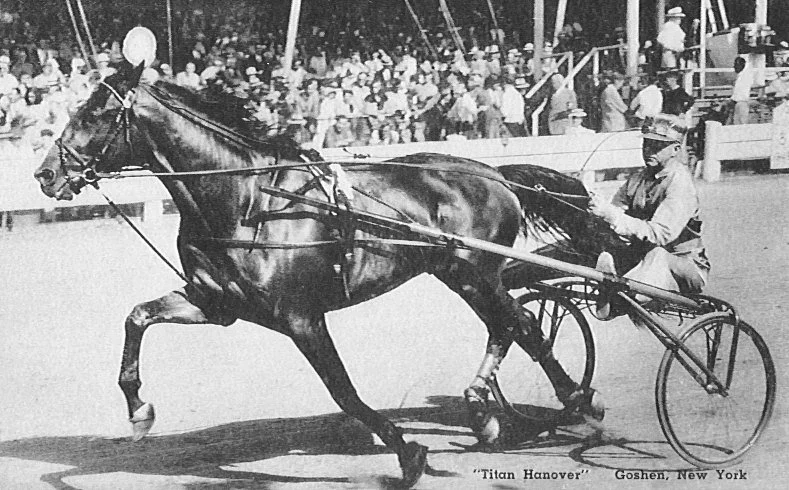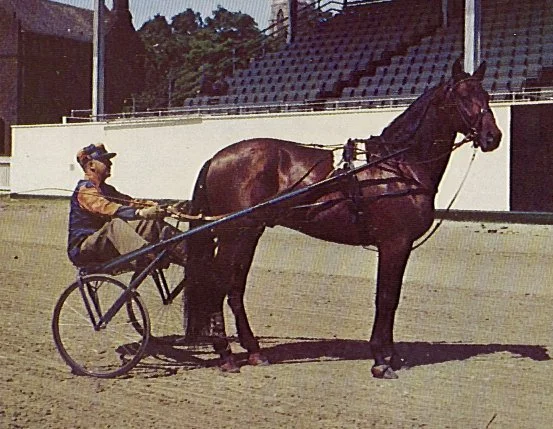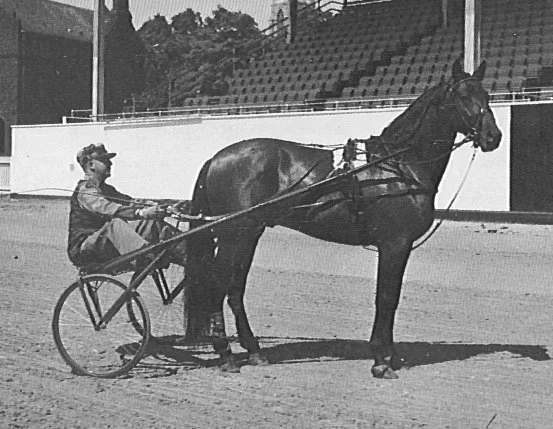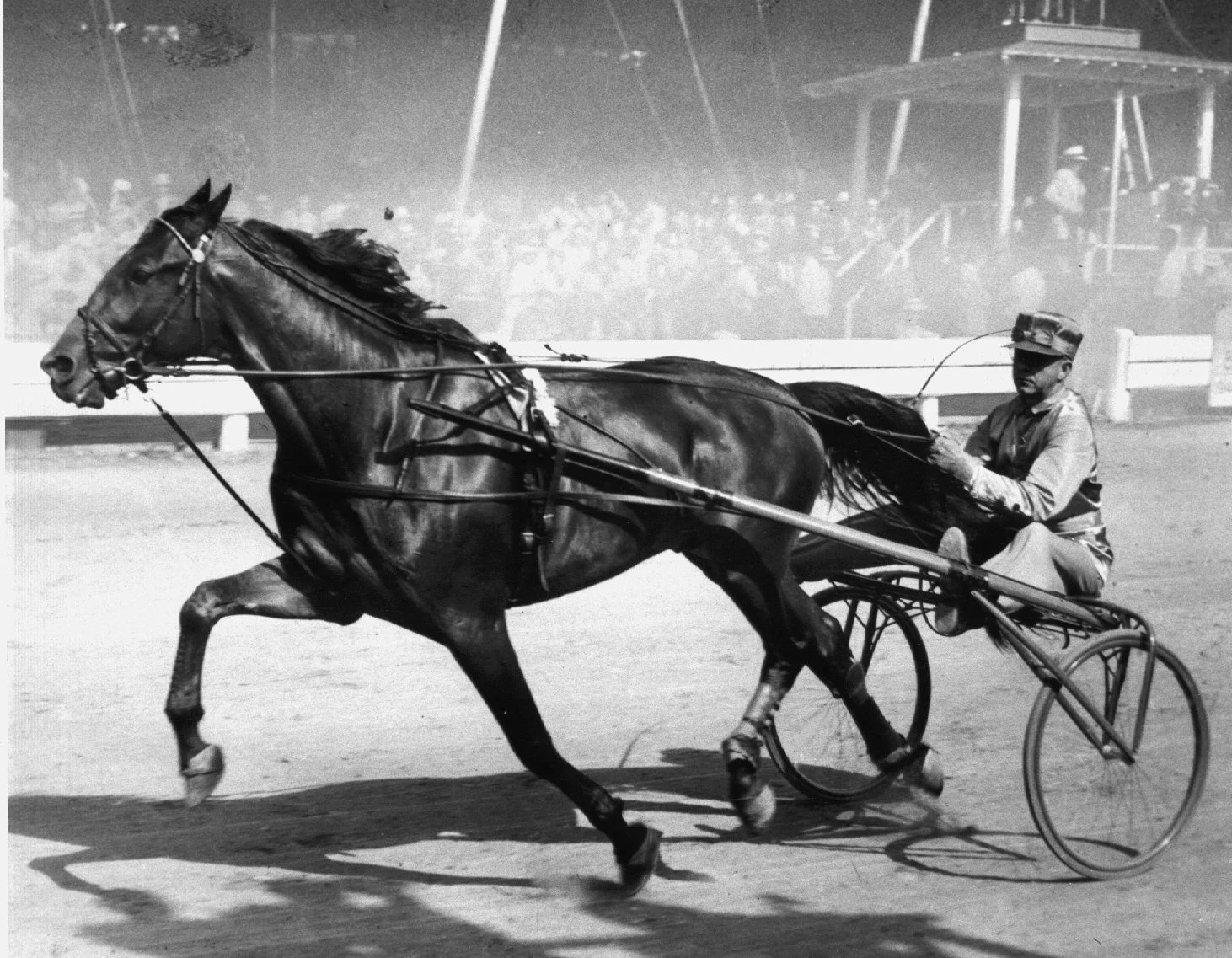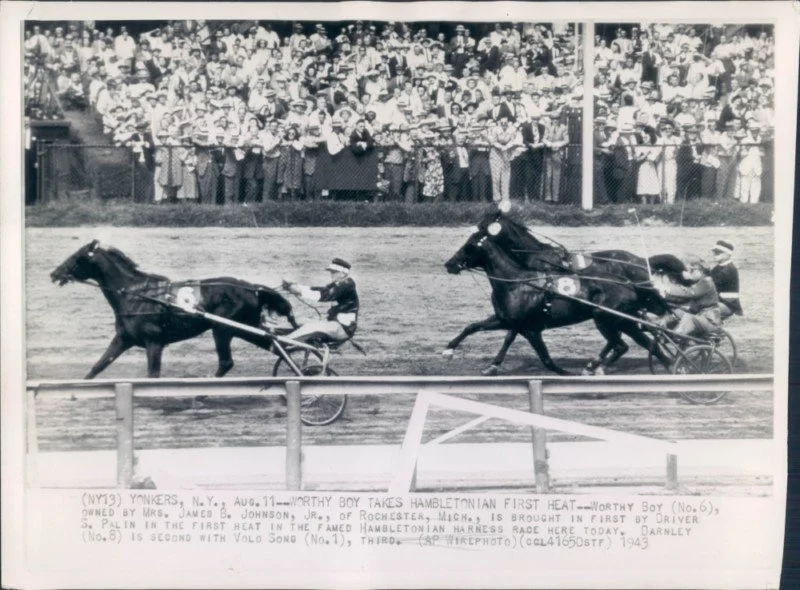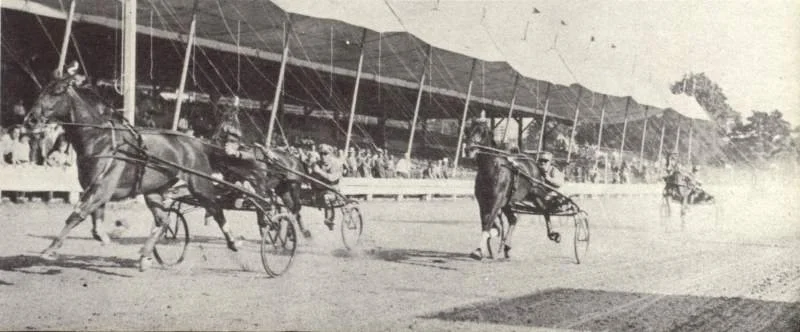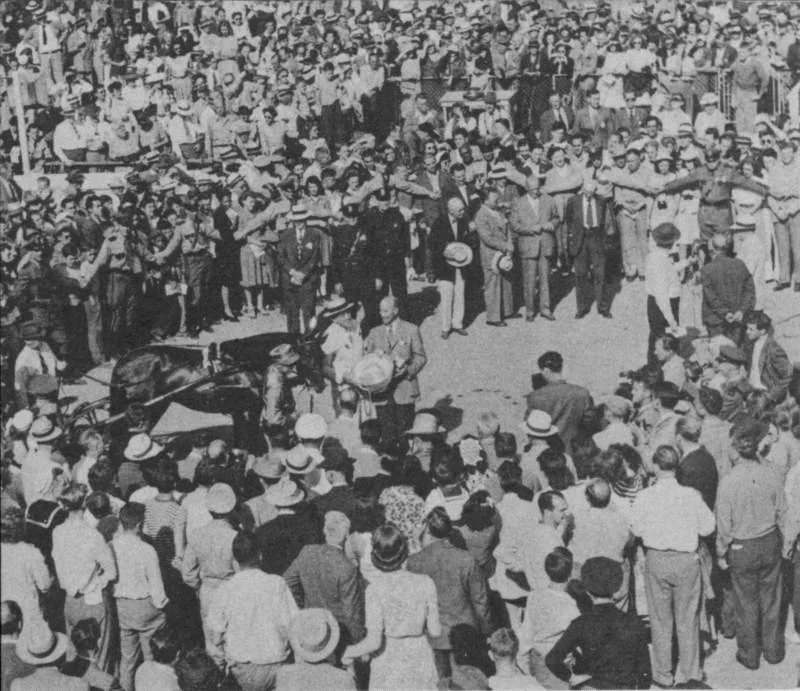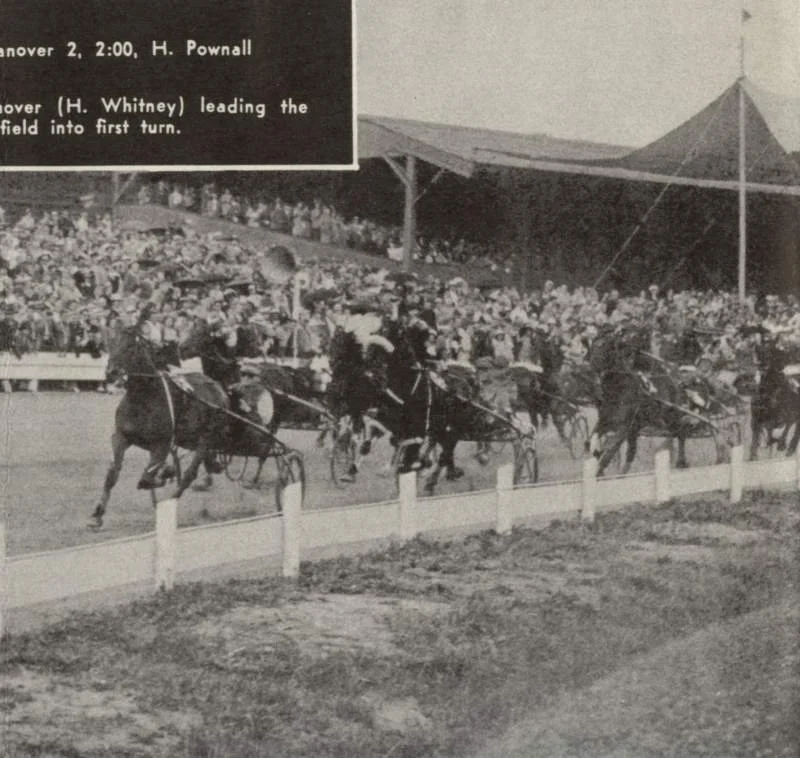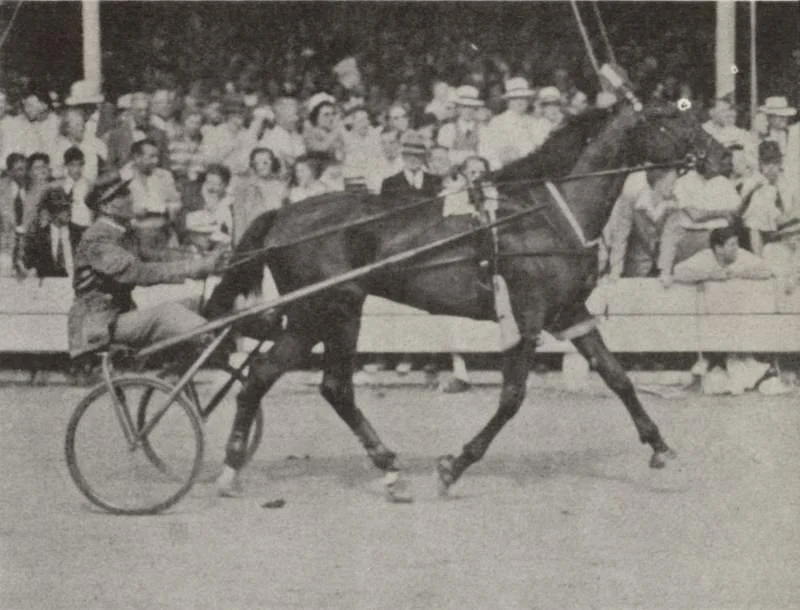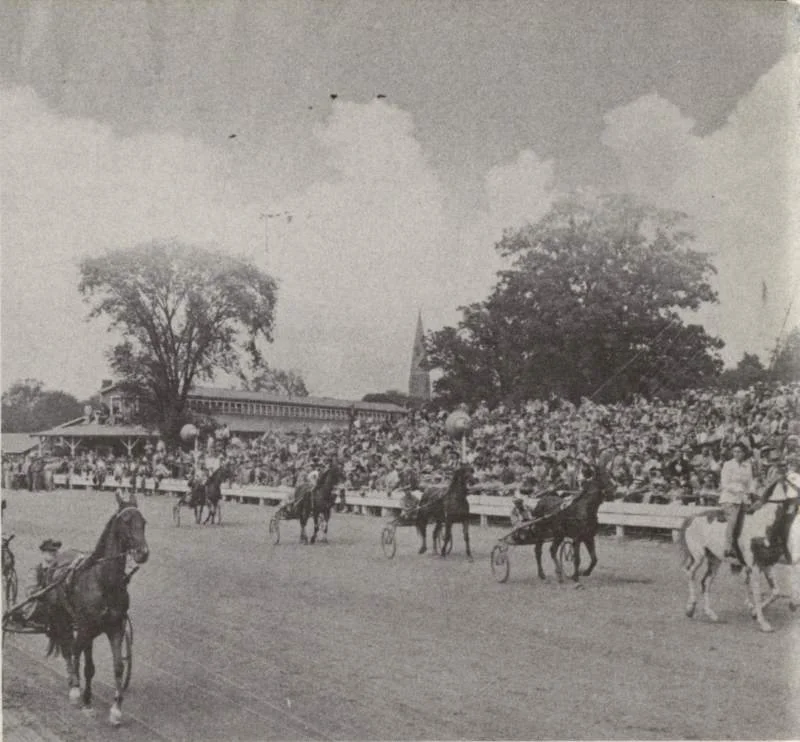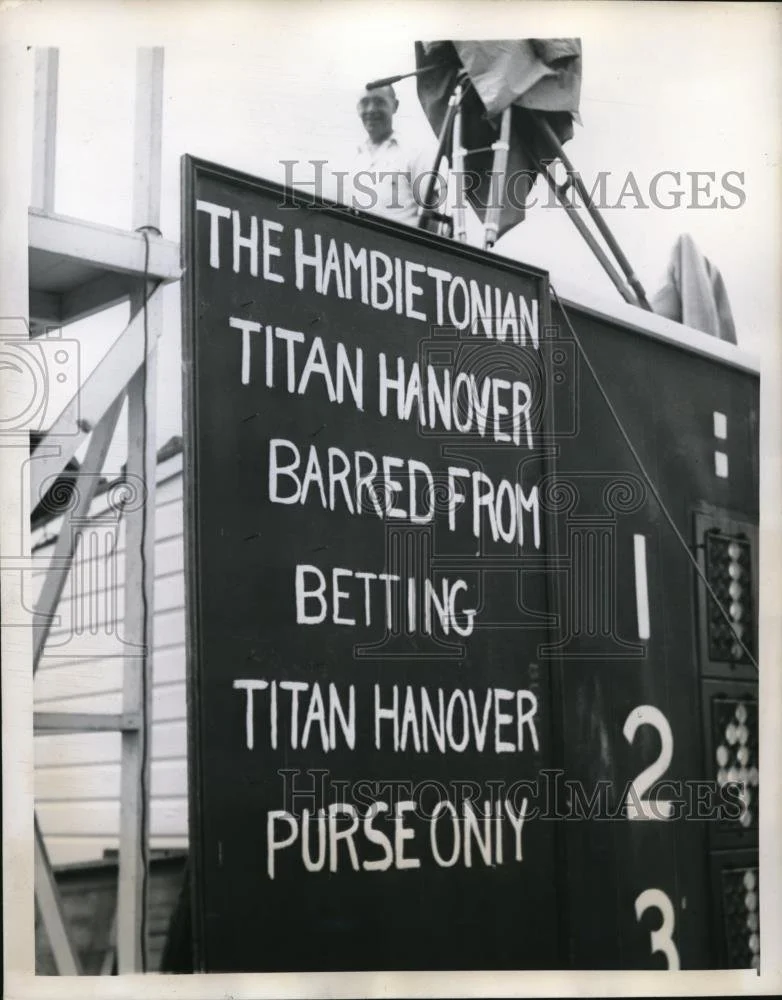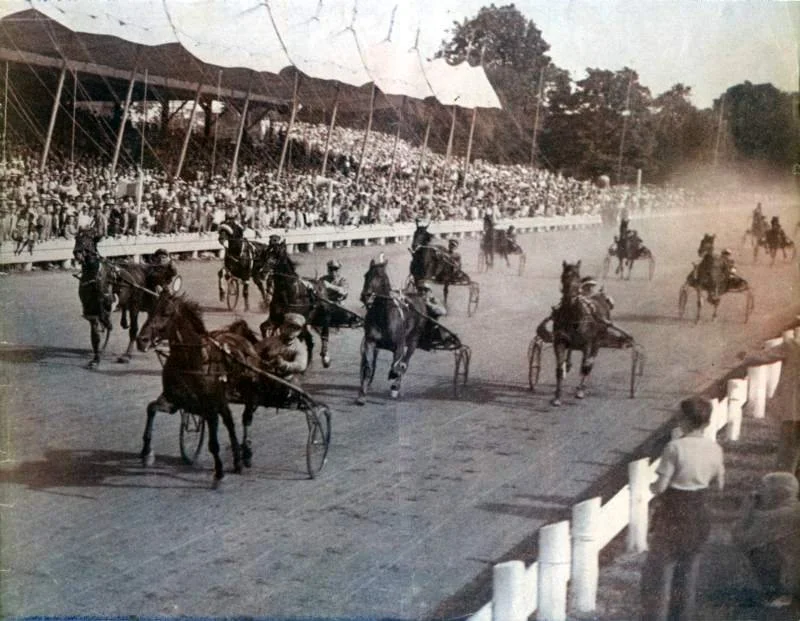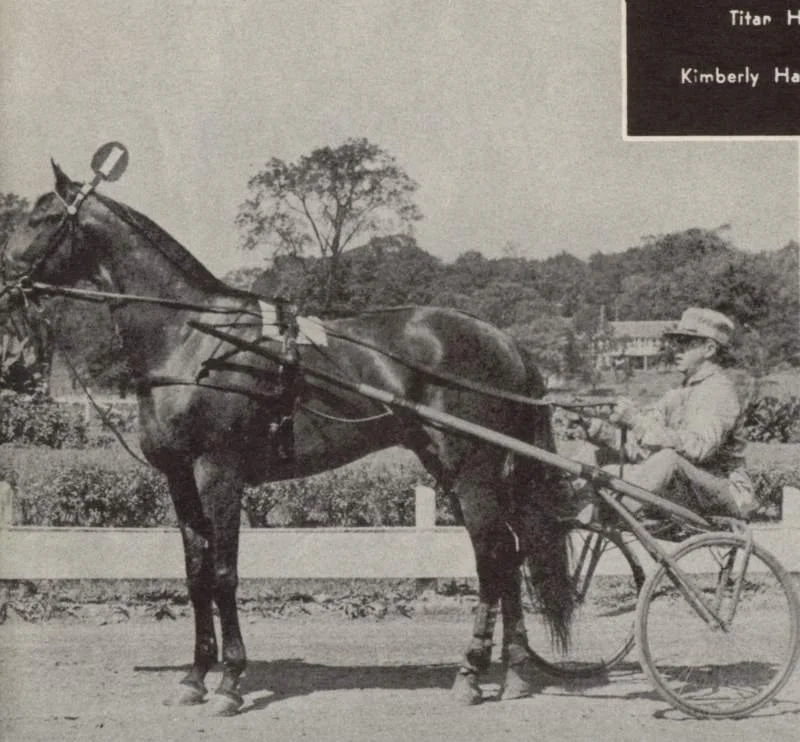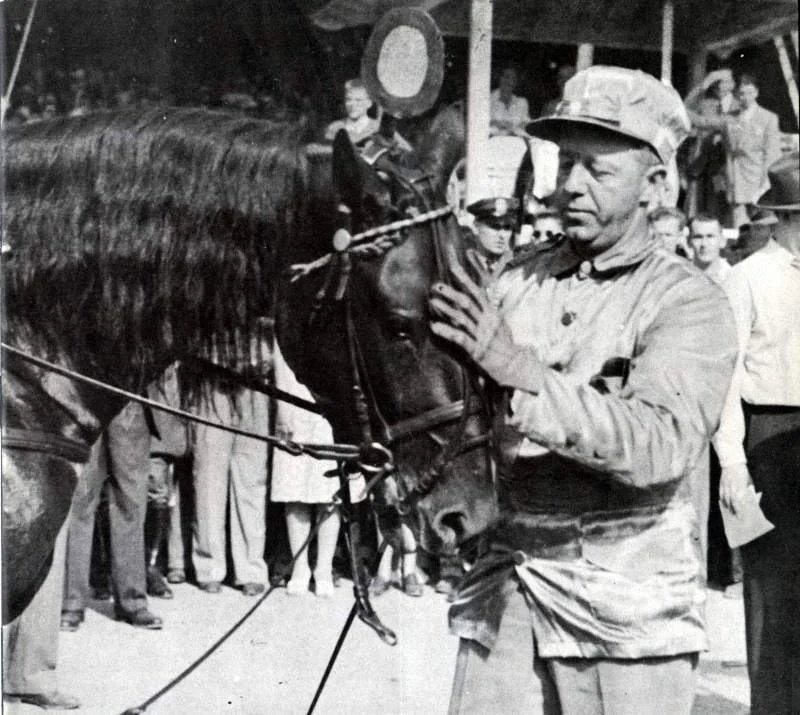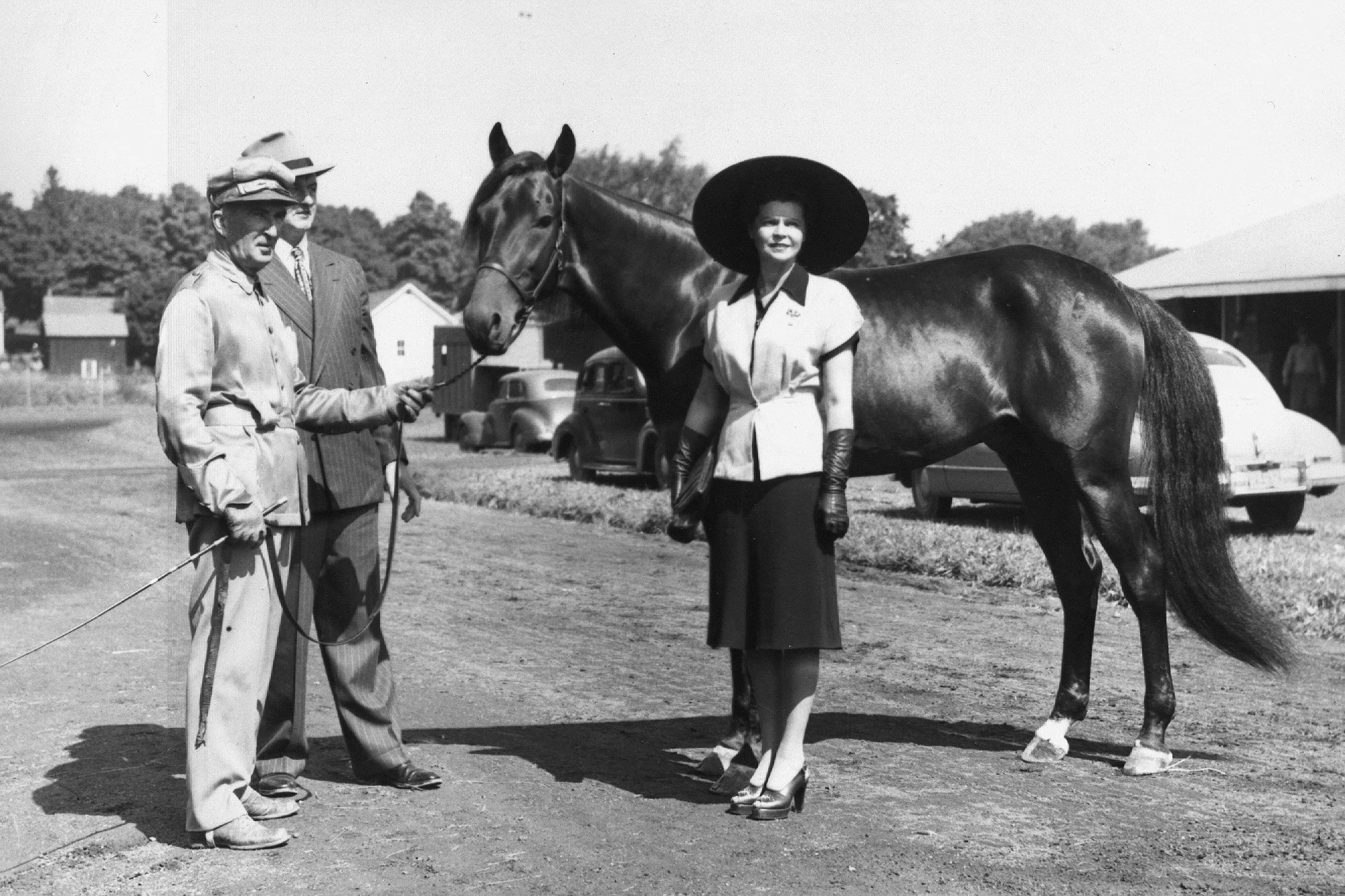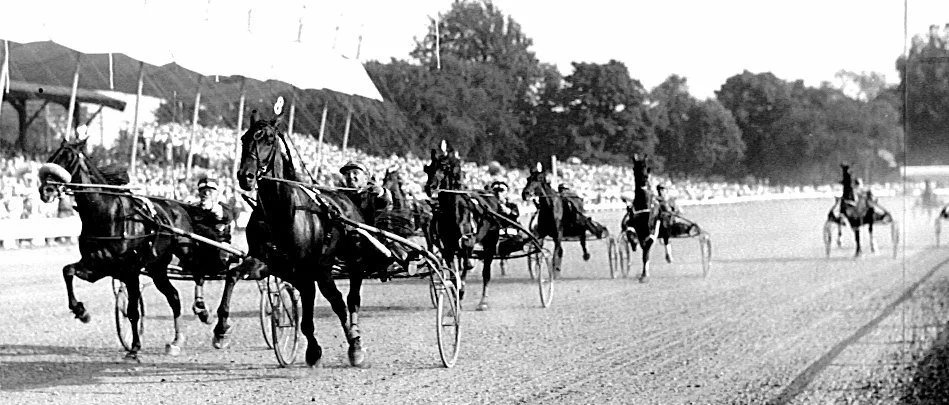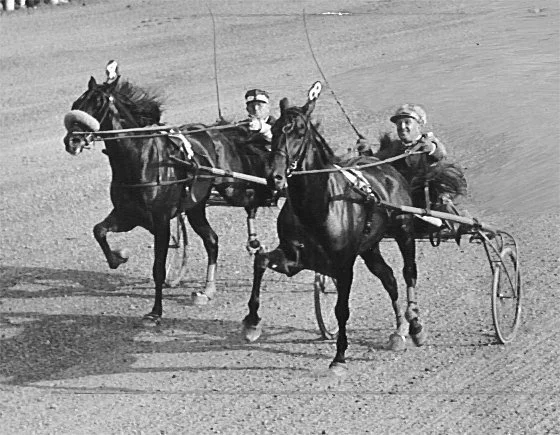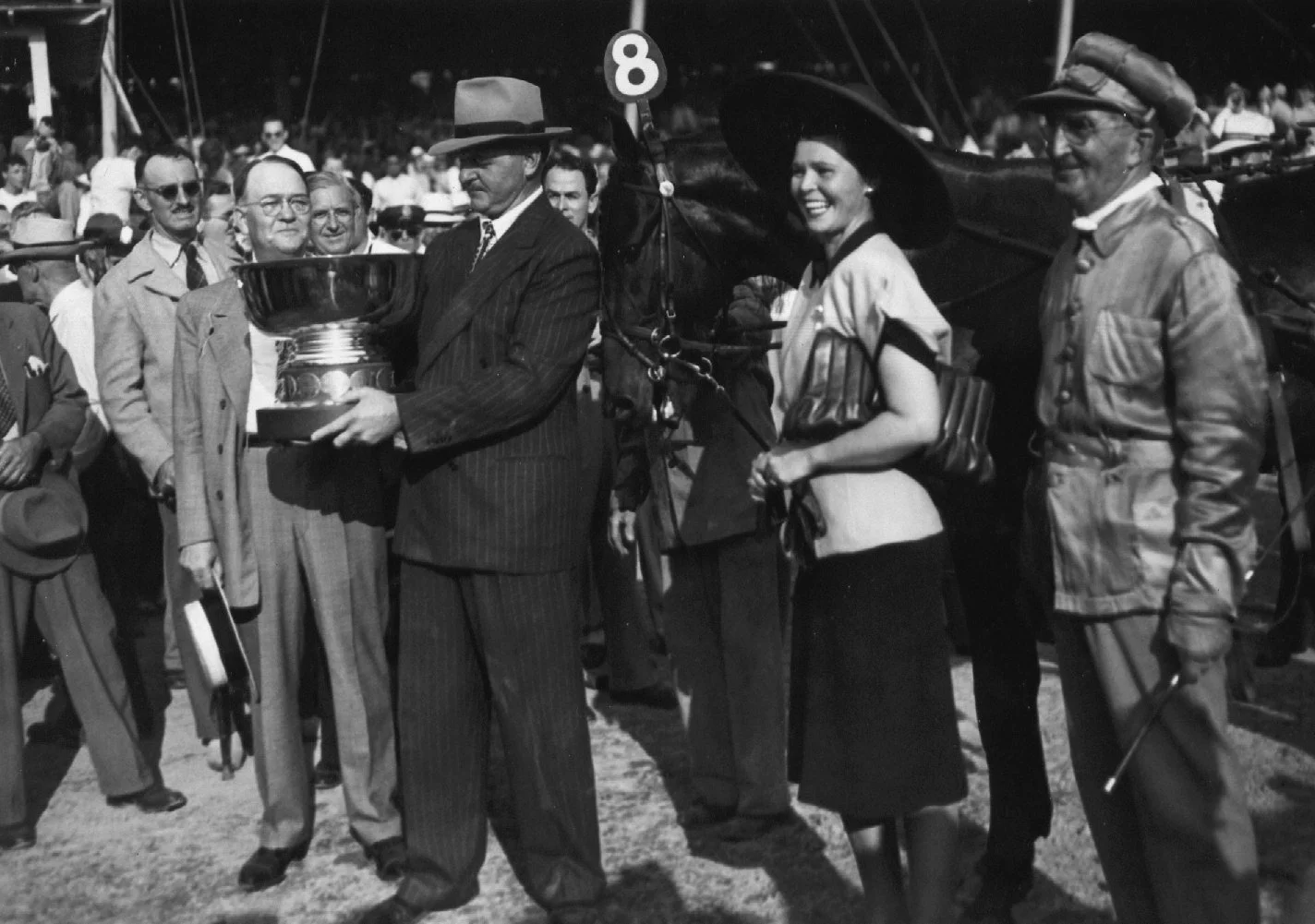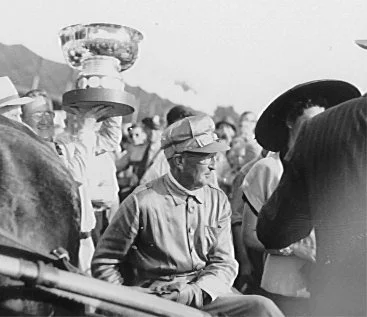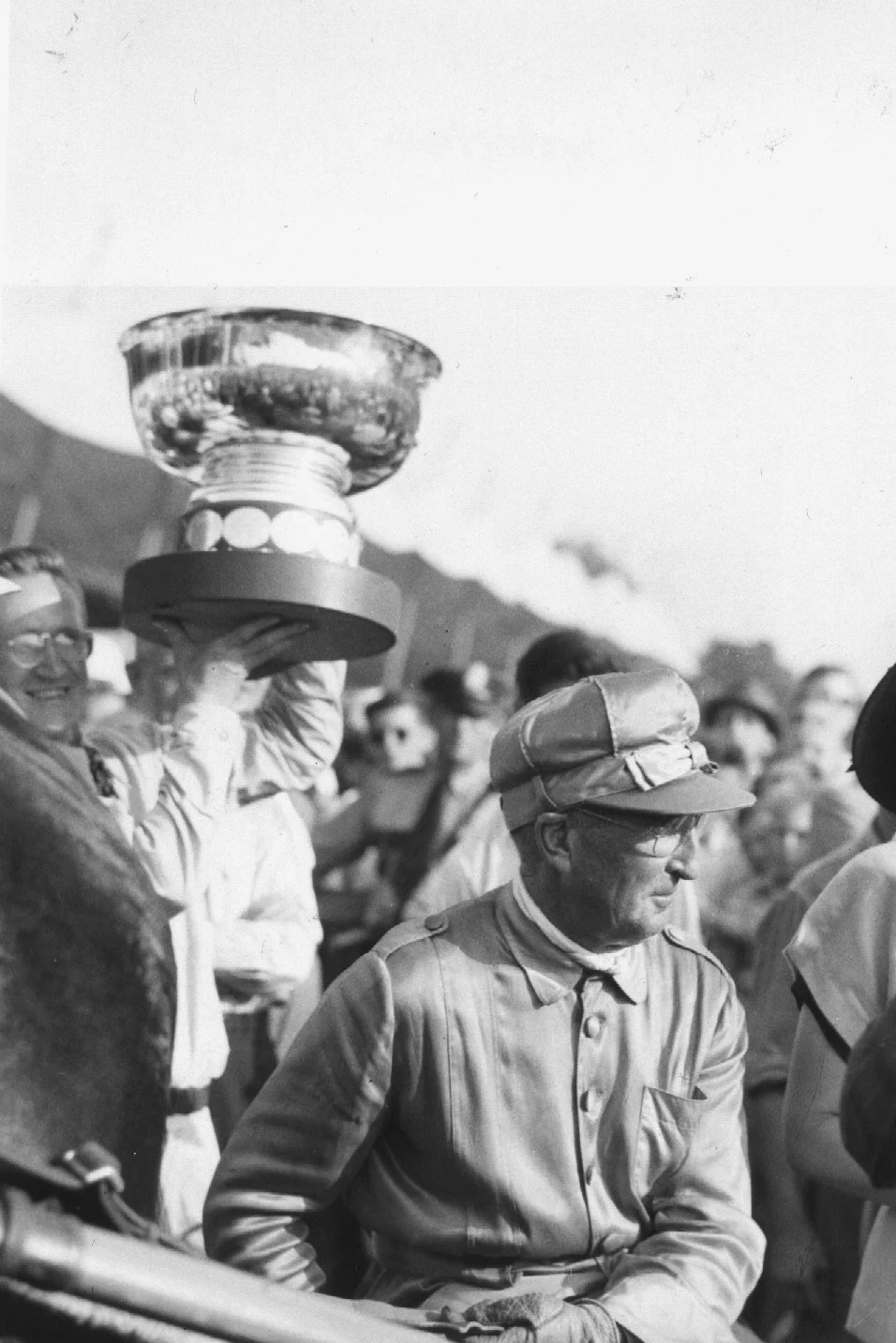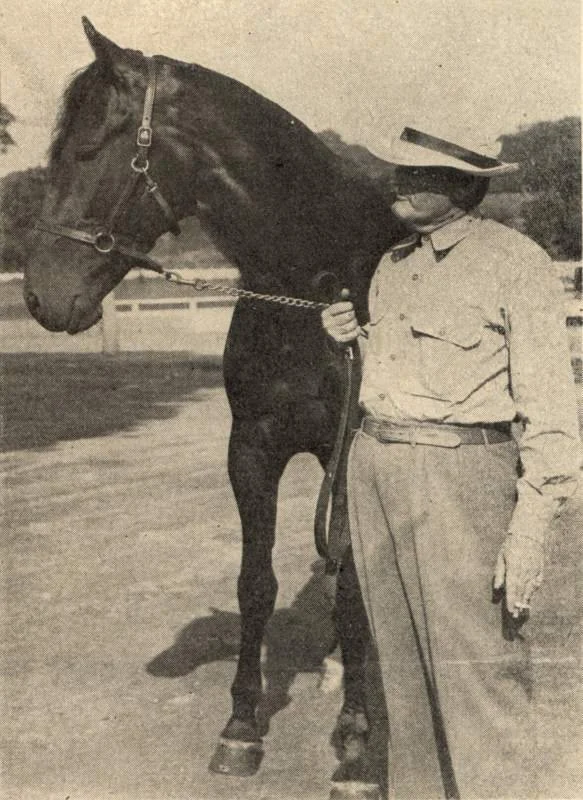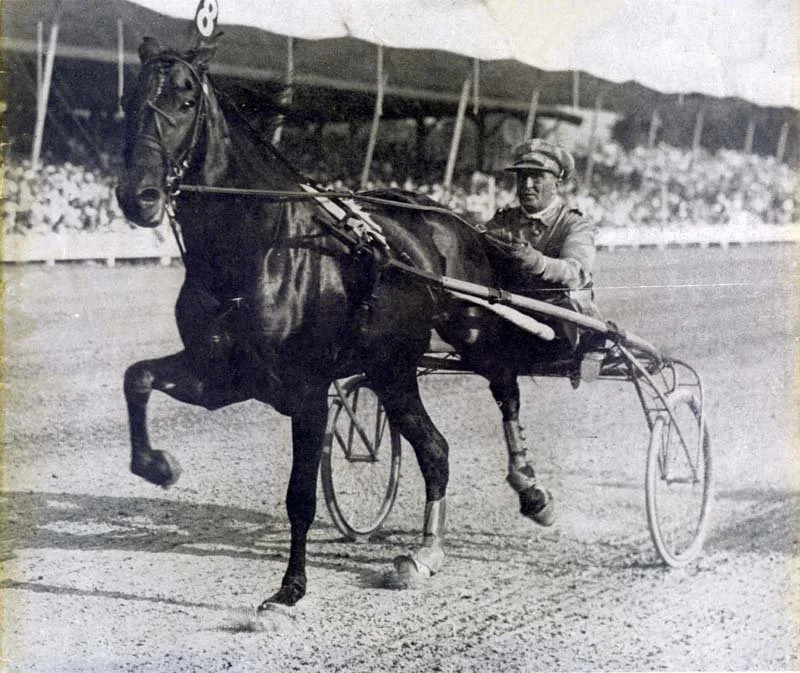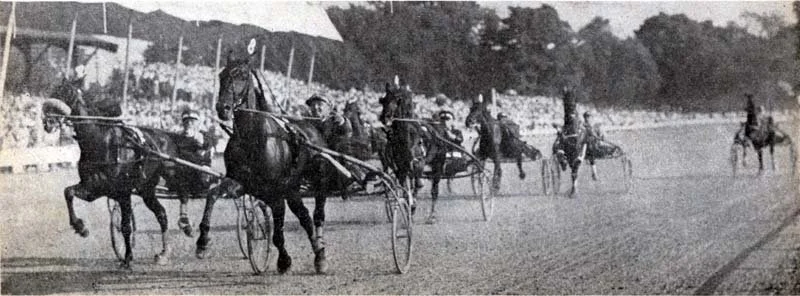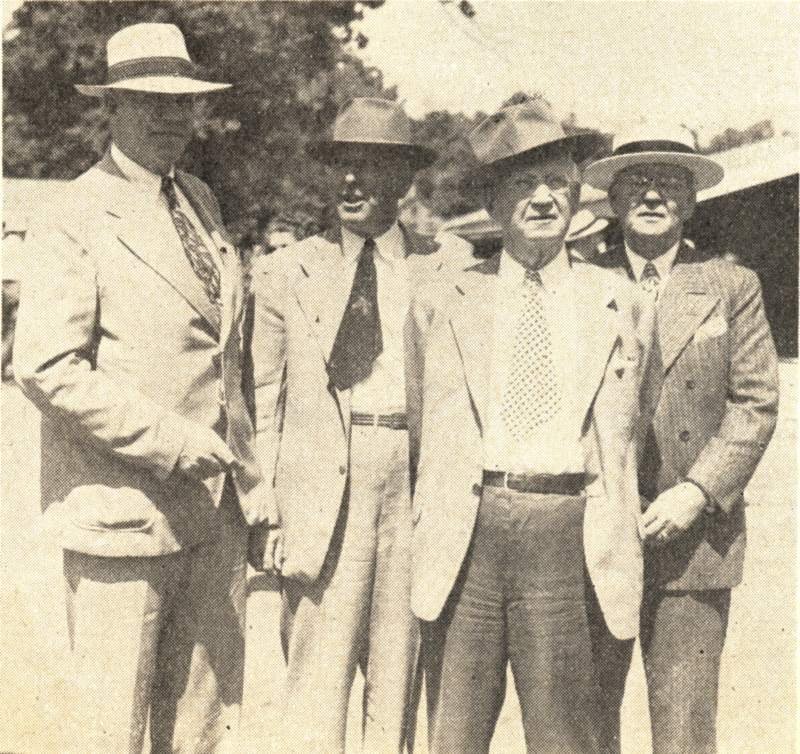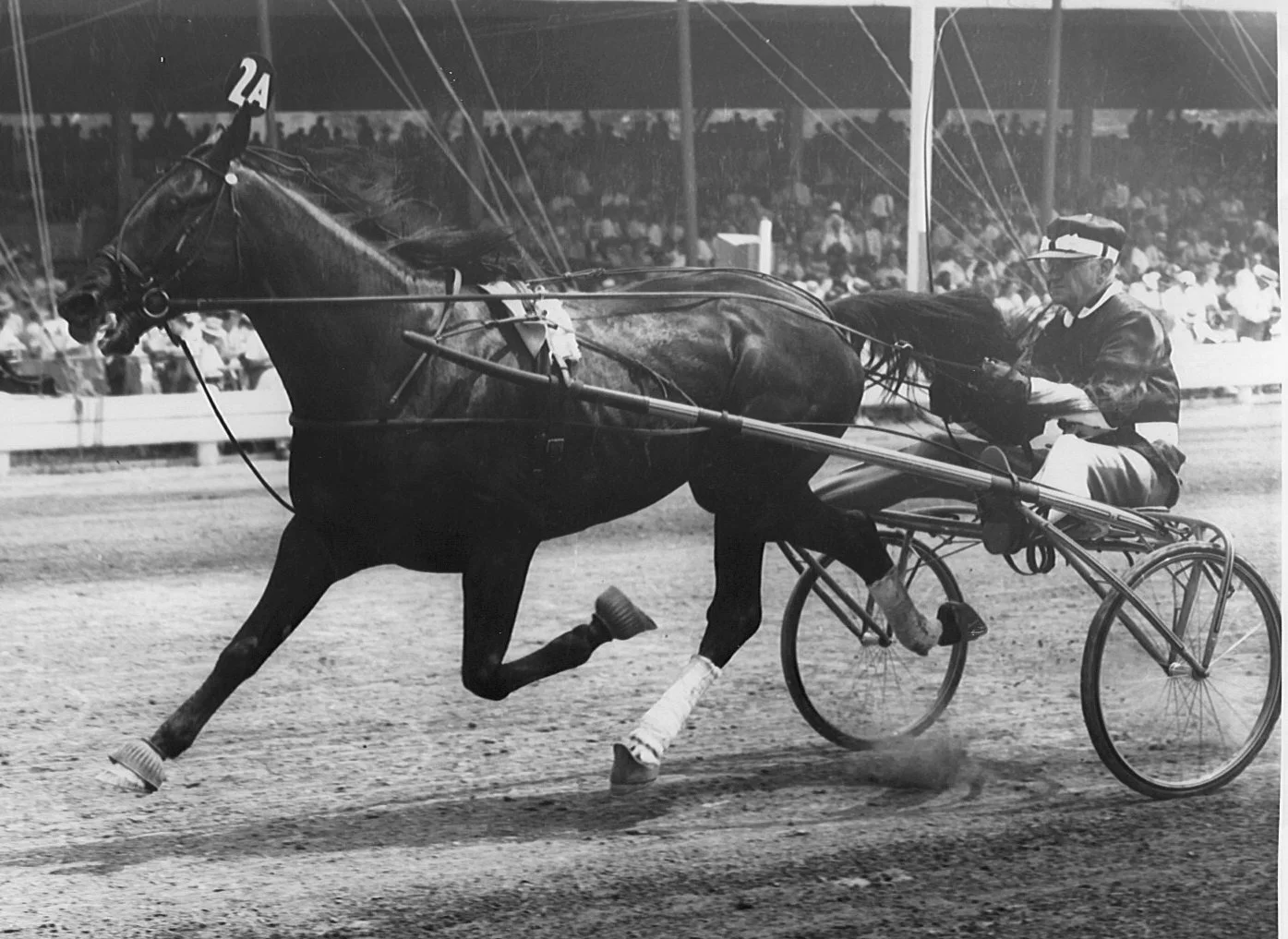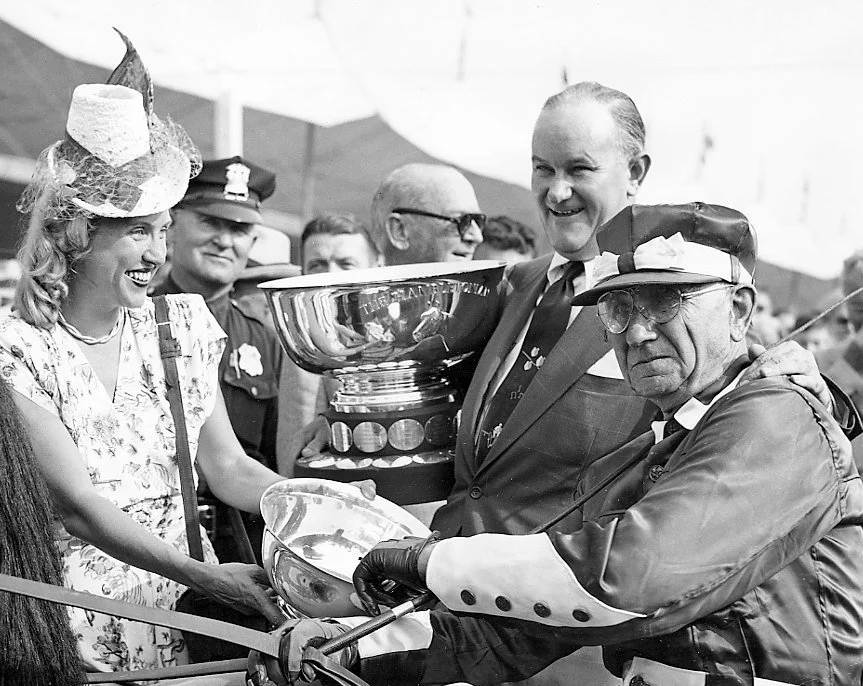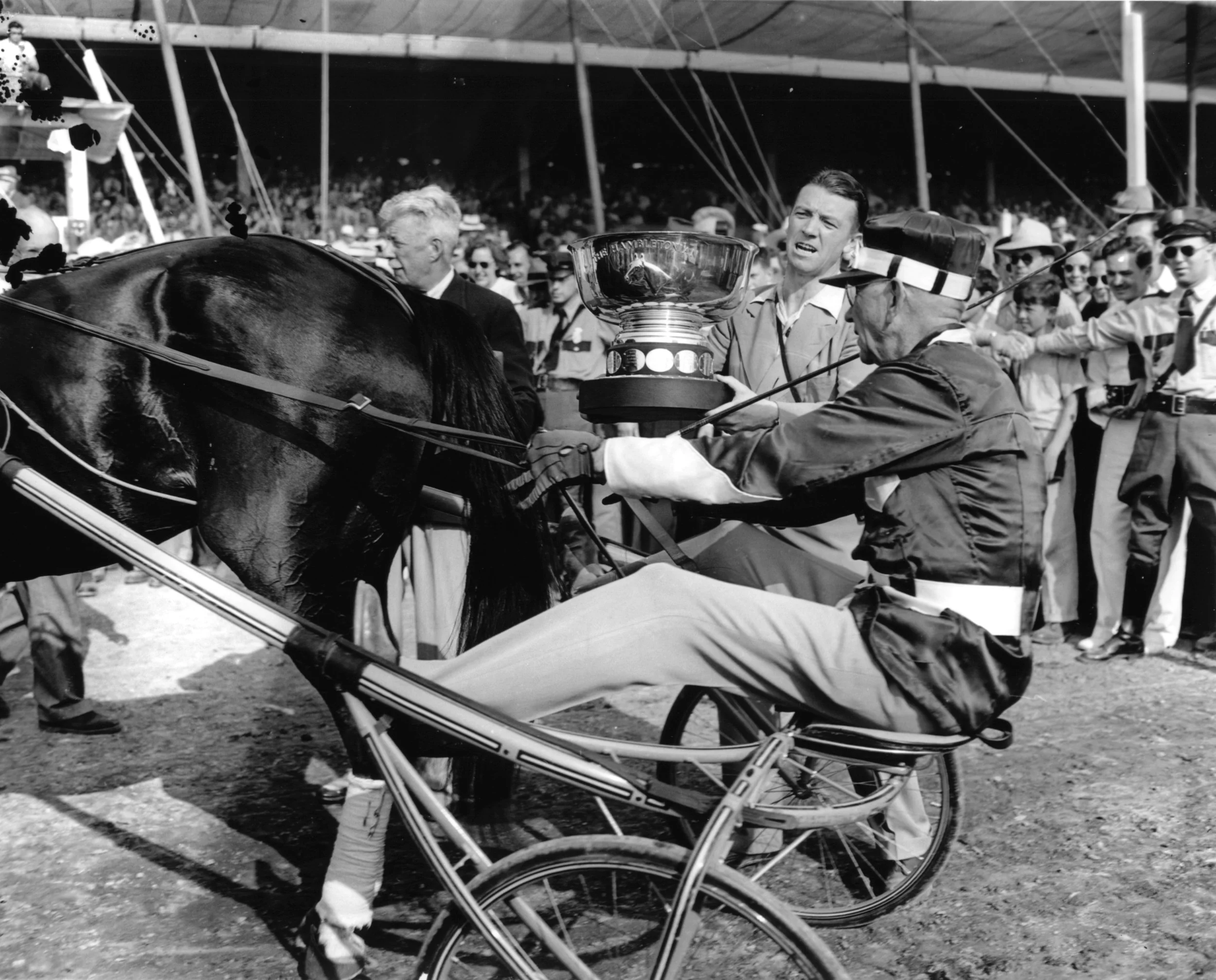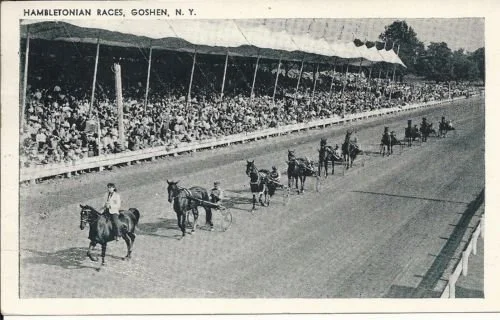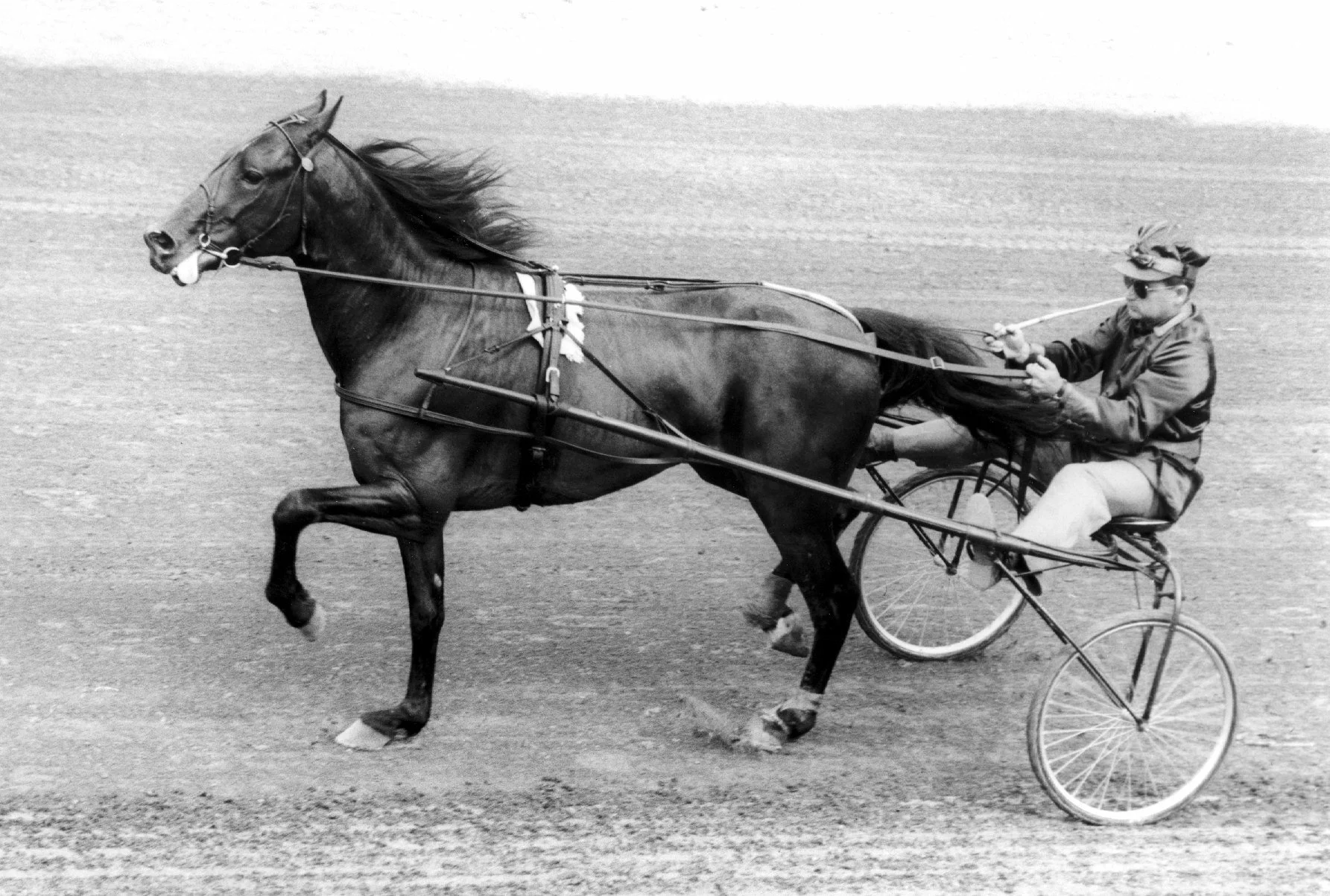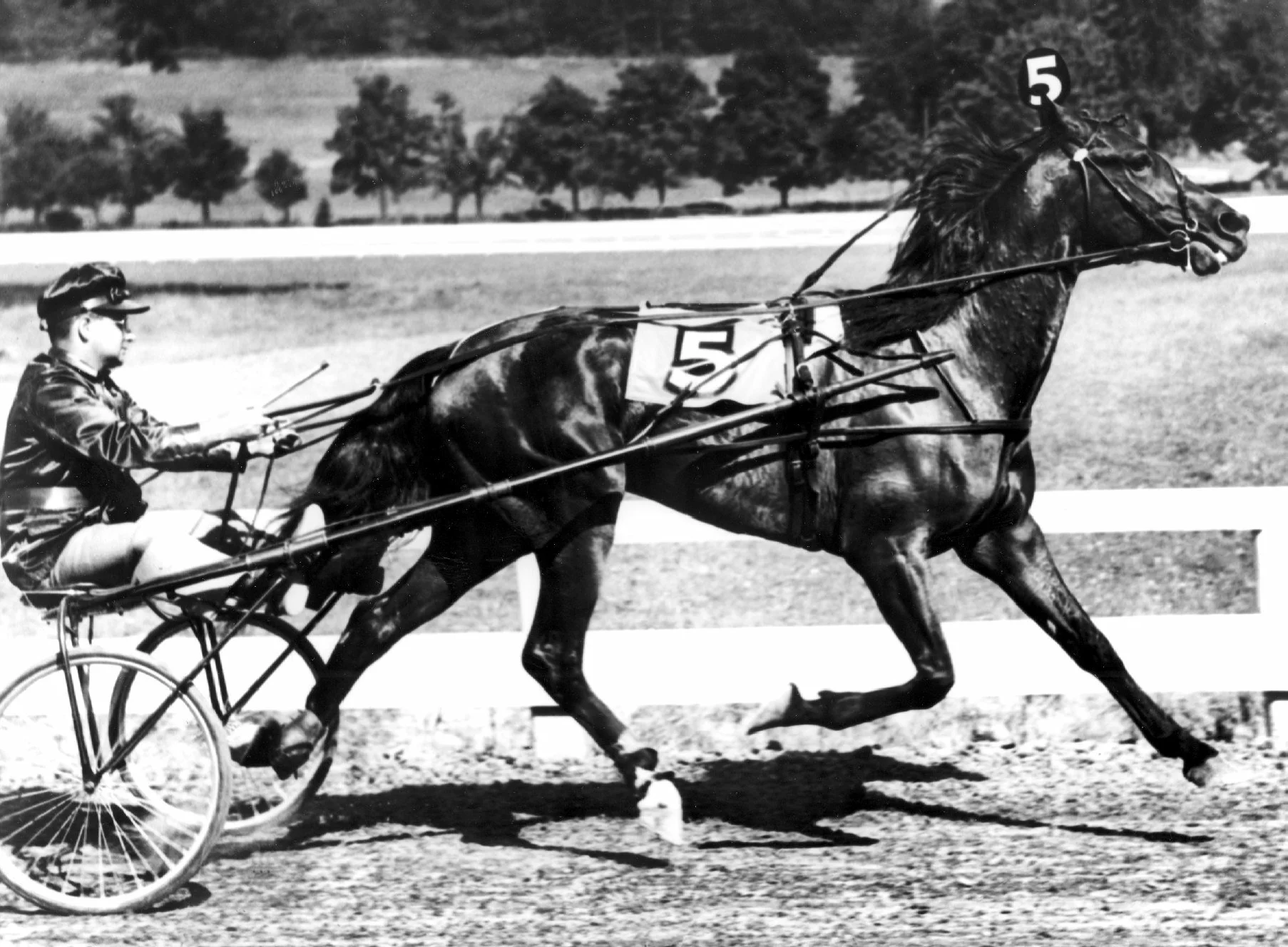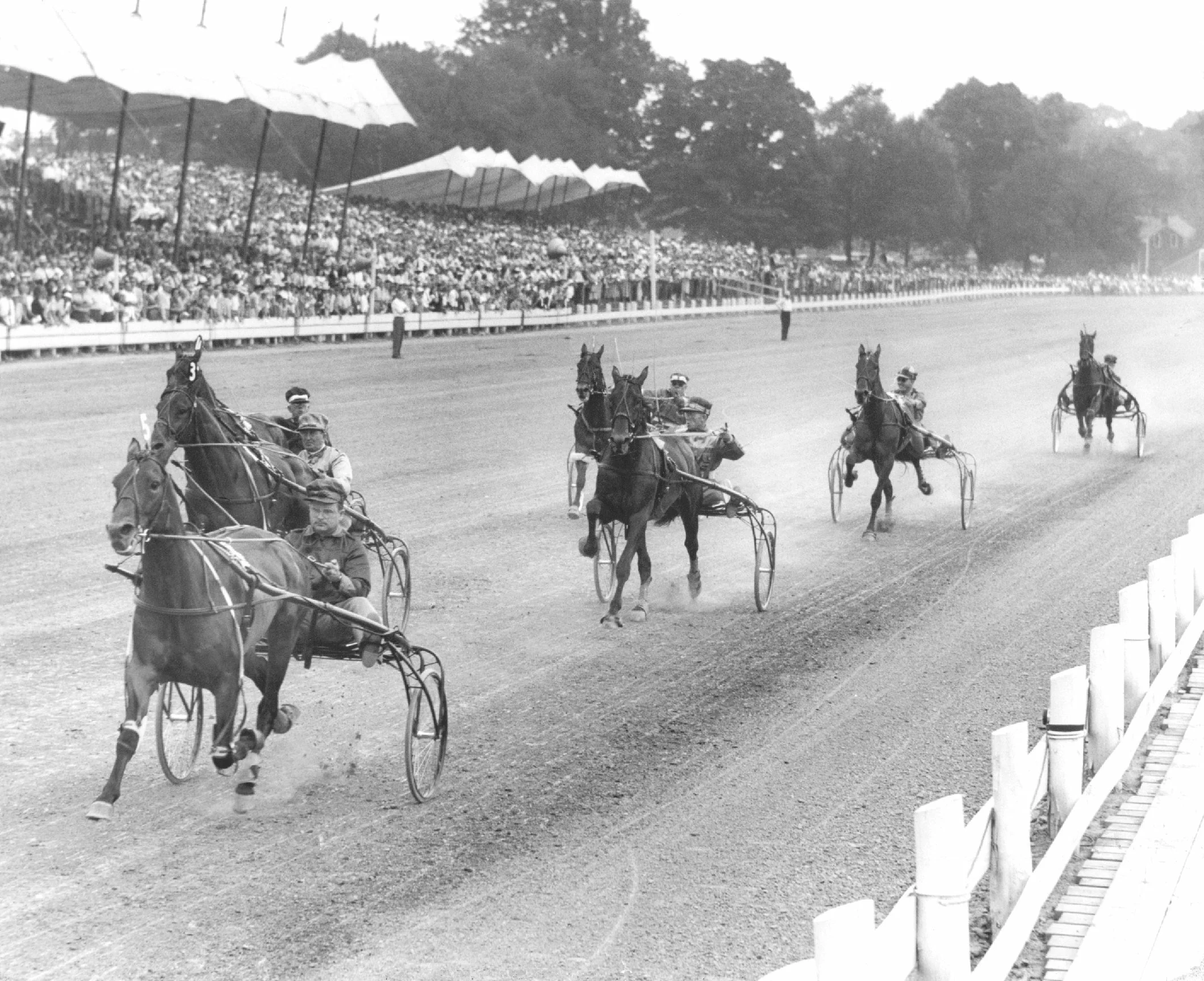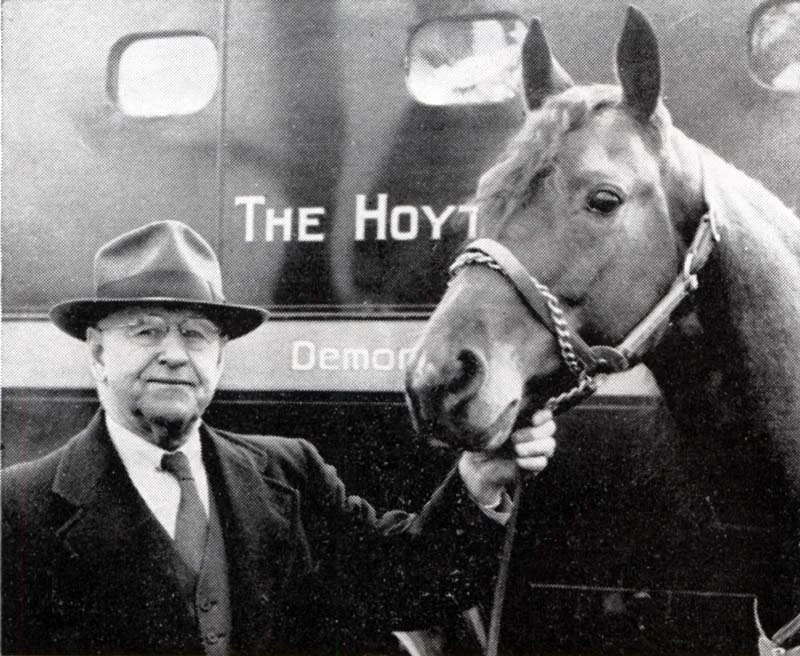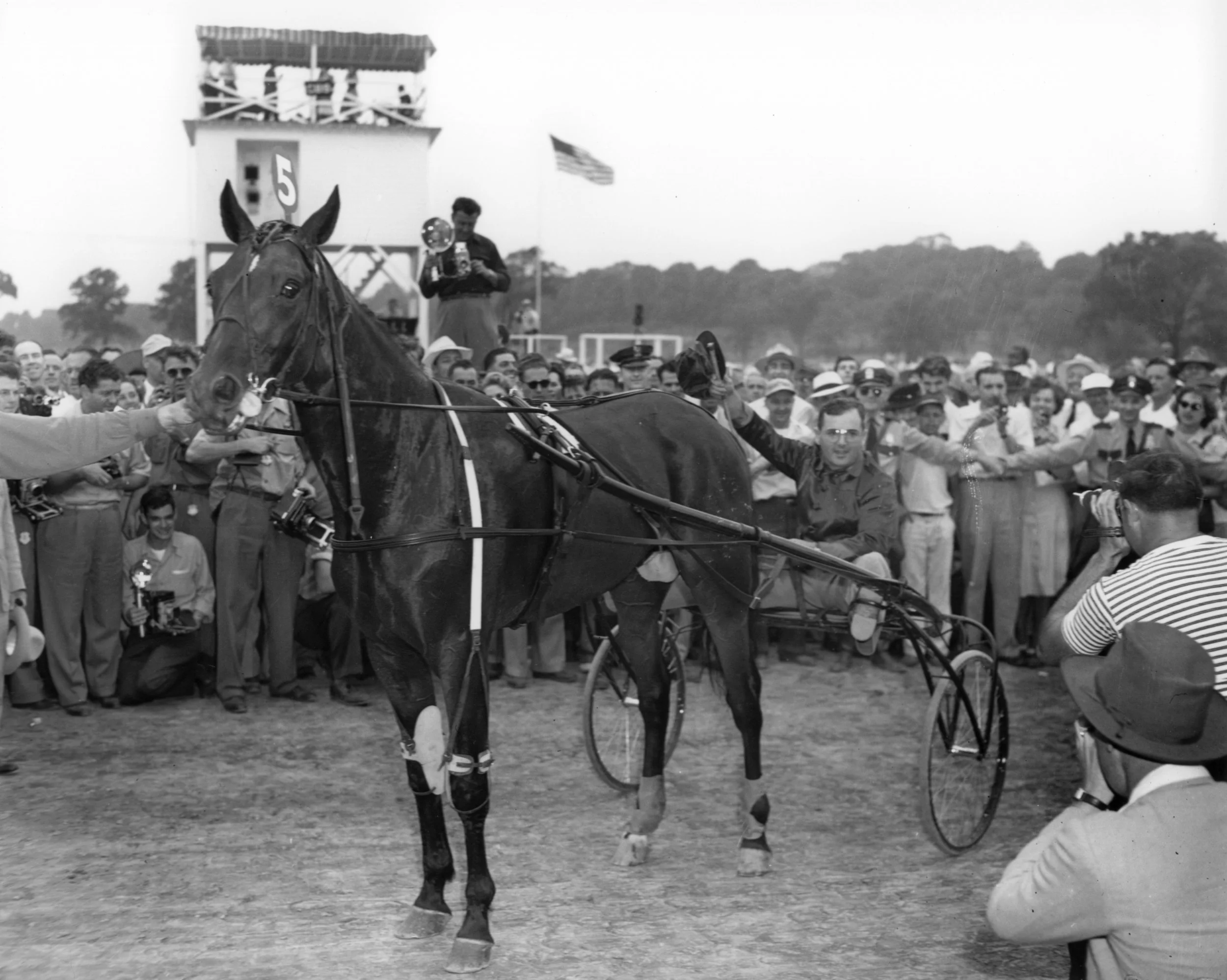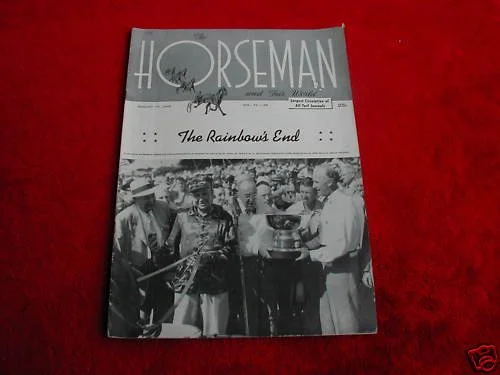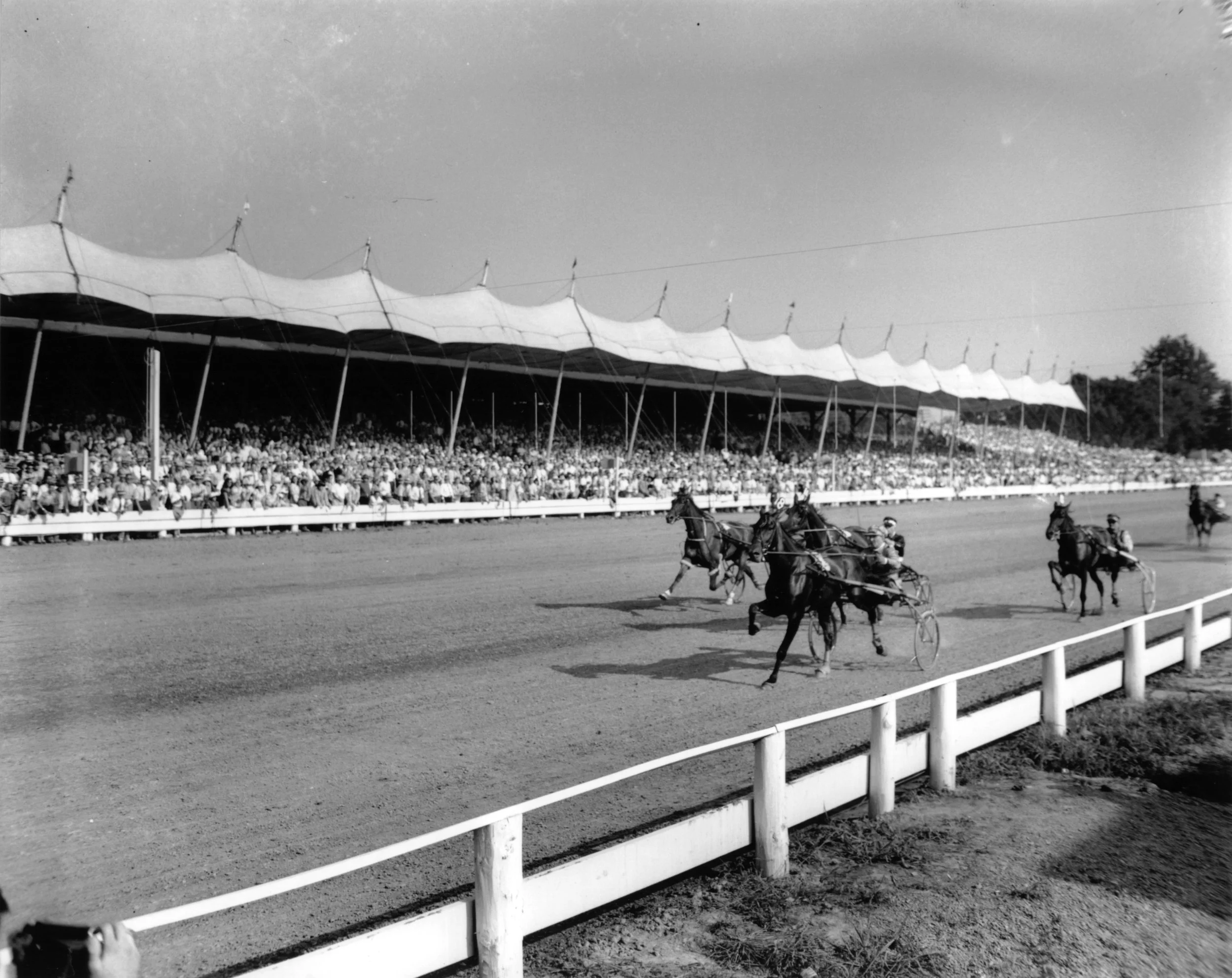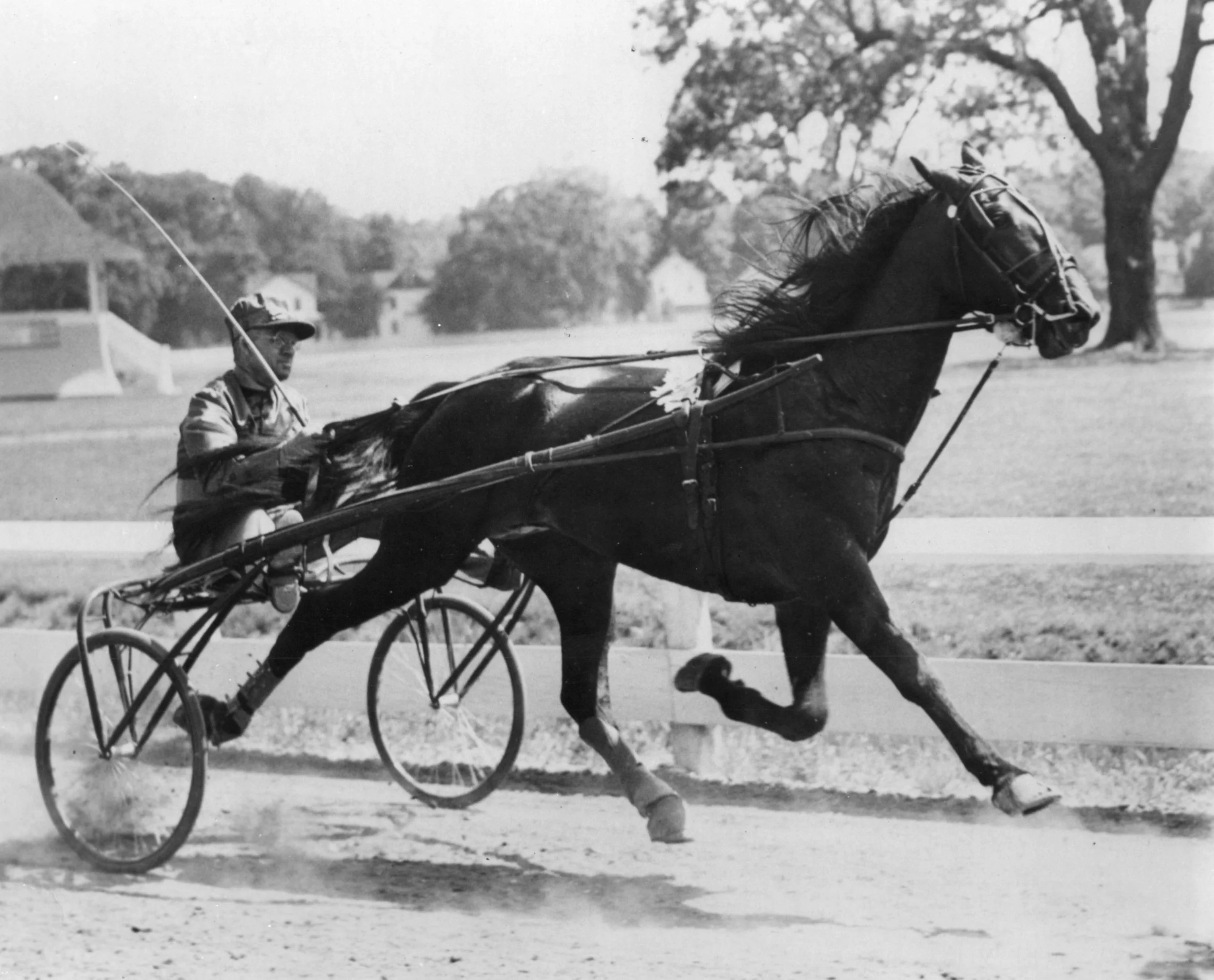Champions |1940-1949
Champions |1940-1949

Worth Waiting For
august 14, 1940
goshen, ny
good time park
Purse $41,958.44
The 1940 Hambletonian was a very popular one among the Grand Circuit regulars and close followers of the sport, as no one deserved a victory more than Charles W. Phellis of Greenwich, Connecticut, and his trainer-driver, Fred Egan. Phellis’ home bred Grand Circuit campaigners had raced to this time with limited success. In this instance, he was racing the handsome black colt, Spencer Scott. Sickness and temporary lameness handicapped the colt at two, but when he attained his form, he was second only to the 1939 champion, Kuno. After a couple of races in which he was a contender, Spencer Scott whipped all the contenders, including Kuno, in the Noyes Stake at Syracuse in 2:05. He won a heat and second money in the rich Horseman Stake and was again a close runner-up to Kuno. At three, Spencer Scott was the king of the crop and won every stake engagement but one in impressive fashion. Spencer Scott was clearly the best in the Hambletonian. Masterfully driven by Fred Egan, the superb black colt set his own pace and held off the stretch drives of Remus and Kuno to win in 2:02 and 2:03, making Phellis, breeder David Look and Fred Egan a happy trio. Retired to Hanover Shoe Farms with earnings of $52,742.66, the young stallion accomplished much before his untimely death at thirteen. His phenomenal son, Rodney 2, 2:02, 1:572, came within a fraction of dethroning his sire, and retired in 1949 as the leading money-winning trotting stallion.
The first winner whose dam was sired by a Hambletonian winner (Spencer, 1928). Phellis convinced David M. Look, owner of Castleton Farm, to breed his mare May Spencer to Scotland (third to Spencer in 1928) by offering to purchase the resulting foal, the future Hambletonian winner Spencer Scott. For the 15th consecutive year, a Kentucky stallion sired the winner. The last year that bookmakers were permitted at Goshen as pari-mutuel wagering was about to be legalized in New York State.
Media
Champions |1940-1949

The TarheEl Terror
august 6, 1941
goshen, ny
good time park
Purse $37,029.86
A relative newcomer to the sport, R. Horace Johnston of Charlotte, N.C. made a very astute and economical buy at the first Standardbred Sale in Harrisburg in 1939, purchasing the Sandy Flash colt, Ashley Hanover, for $1,800. His new owner, a textile manufacturer, changed the colt’s name to Bill Gallon in honor of a friend and turned him over to the soft-spoken Lee Smith for development. Bill Gallon was a top juvenile trotter. Among his wins were the Tompkin Memorial and the Horseman Stake. Bill Gallon was off to a rather slow start at three, sickness and slight lameness halting his progress. In his tune-up start in the Hambletonian Test at Old Orchard, the handsome colt was twice second to Volstadt and then took the third heat in 2:04, beating His Excellency. The Hambletonian of 1941 was a slow race as practically every participant had been ill or off form slightly during the preceding weeks. Added to this, an atrocious barrier start cost Bill Gallon all chances the first heat, His Excellency coasting in with a 2:07¼ clocking. Bill Gallon came back to win the next by a neck from His Excellency with a nicely-timed drive in 2:05 and won the final by open lengths in 2:05½. Retired to stud at his owner’s Whitehall Farm, Bill Gallon had limited opportunities as he was not situated in a busy breeding area. Later moved to Hanover Shoe Farms, he sired one of the outstanding two-year-old trotting fillies of all time, Stenographer.
In a field considered by most, "…weakened by a rash of illness and off form," the first heat, won by His Excellency, a maiden, in 2:07 1/4, was the slowest ever – other than a raceoff. The era of modern nighttime pari-mutuel harness racing began with the opening of Roosevelt Raceway on September 2.
Media
Champions |1940-1949
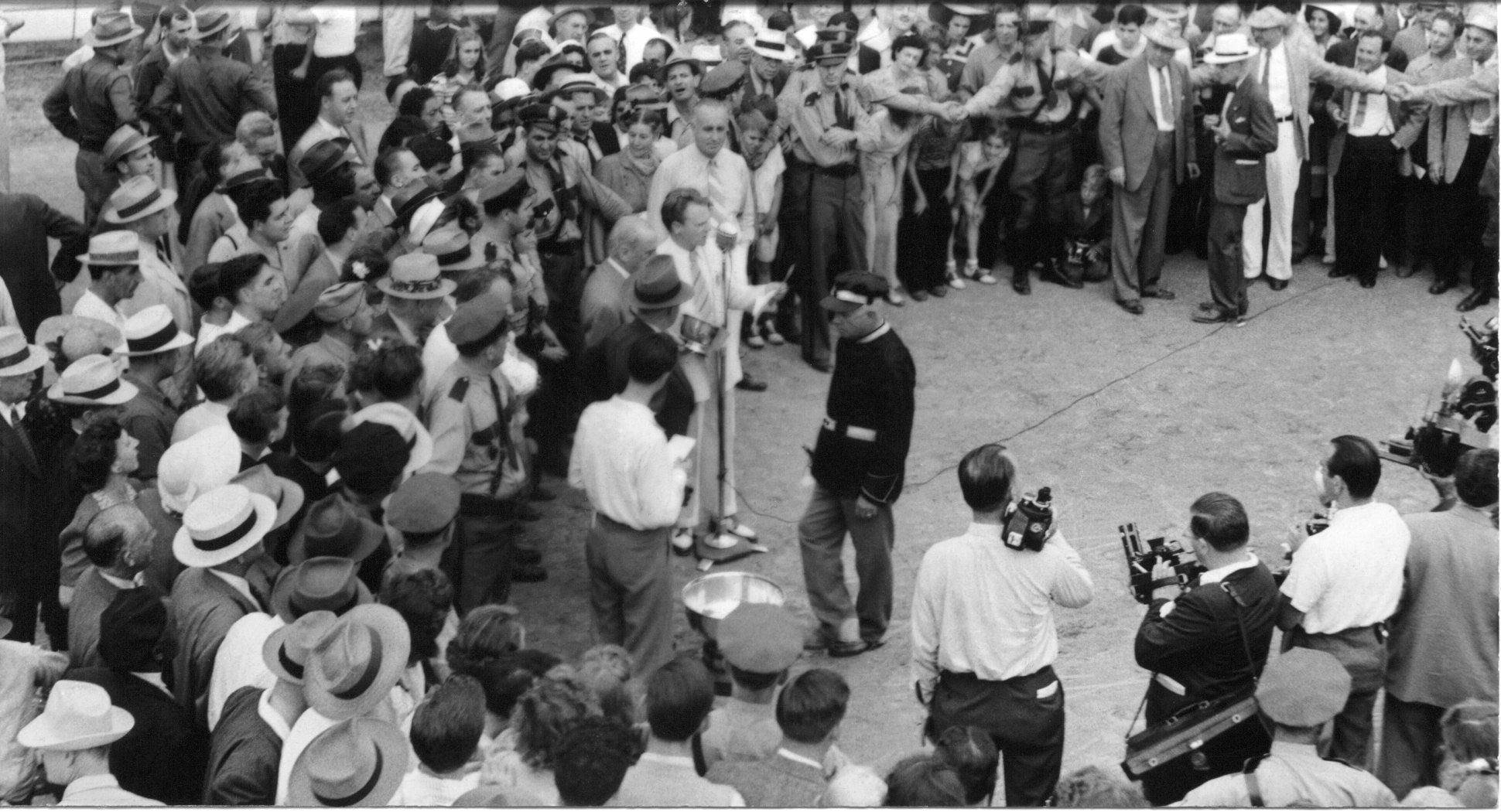
A Surprise Package
august 12, 1942
goshen, ny
good time park
Purse $37,254.48
By all the laws of breeding, The Ambassador should have been one of the most highly regarded of Hambletonian candidates. By the mighty Scotland, sire of two previous winners and champions in Rosalind & Spencer Scott, his dam was Margaret Arion whose previous performers included the champion Protector, the Hambletonian winner The Marchioness, & His Excellency, a heat winner in the Hambletonian. Further, he was trained by the most famed of all developers, Ben White. Still, the high-going colt owned by the popular Bill Strang of Brooklyn, NY, was given little consideration by either the experts or the public.
A few weeks before, The Ambassador had won the first heat of his life in an overnight event at Old Orchard, but it was a major effort for him to trot in 2:06½ over the kite track. The erratic but phenomenally fast Colby Hanover still retained a firm grip on the favorite role, however, for the forthcoming Goshen battle. The 1942 Hambletonian will go down as one of the genuinely wild and woolly struggles, with excitement at its peak as the various participants strutted their stuff in scorching finishes. A combination of bad starting luck and a subsequent exhibition of bad manners eliminated Colby Hanover from all contention, throwing the race wide open. Follow Me, Green Diamond, The Ambassador and Scotland’s Comet were all in the bunch massed at the head of the lane as the final drive began. The sixteenth was a thrilling spectacle as five horses charged to the finish. The photo showed that canny Lee Smith had saved enough ground with Pay Up to get up by inches over Scotland’s Comet on the extreme outside. The second heat again saw little backing for The Ambassador though the Scotland colt had been only a half a length back at the wire. Ben White handled him confidently, going to the top nearing the half and holding sway to the end to win by a length.
The pay-off of $68.20 on The Ambassador was the highest odds ever quoted on a winner to that time. The final showed that the second heat was no fluke, as The Ambassador was cleverly rated until turning for home, catching Scotland’s Comet that had led from the five-eighths to win by two lengths in 2:04. The Ambassador never lived up to his great race again, though a contender in many other stakes. Retired to Peninsula Farm after taking a mark of 2:02, his first crop included a pair of 2:05 three-year-old trotters, but his sale to Sweden ended his American stud career.
One of the longest shots to win the Hambletonian, The Ambassador was 33-1 when he won the second heat. At $3.40 on the dollar in the third heat, he was the third longest priced winner in the final. Only The Intruder ($4.45 in 1956) and Nuclear Kosmos’ dollar odds ($3.50 in 1986) were higher. The Ambassador was a half-brother to 1932 winner The Marchioness. He was the first winner who had not started as a 2-year-old and had only won the first heat of his career a few weeks earlier. Pay Up won the first heat in 2:06 for the same connections as Bill Gallon, the previous year’s winner. Actor Jimmy Cagney presented the trophy.
Media
Champions |1940-1949
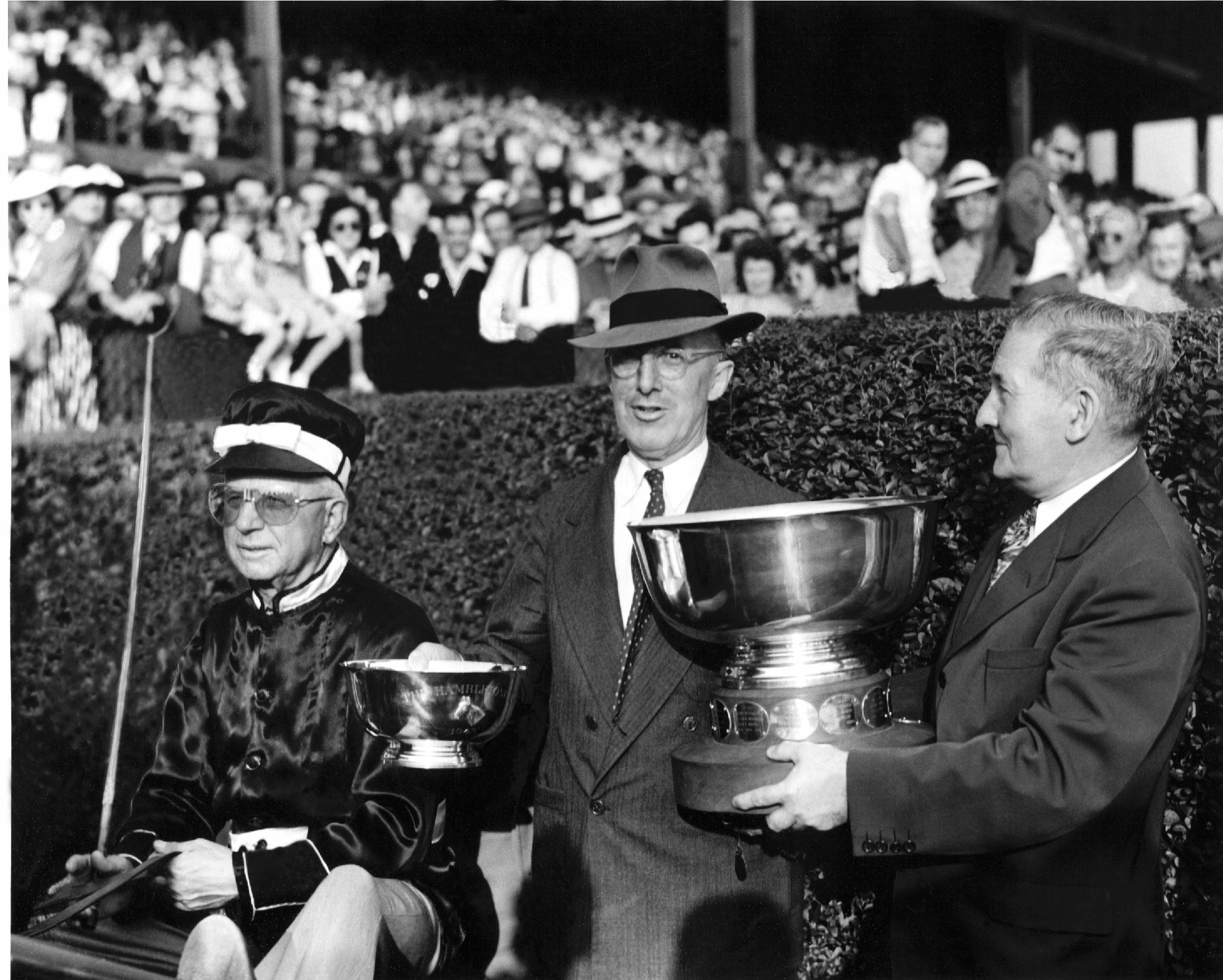
1-2-3 For The Volomites
august 11, 1943
Yonkers, ny
Empire City track
Purse $42,298.03
Volo Song, the champion at two, was favored in the classics at three. The big, brown colt by Volomite out of the mare, Evensong (who had six 2:00 offspring), was a $5,000 yearling purchase by William H. Strang and was turned over to Ben White to drive and train. The 1943 Hambletonian was contested at the slow Empire City running track because of wartime travel restrictions. Volo Song, who had won the Matron, American Stake and Hambletonian Test, broke in the first heat of the Hambletonian and finished third, with Worthy Boy winning the race. But Volo Song rebounded to win the next two, giving Ben White his fourth Hambletonian victory. When Worthy Boy and Phonograph were second and third, respectively, in the summaries, and Gordon Gray was fifth, sons of Volomite finished 1-2-3 and had four of the six purse awards. Sold to E. J. Baker the next season, and campaigned by Harry Fitzpatrick, Volo Song had his career and life cut short when he suffered a broken leg in a race at Elkhorn, WI.
The Hambletonian was moved to the Empire City Track (then a Thoroughbred track, now Yonkers Raceway) because of wartime gas rationing in World War II. The Kentucky Futurity was canceled from 1942 to 1945. W. H. Strang Jr. was the second owner (along with his trainer/driver Ben White) to win back-to-back Hambletonians. Ben White, 70, won his fourth Hambletonian as a driver with a horse considered by many as one of the best of all time. It was also a record fifth training win for the White Stable. The second consecutive year the saletopper at the Walnut Hall Farm won the Hambletonian. The opening heat, won by Worthy Boy in track record time of 2:02 1/2, saw Volo Song trot what many witnesses at the time called the greatest heat ever by a 3-year-old. Volo Song made a break at the start, then rallied to finish a close third, timed around 2:00. Worthy Boy was the first Standardbred acquired by Frances Dodge Johnson (later Frances Dodge Van Lennep) who purchased Castleton Farm in July of 1945. Volomite sired the first three money winners (as well as the fifth money winner).
Media
Champions |1940-1949
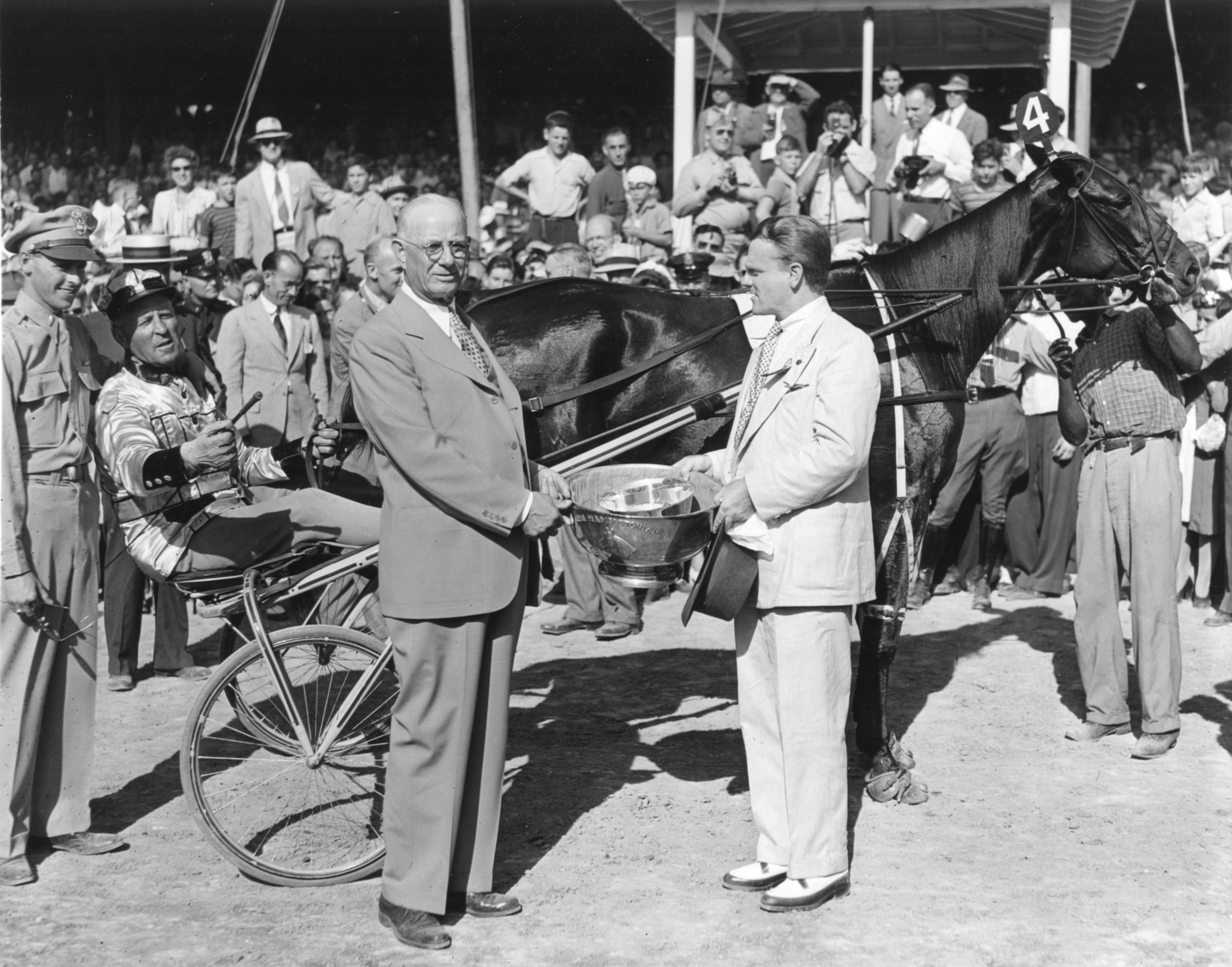
Another for Elizabeth
august 9, 1944
goshen, ny
good time park
Purse $33,577.12
As a broodmare, Elizabeth, by Peter The Great, was already immortalized by her great gelded son, Greyhound (1:55¼) and in Yankee Maid she had a second Hambletonian winner, sharing that feat with Margaret Arion. Purchased from Almahurst Farm by owner A. L. Derby of Wichita, Kansas, for a modest sum, Yankee Maid was lightly-raced at two. But she set a world record for two-year-old trotting fillies on a half-mile track of 2:06 3/4 and clinched juvenile honors with a race-off win at Lexington. Triumphs in the Matron, Stallion Stakes at North Randall and the National Stake, preceded her two-heat win in the Hambletonian, the third for driver-trainer Henry Thomas.
Yankee Maid was a half-sister to Greyhound (1935). Elizabeth, the dam of Yankee Maid and Greyhound, was by Peter The Great who is the leading broodmare sire of Hambletonian winners. By Volomite, Yankee Maid was the 12th of Elizabeth’s 16 foals. Fillies were 1-2 in the first heat and in the summary. Emily Scot, the second filly, was the dam of 1958 winner Emily’s Pride and the granddam of Noble Victory, the favorite in 1965. Yankee Maid’s caretaker, "Jimtown" Burbage, enjoyed a career association with champions. He also reportedly groomed Dark Rex, a three and five-gaited American Saddlebred champion, and 1933 Kentucky Derby winner Broker’s Tip. Hollywood star Jimmy Cagney presented the Hambletonian trophy as he had done in 1942. Thomas’ son Dick, a respected horsemen in his own right, recalled that his dad trained some horses for Cagney in California, and that Cagney and Broderick Crawford, who were great friends, would come out to the track and join the family in their box at Santa Anita.
Media
Champions |1940-1949
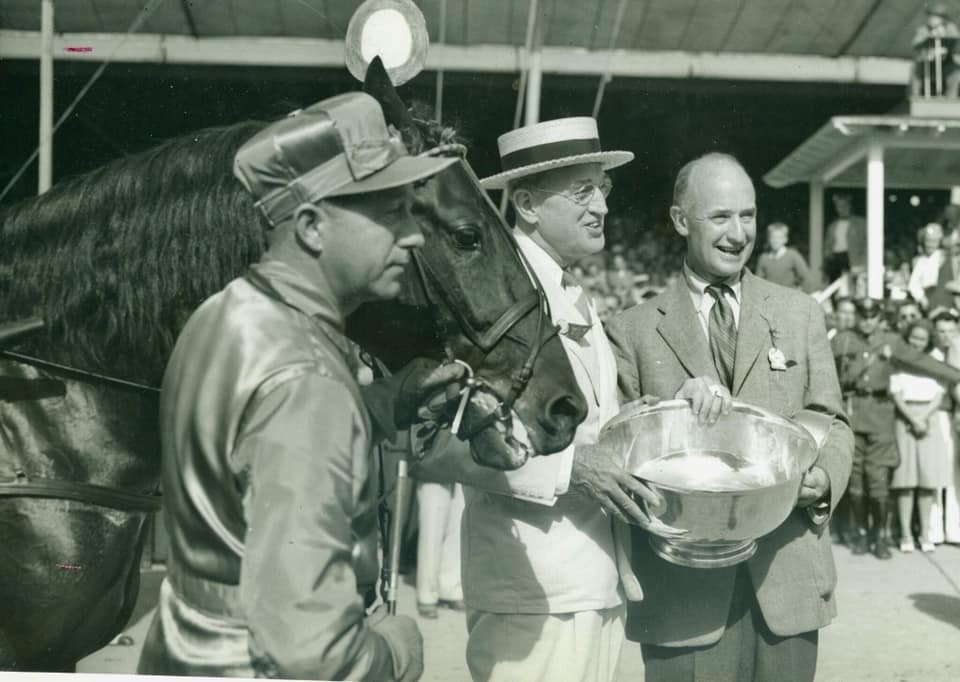
The Little Giant
august 8, 1945
goshen, ny
good time park
Purse $51,046.96
Short in stature but long on power and speed, Arden Homestead Stables’ Titan Hanover stood out as champion two- and three-year-old trotter. His mile in 2:00 at Lexington as a two-year-old slashed two full seconds off the juvenile standard, marking a milestone in harness horse history. Trainer Harry Pownall deserved full credit for the career of the "Fightin’ Titan" as he was a handful to break and train. Titan Hanover worked a mile at Roosevelt Raceway in 2:07¼ before going to the races. At Old Orchard, he split heats in his debut, tying for first with the fastest mile in 2:08½. Next he took the National Stake, the Tompkins Memorial at Goshen, the Harriman Challenge Trophy and the Horseman Stake and the Reading Futurity in the mud at Trenton. In his Lexington race he set a two-heat standard of 2:02¾, 2:02¾, timed better than 2:02 one trip. Then came an assault on the clock, the quarter in :29¼, the half cyclonic in :58¾, three-quarters in 1:29½, the mile achieved in 2:00. Again at three he was unbeaten, winning the Stallion Stake and the Matron Stake with ease. The $51,046.96 Hambletonian was next and Titan Hanover delivered easily according to expectations, though Axomite made it interesting for a few strides nearing home the first trip. Titan Hanover was an outstanding performer again at four and five, and retired to stud at Hanover Shoe Farm.
Hometown favorite Titan Hanover was the only horse ever barred in the Hambletonian wagering pools, in spite of the fact that he started as number 12, the fifth horse in the second tier, in the first heat. A total of 19 horses started the first heat, in three tiers scoring seven across. Despite the fact that Titan Hanover prevailed by only half a length in the initial heat, he was still barred in the final. The respect was well deserved as "Mighty Titan", by the end of the year, held both the two-year-old and the three-year-old mile as well as half-mile track world records. There were no five-eighths mile tracks in the North America at the time. Titan Hanover was one of nine winners that sired one or more Hambletonian winners: Hoot Mon (1947); Speedy Scot (1963); Ayres (1964); Nevele Pride (1968); Speedy Crown (1971); Super Bowl (1972); Green Speed (1977); and Speedy Somolli (1978).
Media
Champions |1940-1949
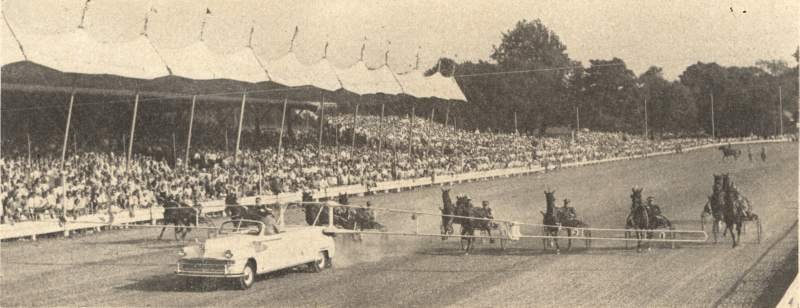
Luck Was With Him
august 8, 1946
goshen, ny
good time park
Purse $50,995.97
On the eve of the 1946 Hambletonian, William H. Cane sold Chestertown, a $6,500 yearling, to Walter E. Smith of Los Angeles for $40,000 after he defeated Victory Song in the National Stake. Smith turned the Volomite colt over to Tom Berry. In the first heat, Sep Palin scored with Victory Song by two lengths over Chestertown, but in the second heat, Don Scott struck Victory Song’s Wheel, causing a break. Chestertown went on to win the heat in 2:02½ over Deanna. In the final, Victory Song made a gallant try to catch Chestertown, but Berry kept his colt in front by a half-length in 2:03¼. Chestertown retired in 1950 with $108,864 in earnings, standing at stud at the Village Farm in Langhorne, Pennsylvania for one season, and then moved to Bonnie Brae Farm in Ohio.
Harry Whitney, who had trained Chestertown until the day he was sold to Smith, finished fifth driving Westfield Girl. The previous year he was second with Kimberly Hanover (6-2). It was Whitney‘s best finish in 12 races, including eight years (1939-1946) which, at the time, was a record for consecutive Hambletonian drives. He never won a Hambletonian. It was Delvin Miller’s first starter in a record 26 Hambletonians (27 horses). His charge, Don Scott, finished fourth overall in the placing. Van Riddle, driven by owner Earl Rowe, was the first Canadian-owned horse to start in the Hambletonian. As reported in a trade magazine, the Hambletonian received coverage on television for the first time. It was possibly local and not network coverage, although the newsreels of the day recorded the event for the theater audience. The first year that the modern Steve Phillips starting gate was used to start the Hambletonian.
Media
Champions |1940-1949
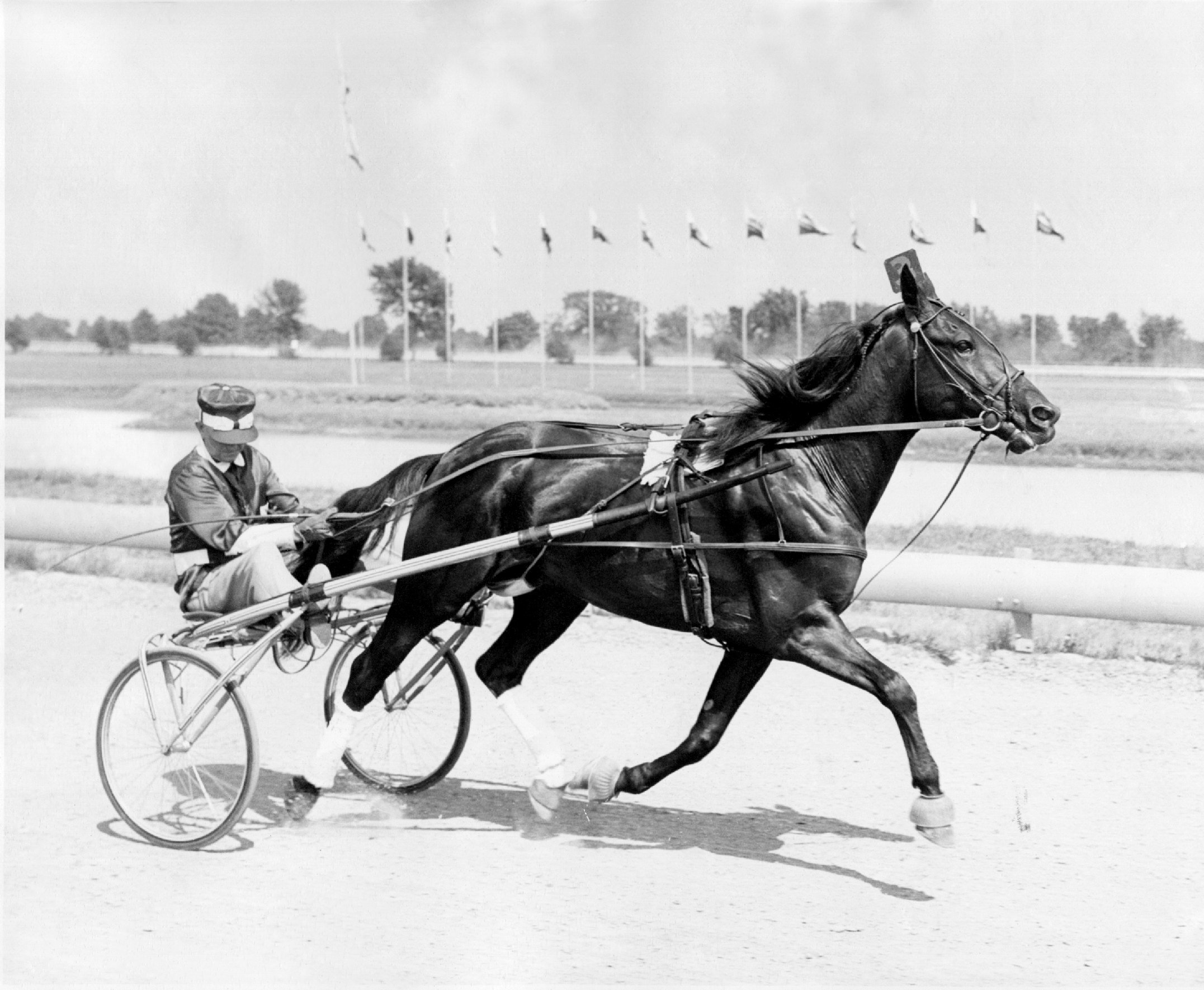
The Rugged Black Colt
august 6, 1947
goshen, ny
good time park
Purse $45,417.93
Hoot Mon, holder of the 2:00 record for the Hambletonian was twice sold for $50,000: first by his breeder, Charles W. Phellis, to Castleton Farm, then a year after his Hambletonian victory, for the same amount to Hanover Shoe Farms where he stood at stud. In the hands of Fred Egan, Hoot Mon made his modest debut at Old Orchard, Maine. An impressive second to heavily-favored Rodney in the Tompkins and wins in the American Stakes at Milwaukee and the DuQuoin Stakes led to his sale to Castleton. The duel with Rodney resumed in Lexington with Hoot Mon prevailing. At three, Hoot Mon won a $3,000 stake in California early, then was injured when shipped East. He finished second to Rodney on June 20, and didn’t race again until the Hambletonian. Master horseman Sep Palin brought the colt back from lameness and layoff for the Hambletonian. Rodney took the opener in 2:012, Hoot Mon a fast-closing second. The next mile, Hoot Mon was away a bit slowly, Rodney setting a swift pace. Leaving the half, Hoot Mon moved up and outdrove Rodney in the stretch to win by two lengths in the official time of 2:00. Palin timed his colt in 1:593. The final was clinched by Hoot Mon in 2:021 handily. Thereafter, the black colt won the American Stake, the DuQuoin Stake, and the $36,905 Kentucky Futurity to wind up a career in which he earned $74,950. His first crop appeared at the races in 1952 and they proceeded to set marks from the word go. His eleven trotting winners, seven in 2:10, set an all time mark for the first crop by a trotting stallion and their winnings totalled $132,667.58.
The second heat was the first 2:00 mile in the Hambletonian; Palin claimed to have timed his colt in 1:59.3. The first of three black horses to win. Purchased by Castleton Farm (Frances Dodge Johnson & her husband, James B. Johnson) during his 2-year-old year for $50,000, Hoot Mon was sold again for the same price to Hanover Shoe Farm at the end of his racing career. Hurt during a shipping accident, Hoot Mon did not start in the six weeks before the race. The Smith starting gate was used to start the field. The Smith gate ran on a track along the inside rail. It was eventually abandoned by the harness industry. Victory Song, a heat winner of the previous Hambletonian and second overall, was selected the first Harness Horse of the Year in a poll of 50 sports editors, harness writers and radio commentators. The Trotting Horse Club of America sponsored the poll. Coincidentally, in 1948, Rodney, a heat winner and runner-up in summary of the ‘47 Hambletonian won the second annual Horse of the Year honor.
Media
Champions |1940-1949
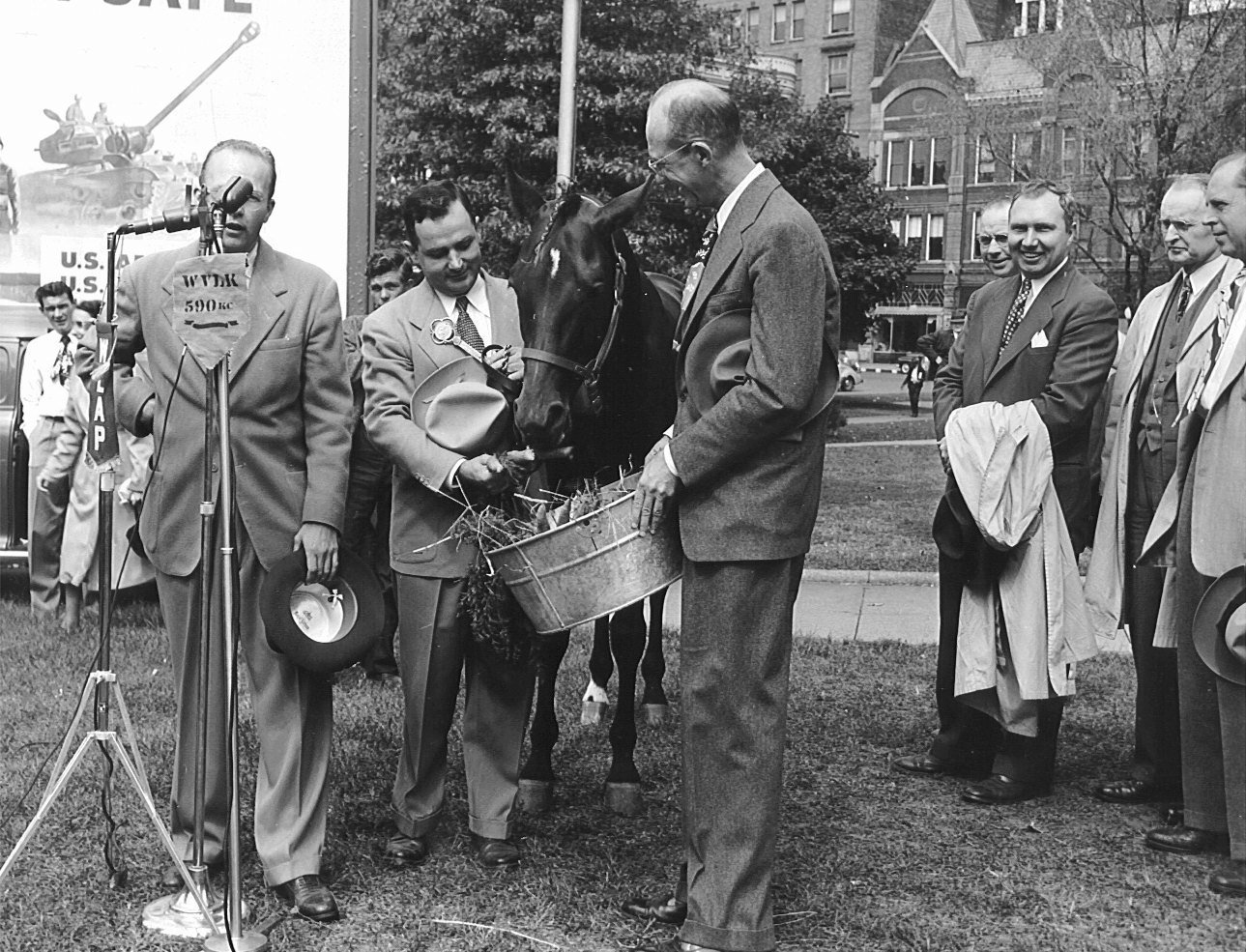
The Amateur Touch
august 11, 1948
goshen, ny
good time park
Purse $59,262.37
HOW THE BIG RACE WENT
Trackside View of The Hambletonian
by HOWARD DeFREITAS
A TWENTY‑THIRD NAMEPLATE has been affixed to a great silver bowl. Freshly engraved, it glistens among an array bearing the names of Guy McKinney, Spencer, Hanover's Bertha, Greyhound, Rosalind, Spencer Scott, Bill Gallon, Volo Song, Titan Hanover, Hoot Mon and twelve others who have gained immortality in the trotting world by capturing the most coveted of all harness races, the Hambletonian. And even if this latest trotter to get his name on the Hambletonian trophy never wins another race, his right to join such a select group will go unchallenged. For, in winning the 1948 Hambletonian Stake before more than 20,000 cheering fans at Goshen's Good Time Park on August 11, Demon Hanover left no doubt about his being a truly outstanding colt trotter.
Before the Goshen classic, there were more than a few who had some qualms about the trim little son of Dean Hanover, 3, 1.581/2 and Sorceress 2.13. Some said he was too small, his legs too slight. Others said he wouldn't hold up against real top‑flight opposition. Finally, there were many who were sure that he'd never win the Hambletonian, if for no other reason than he had an amateur trainer and driver.
That was before the Hambletonian.
Today, most horsemen are confident that Demon Hanover will be a two‑minute performer by the end of the season. What they saw him do in the Hambletonian was more than sufficient to prompt such a prediction. To put it plainly and simply, Demon won the race looking for horses, with miles in 2.031/5 and 2.02. Certainly, 38‑year‑old Harrison R. Hoyt of Bethel, Conn., the man who shares ownership of the colt with his wife and who has trained and driven him from a twoyear‑old, was looking for horses, even if, strictly speaking, Demon wasn't. Several times during the race, Hoyt turned around to see if there was any need for greater speed. There never was, for Demon led from wire to wire in both trips and never once encountered a serious challenge. He took the first heat by a length and a half and triumphed by two in the clincher.
In winning and taking down $32,500.15 of the third largest Hambletonian purse—$50,941.18—Demon Hanover vanquished the cream of the current crop of three‑year‑old trotters and did it with apparent case. It was the first time he had encountered such highly‑regarded colts as Rollo, Egan Hanover and Madison and his first meeting, too, with fast fillies like Adeline Hanover and Mercy Abbey. These five and five others who made up the Hambletonian field all fell victim to Demon's flying hoofs.
Rollo, pride of the Coldstream Stud, Lexington, Ky., and original winter‑book choice for William H. Cane's big event, made his first start of 1948 and did well, but not well enough to lick Demon. With Tommy Berry up, he finished second in both miles and so earned second money of $11,818.24. Rollo had trained in grand style for the race, matching Demon with a 2.03 work‑out mile just eight days before the Hambletonian. If Demon hadn't been around on the afternoon of the race, Rollo unquestionably would have been the victor. Unfortunately for Rollo, Berry and those who made the colt the second choice in the parimutuels, Demon was too much in evidence.
Third horse in each heat and in the summary was the Saunders Mills colt, Egan Hanover, full brother to Rodney 1.58. The son of Spencer Scott 1.571/4 and Earl's Princess Martha, 3, 2.013/4 perhaps was a slight disappointment to some observers who bad expected the big fellow to come pounding home on top with the same decisiveness that be had at Santa Anita and Fairmount Park earlier in the campaign. He went a good race, though, and enabled his owner, C. M. Saunders, to pocket $7,090.94.
A little on the surprising side, and a happy turn of events for sixteen-year‑old Mary Lou O'Connor of Warwick Downs, R. I., was the 5‑4 standing of Jeff Hanover, which earned fourth money of $3,545.47. Frank Safford had the mount behind Jeff, who became the property of Mary Lou at the Harrisburg sale last fall. Fifth money went to Bill Strang's Madison Hanover, the Brooklyn hope. Ben White, only fourtime victor in the classic, got Madison going in high over the last half of the first heat and it was the fourth place be gained with this spurt that put him in the chips for he was tenth, due to an early break, in the final trip. Thus did Mr. Strang collect $2,363.65.
The sixth and final prize of $1,772.73 was garnered by W. N. Reynolds' Judge Moore. The redoubtable Judge, with Del Miller in the seat, got off well in both miles and managed to get in the money bracket with a 6‑5 standing.
Though Demon's victory required no great display of driving skill on the part of Hoyt, it was agreed by those who think about such important matters that the very manner in which the colt sped away from the pack in each heat was a tribute to the young amateur's ability as a trainer. That Hoyt had done his bit to produce such excellent manners and to have the colt in such perfect shape for the race, there was no question. From all indications he did very well and particularly so for a man who never drove in a harness race until four years ago. He rated his charge perfectly in both miles and sat with a stillness usually found only in a professional. As the first amateur to win the Hambletonian, he acquitted himself well.
In the first heat, Demon raced to the front as they headed for the lower turn with Judge Moore and Jeff Hanover right behind him. Egan Hanover and Rollo, who encountered a little delay in the turn, quickly moved into contention as they straightened out going up the long stretch past the quarter toward the half. Madison Hanover was sixth behind Rollo as they passed the quarter. Approaching the half, Ralph Baldwin pulled Egan out, passed Jeff Hanover and Judge Moore and then dropped into the number two hole.
Rollo and Madison didn't begin to make their moves until after the half had been passed in 1.023/5. They made up ground rapidly and at the three‑quarter pole, which Demon hit in 1.332/5, Egan was still second, but Rollo was third, Judge Moore fourth and Madison fifth with Jeff dropping back to sixth. Rollo continued to come as they headed for home and passed Egan half‑way through the stretch. But there was no nabbing Demon. Egan made a break right at the wire but took third with a little to spare from the flying Madison. Meantime, Judge Moore faded to sixth as Jeff Hanover came on to be fifth. The mile was in 2.031/5, with the final quarter in 294/5 seconds.
Rollo and Egan Hanover had every chance to challenge Demon in the second heat, but they just couldn't get to him. Egan trailed the leader most of the way with Rollo a close third. Rollo again passed Egan in the stretch, but Demon stayed beyond reach as be negotiated the, 2.02 mile handily.
A disappointment in the race was T. J. Zornow's Adeline Hanover from Pittsford, N. Y. This filly who behaved so well and looked so smart in capturing the rich Coaching Club Oaks earlier in the year, made breaks at the start of both miles, and Gib White' her popular trainer‑driver, never had a chance to get in the thick of things.
So the 1948 Hambletonian Stake now belongs to history. Another great three‑year‑old trotter has joined the long list of winners, and another driver has accomplished what every reinsman in racing dreams of doing before be dies.
Media
Champions |1940-1949
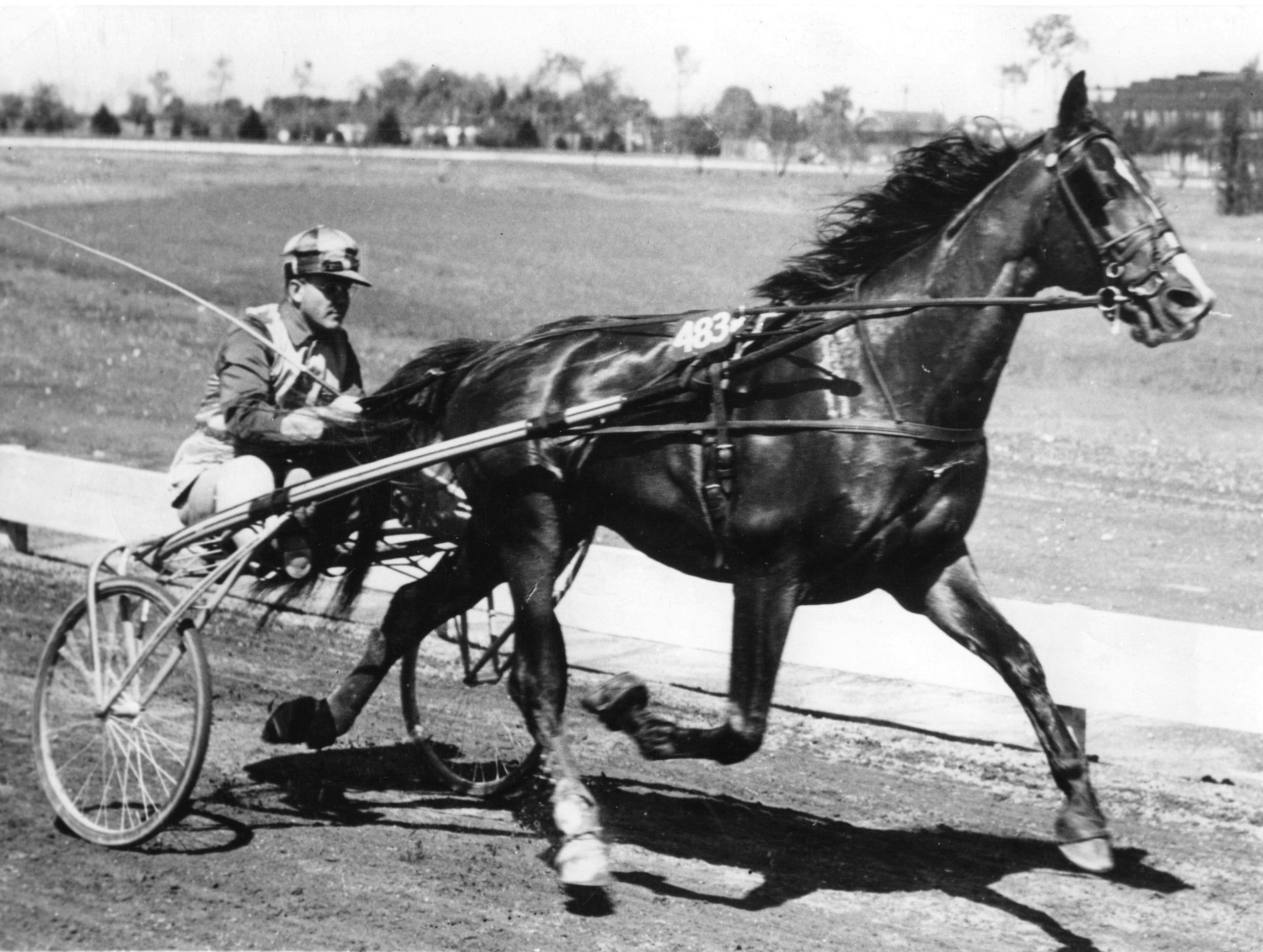
Phellis + Egen again
august 10, 1949
goshen, ny
good time park
Purse $68,395.26
After a sensational two-year-old career, Miss Tilly was a disappointment at three until she reached Goshen for the 24th Hambletonian. Driven by Fred Egan, well into his 70s at the time, Miss Tilly was bred and owned by Charles W. Phellis of Greenwich, Connecticut, who had previously won the 1947 Hambletonian with Hoot Mon. The Nibble Hanover filly, who earned nearly $50,000 as a two-year-old, scored out of the second tier for the first heat. Egan rated Miss Tilly back to fifth or sixth while her stablemate, Saint Clair, was hustled to the top. The favored Bangaway circled the field and led momentarily near the quarter, but jumped. Just after passing the half, Egan pulled Miss Tilly and she trotted to the lead. Miss Tilly hung on down the stretch as Tom Berry challenged with Volume. The filly’s victory was a long neck in a time of 2:03. The final was a rout as Miss Tilly went to the top at the quarter and pulled away, winning by five in 2:012, then the fastest clocking for a filly.
One handicapping sheet correctly predicted, "Bangaway may be the choice of millions but DON’T MISS TILLY!" despite the fact that it was her first win of the year – in straight heats – and she never won another. The time of the second and final heat of 2:01.2 was the fastest mile ever to date by a filly in the Hambletonian and was second only to Hoot Mon’s 2:00 stakes record. Tilly Tonka, the dam of Miss Tilly, was also the granddam of Hoot Mon (1947). Phellis, considered by many to be one of the foremost experts on Standardbred breeding bred both Hoot Mon and Miss Tilly. From a relatively small band of mares, he also bred the 1958 winner Emily’s Pride and, as mentioned above, suggested the pairing that produced Spencer Scott (1940). Nibble Hanover, the sire of Miss Tilly, was the only stallion to produce a Hambletonian winner and a Little Brown Jug winner (Knight Dream, 1948). Ben White drove in his last Hambletonian at age 76. His horse William Wells finished 7-11. For an unprecedented third time, a horse owned by Coldstream Stud of Lexington, KY finished second. 1934, Coldstream (operated by C. B. Shauffer of Chicago and later by Dale Shauffer of Detroit) never won a Hambletonian and holds the distinction as the owner who finished 2nd the greatest number of times without winning. The farm is now a part of the University of Kentucky. Hall of Fame of the Trotter (later renamed the Harness Racing Museum & Hall of Fame) was founded in Goshen, NY. May 5th marked the 100th anniversary of Hambletonian 10’s foaling near Sugar Loaf, NY.
Media
Champions |1940-1949

